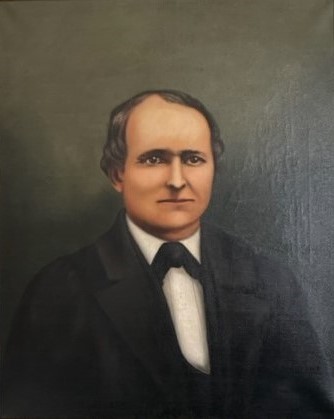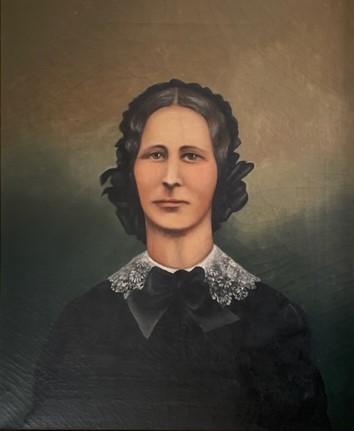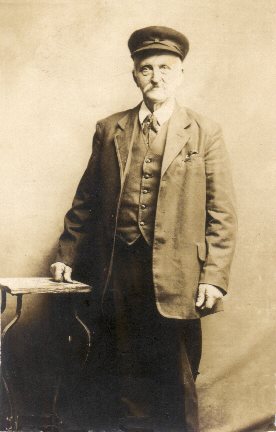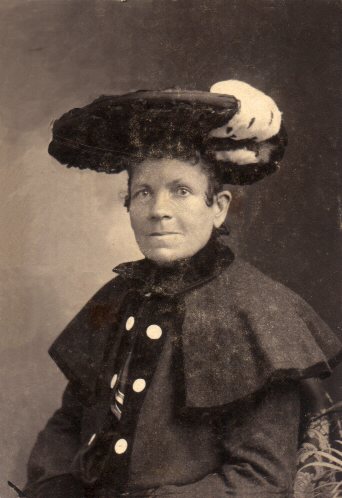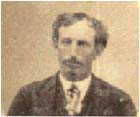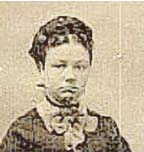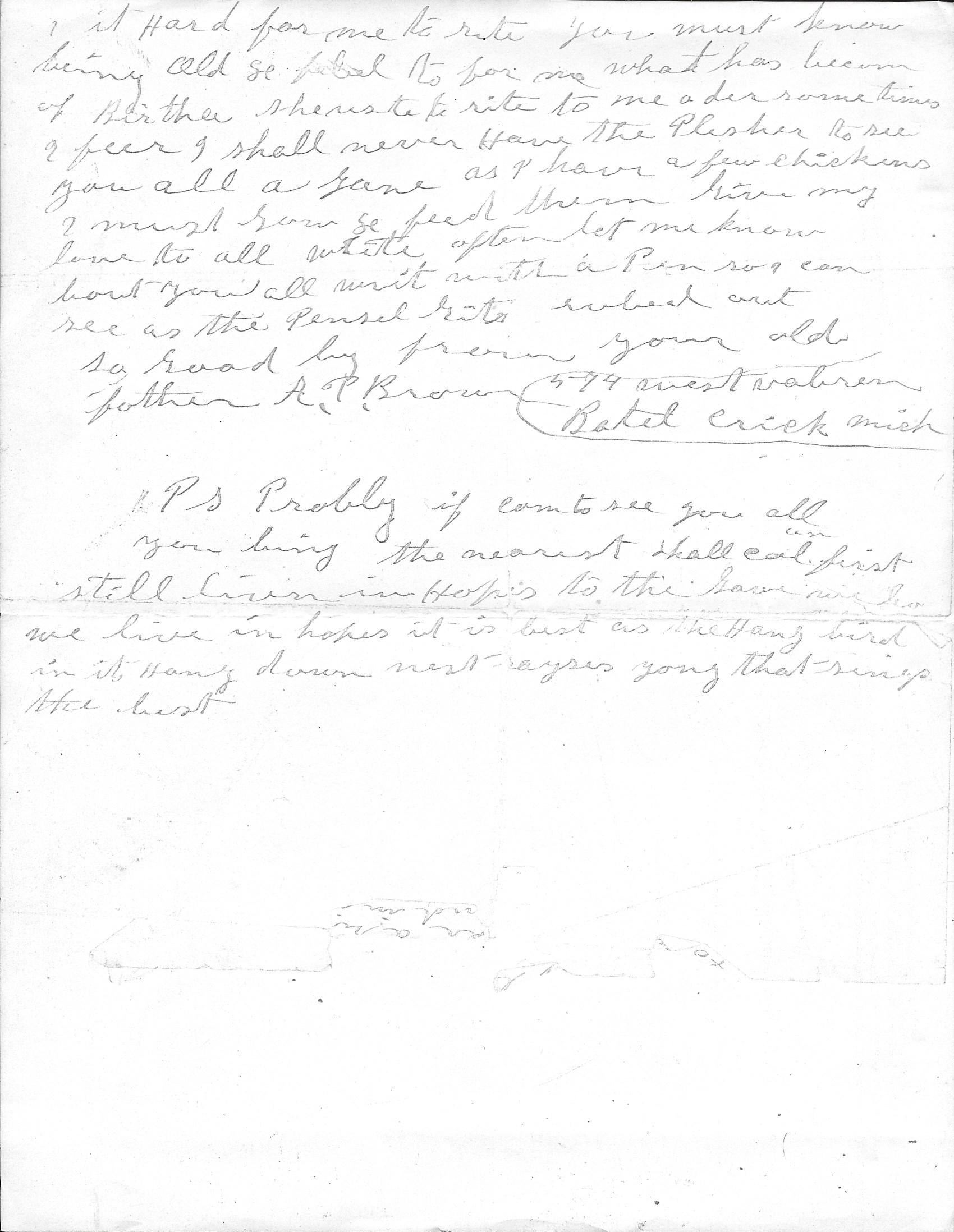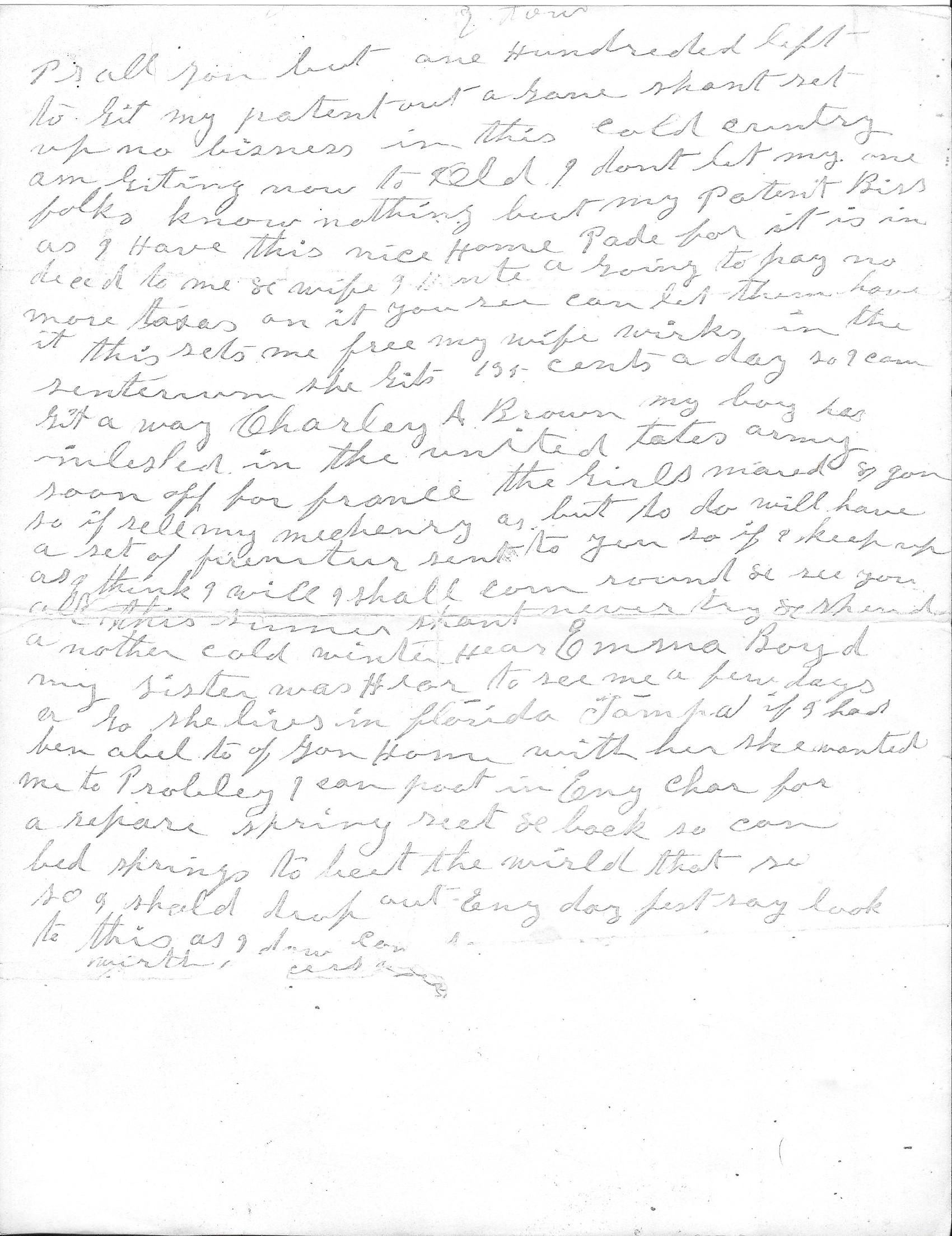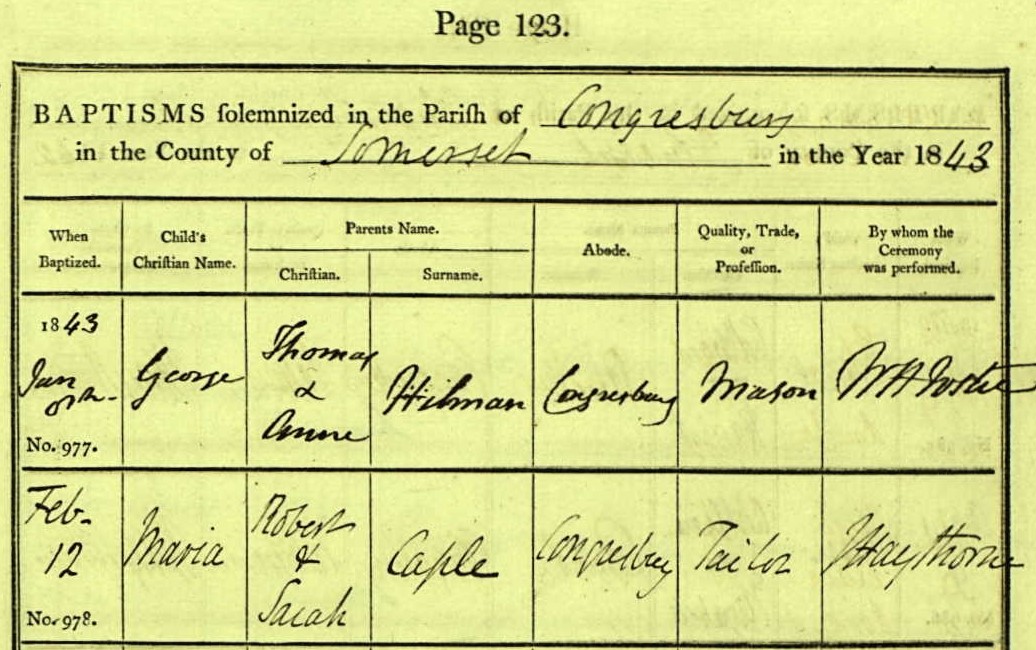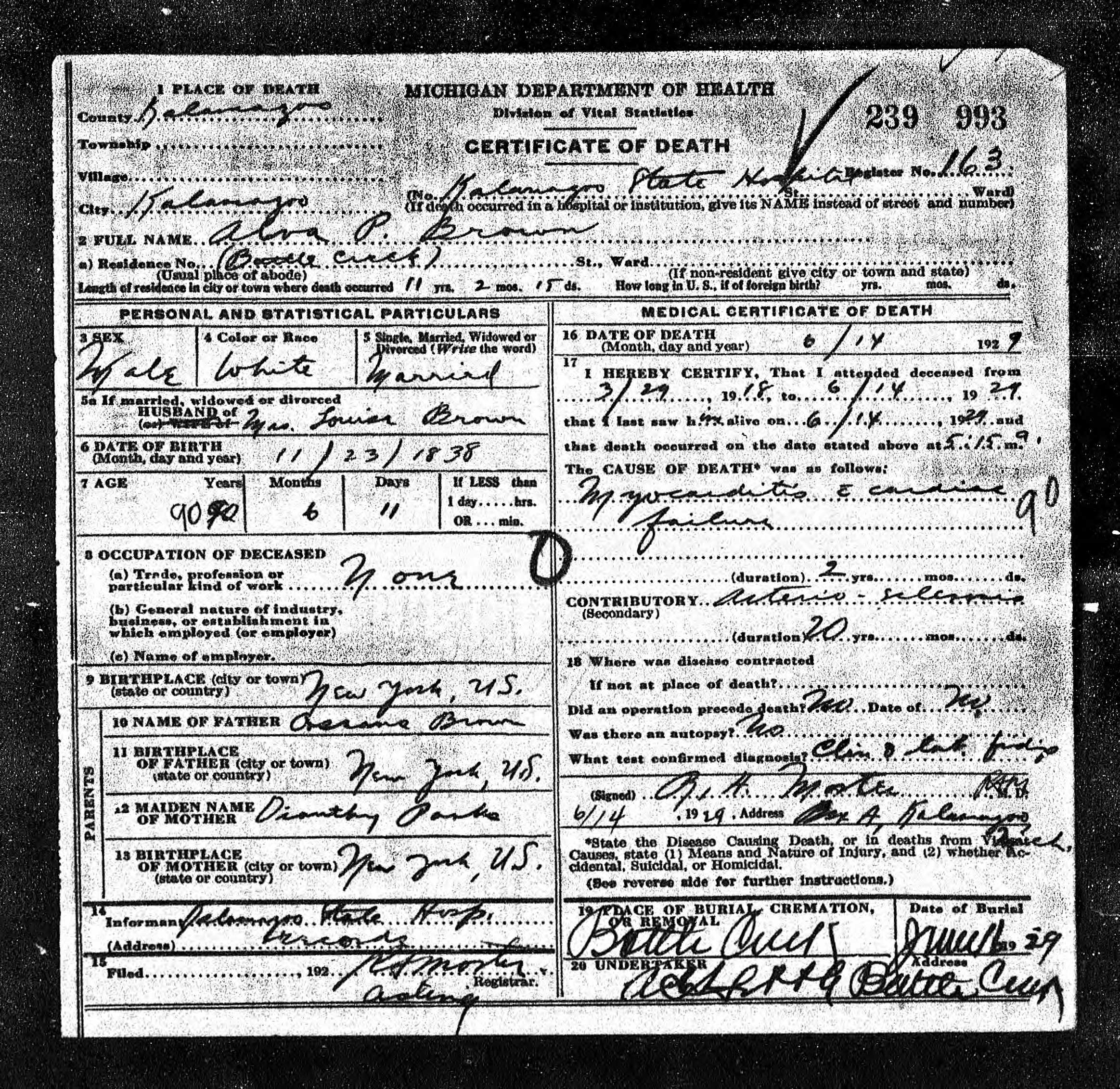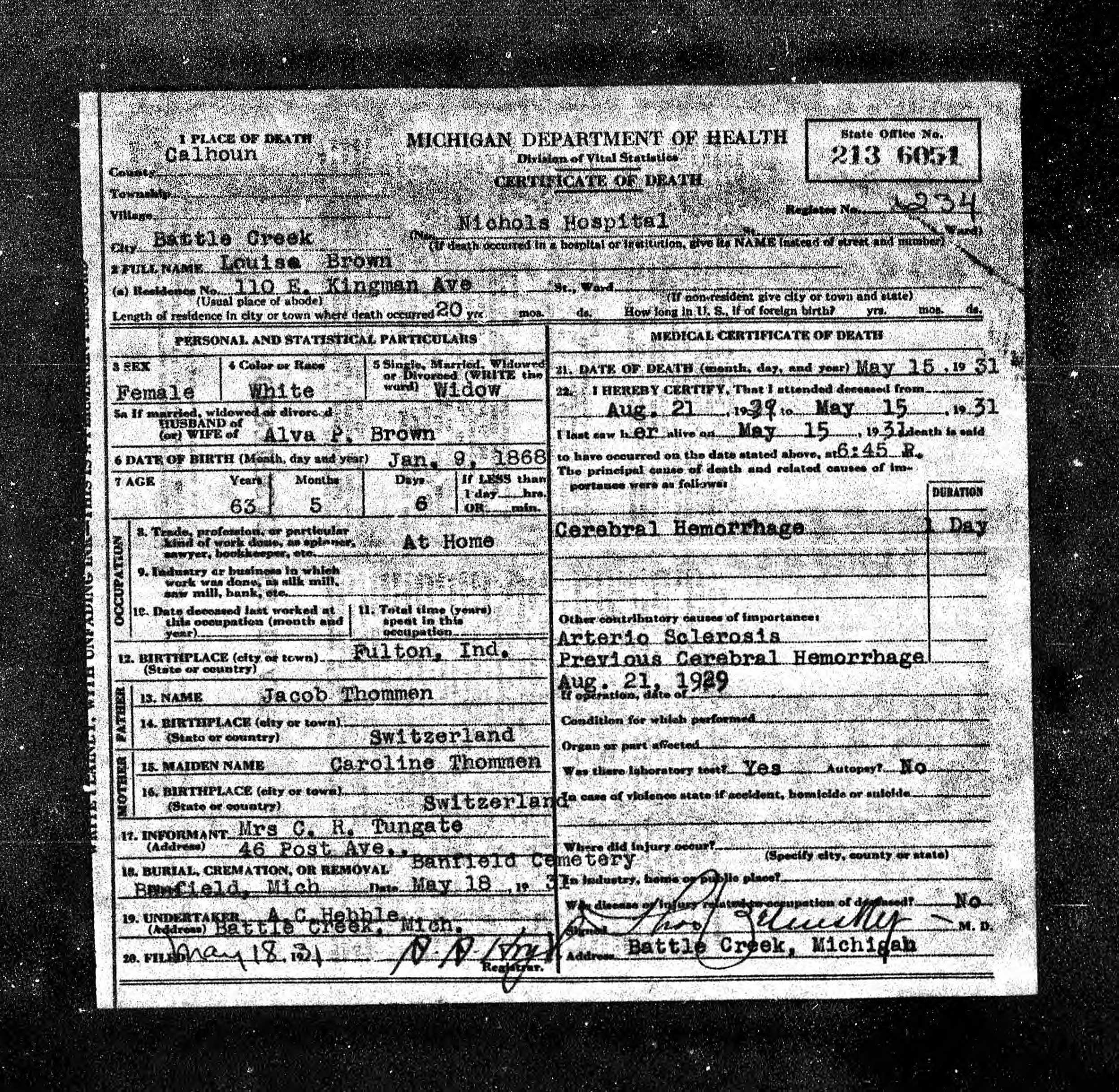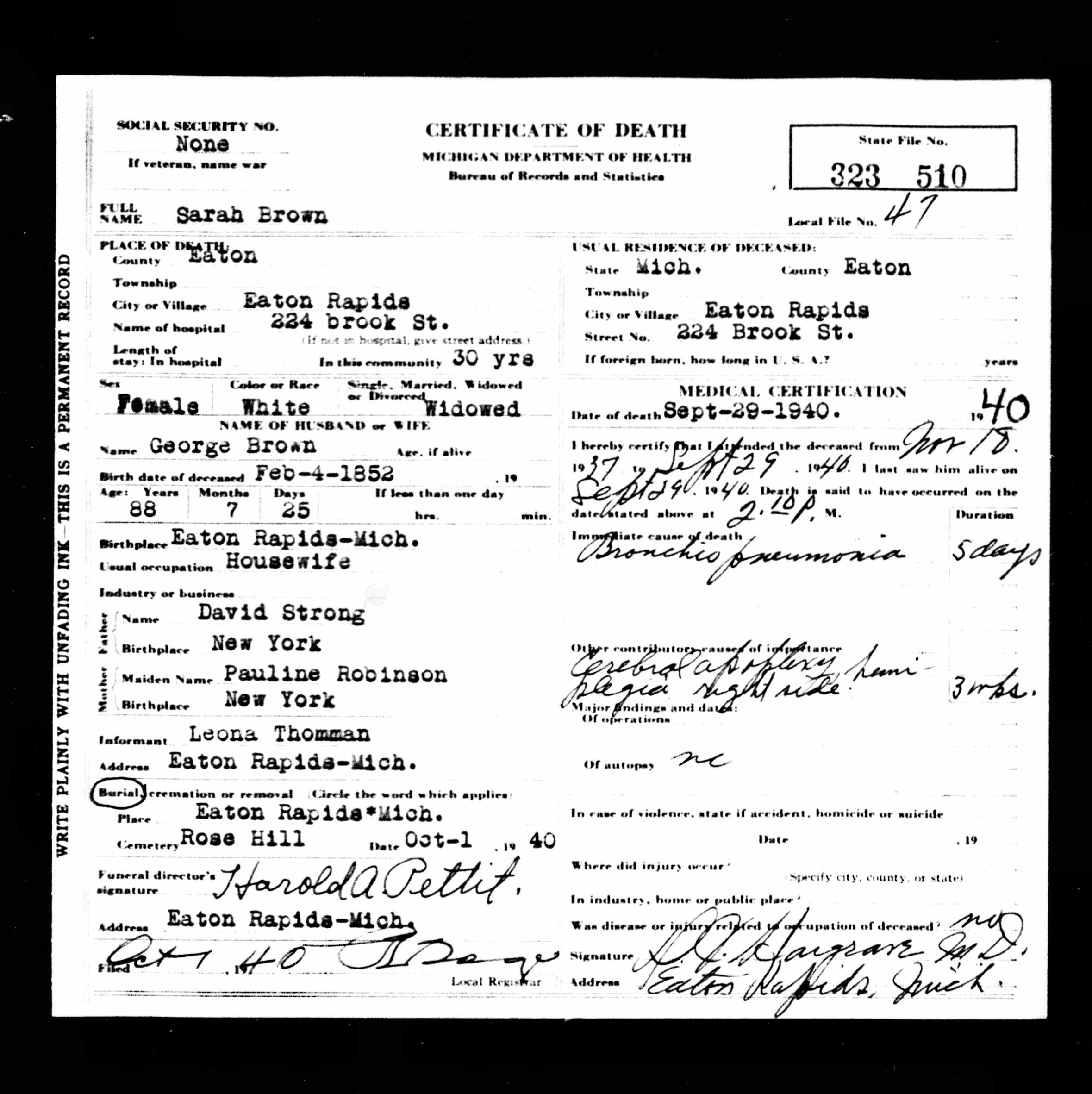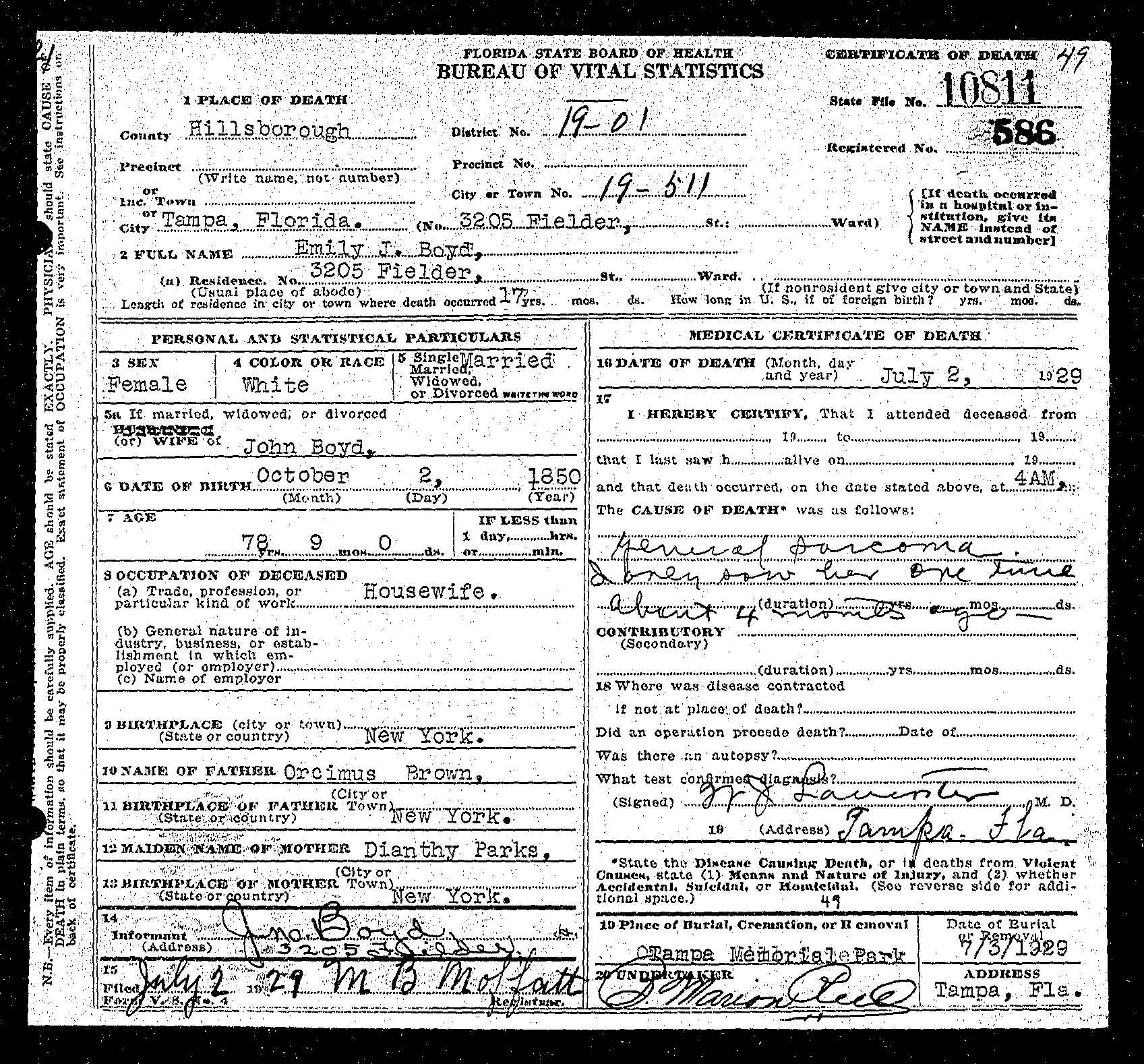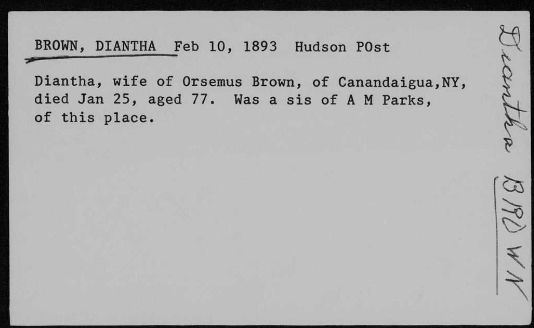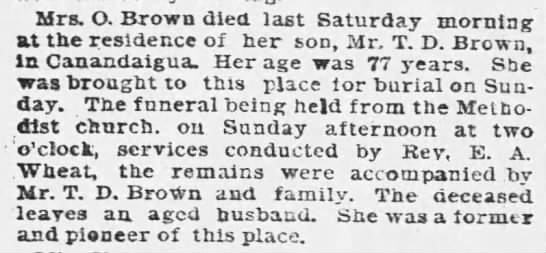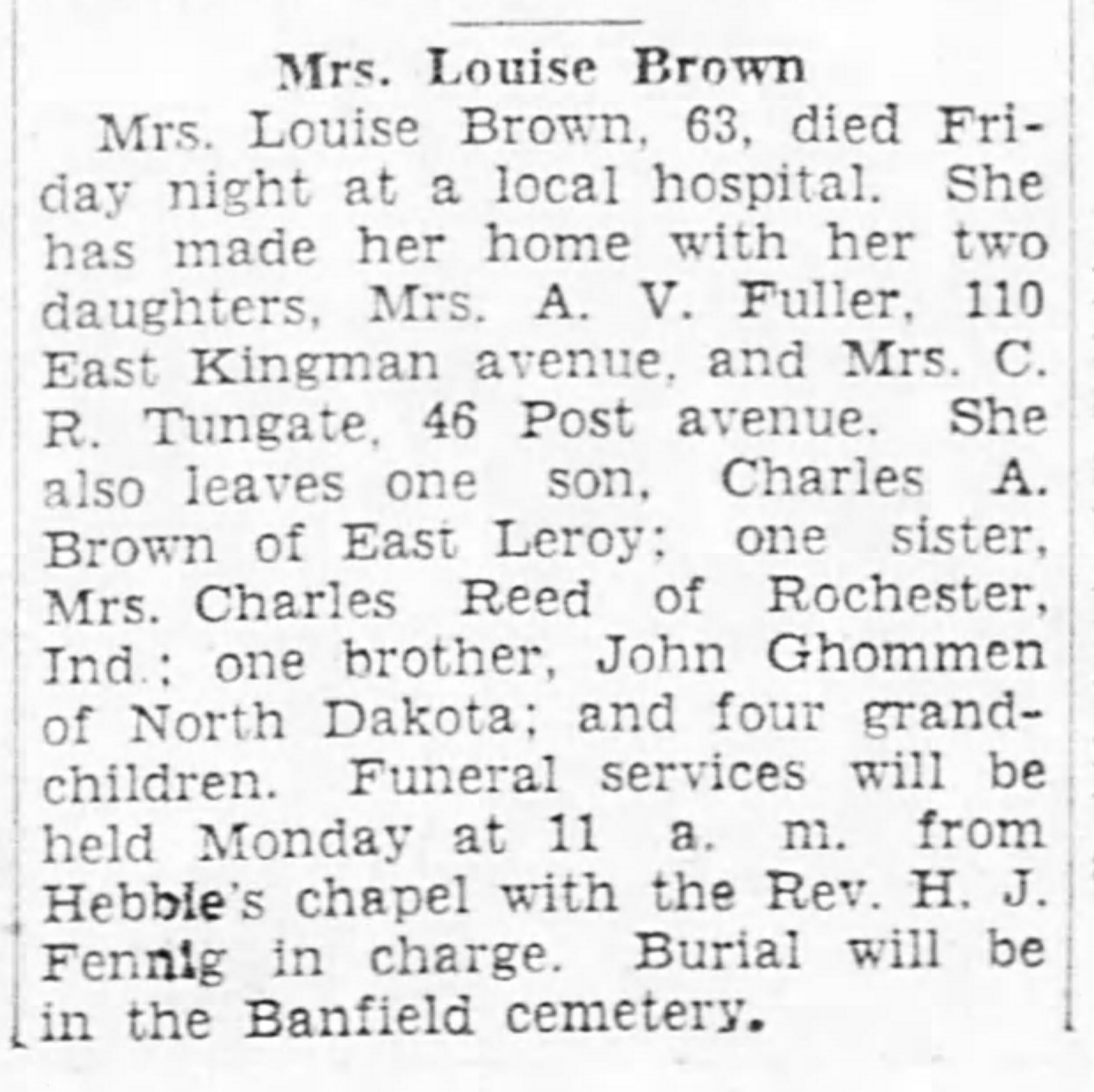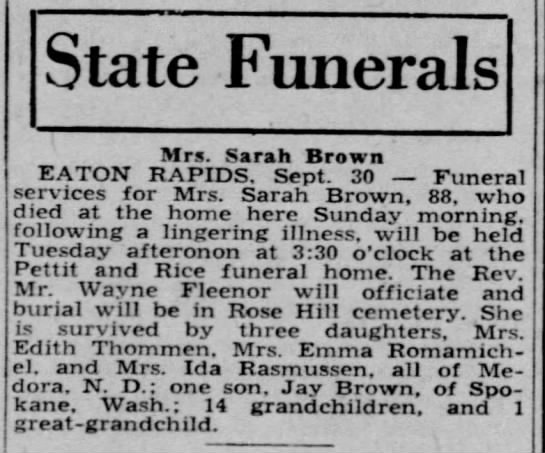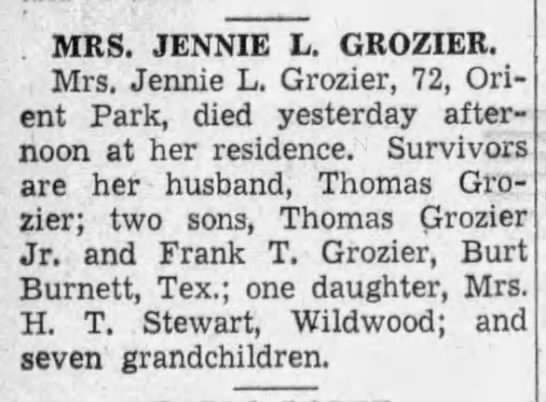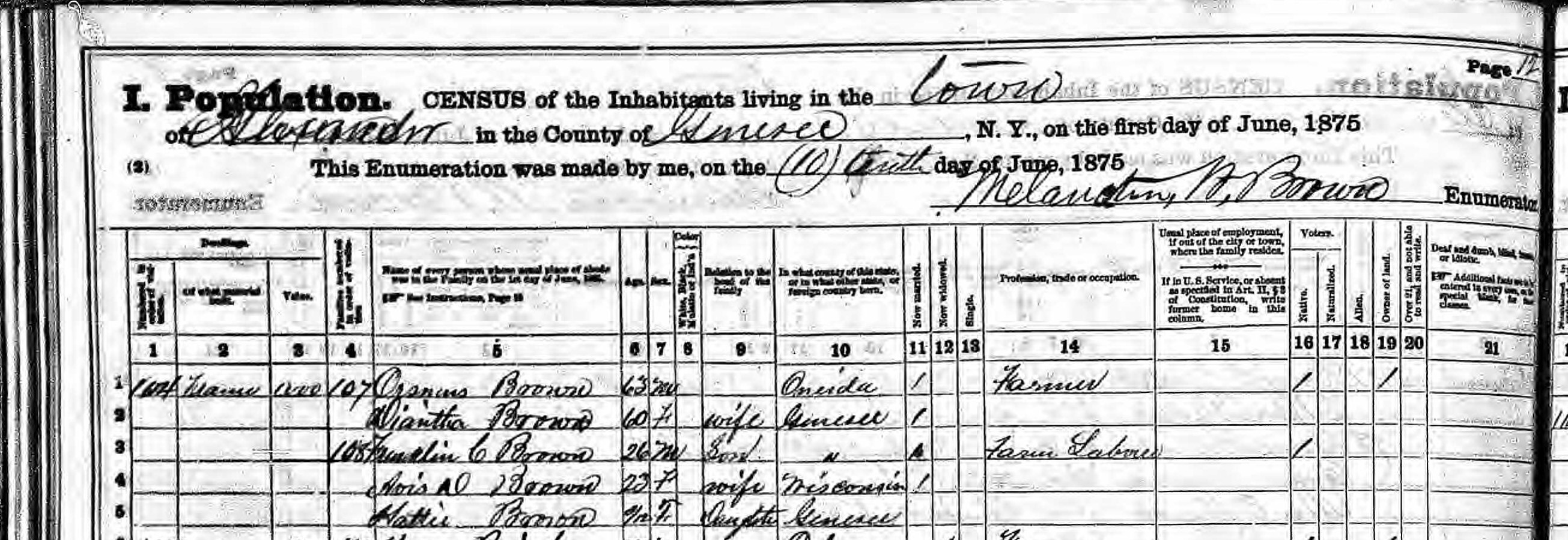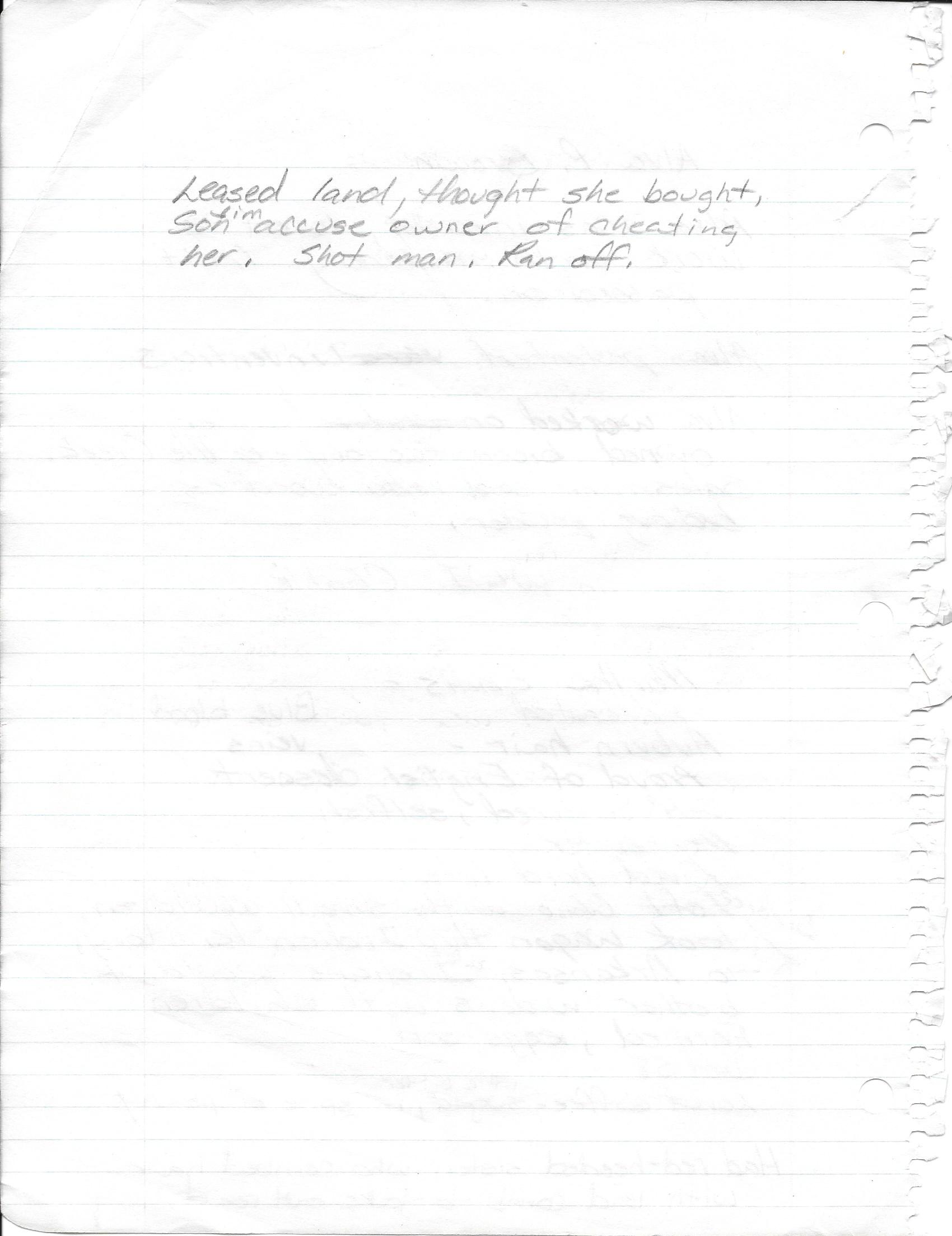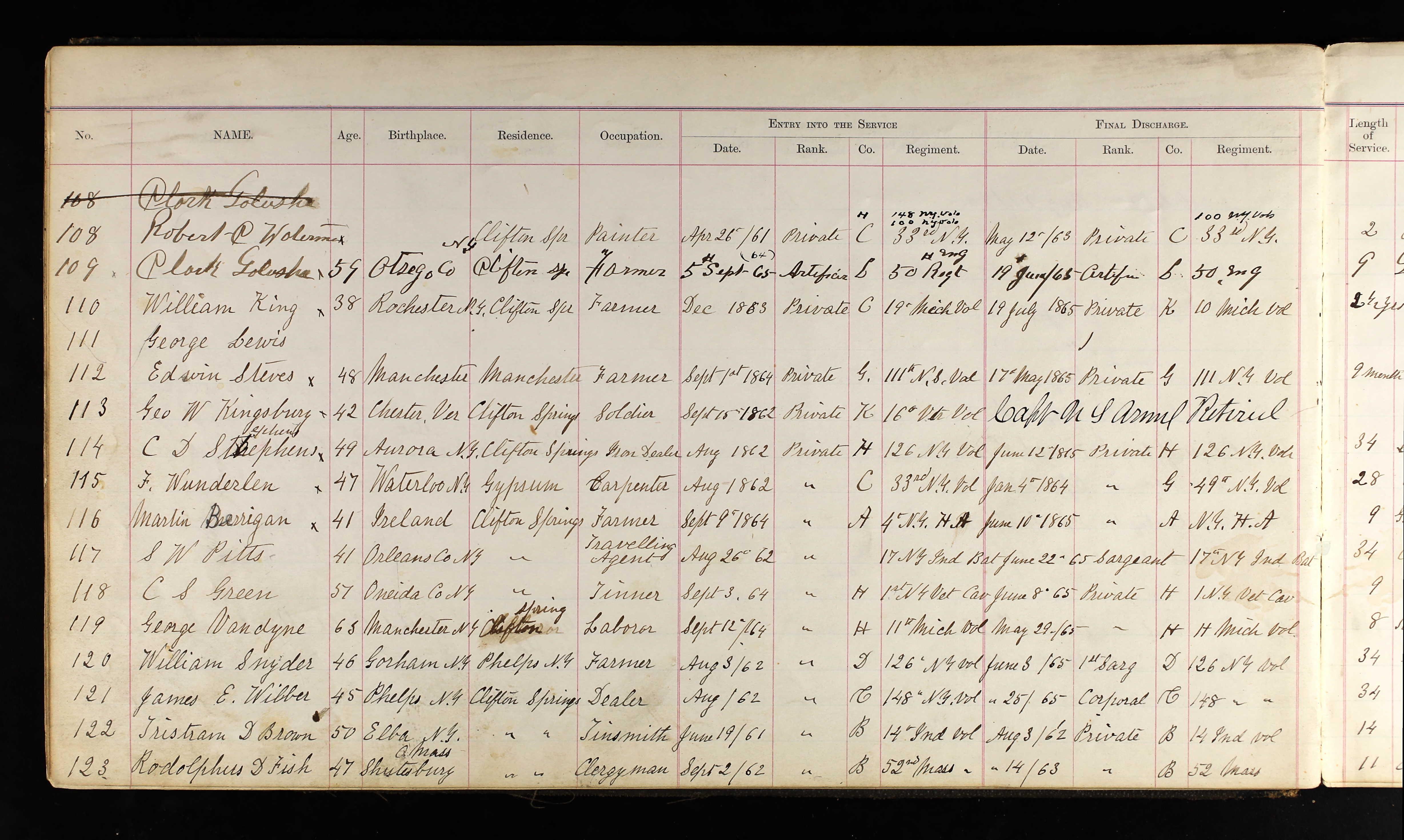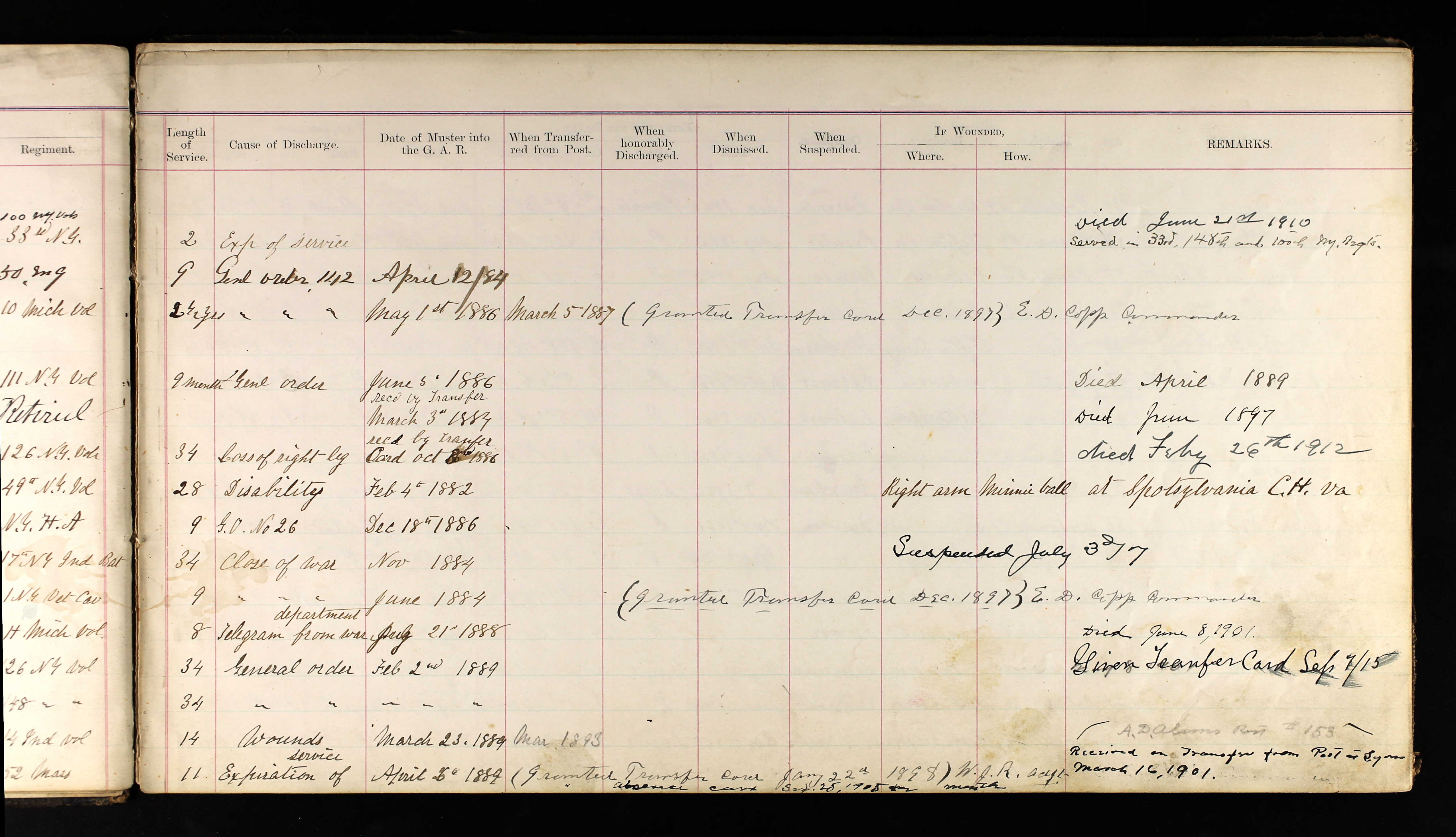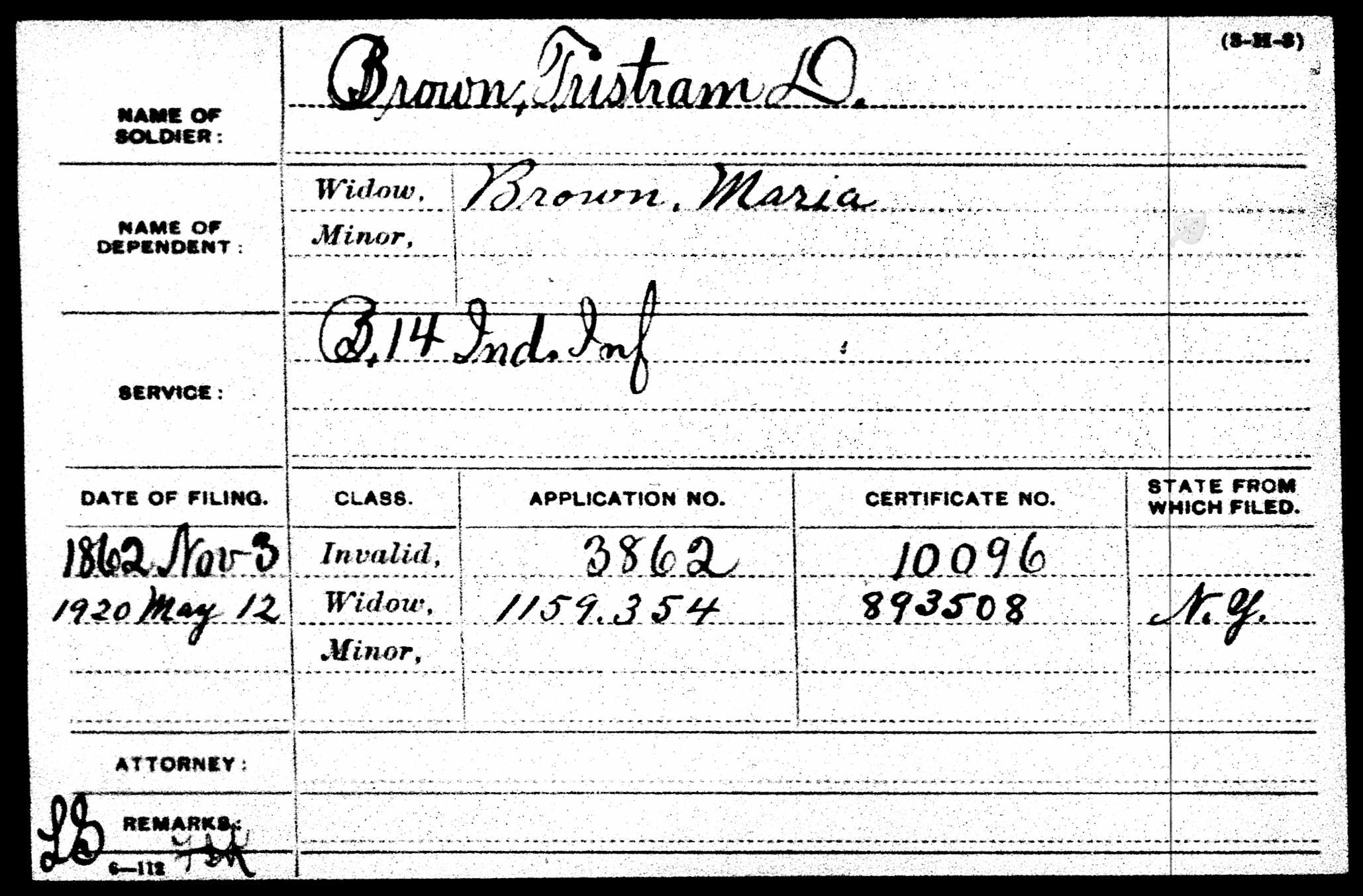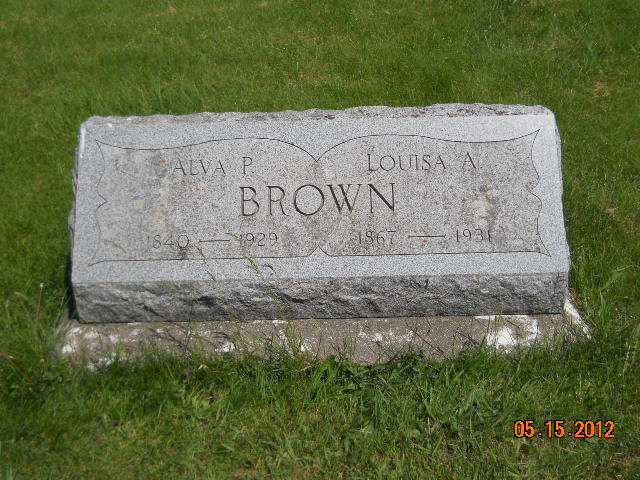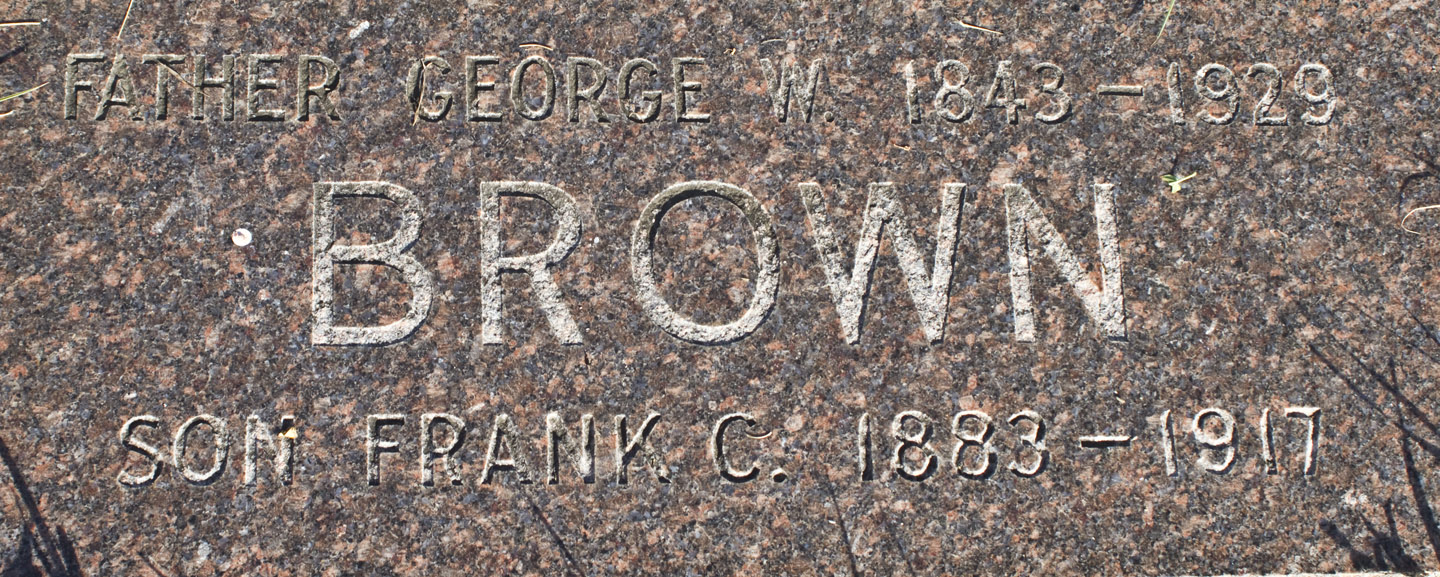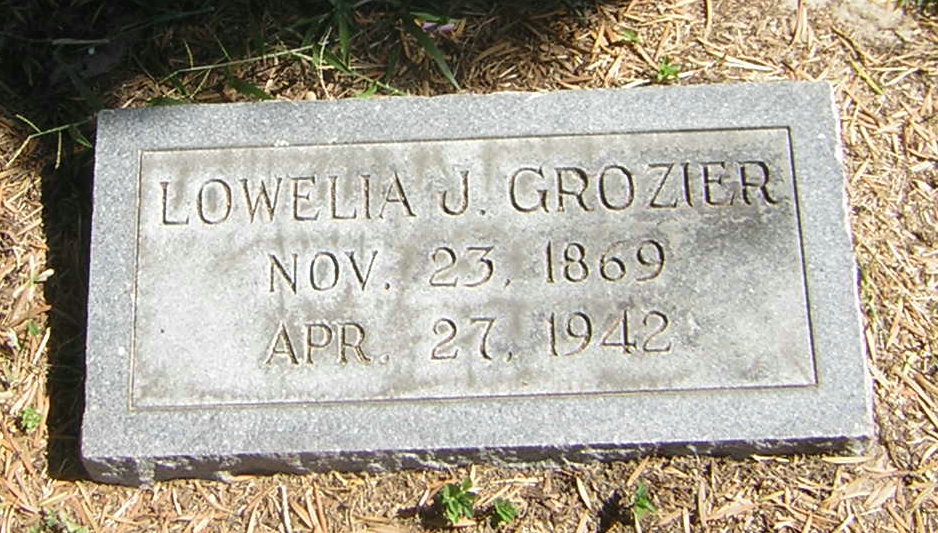Citing this biography: Boyd, Michelle, "Orsmus L. Brown and Diantha Parks," article, Olive and Eliza, last accessed [current date]."
Orsmus L. Brown was born 17 August 1811 in Oneida county, New
York (although some of his children had Connecticut or even
Massachusetts listed as their father's birthplace) to Tristram
Brown and Sarah Lewis. He was orphaned at a young age (the
age of four or ten, depending on the source), when his father was
murdered of the way home from delivering shoes to the army. Orsmus was
subsequently adopted and raised by his uncle and aunt, Calvin
Brown and Nancy —.
Orsmus married Diantha Parks 1 January 1838. Diantha was born
16 June 1815 in Elba, Genesee, New York to George Washington Parks
and Mary Clark.
Orsmus was listed as living in Elba in 1840. Besides a man and a woman
in their 20s, there was one male under the age of 5 in the household.
The Browns were living in Byron, Genesee, New York in 1850 and 1860.
Orsmus was listed as a butcher in 1850 and a farmer in 1860. Orsmus was
listed in an 1865 tax assessment list as a veterinary surgeon in Byron,
Genesse, New York. Orsmus and Diantha were living, along with
22-year-old Franklin, at Alexander, Genesee, New York in 1870. Orsmus
was again listed as a farmer. In 1875, Orsmus and Diantha were living in
Alexander, along with son Franklin, daughter-in-law Avis, and
granddaughter Hattie. Orsmus is listed as a farmer, born in Oneida. An
O. Brown is found on a land ownership map with property in Byron,
Genesee, New York in 1876.
In 1880, Orsmus and Diantha were living in the home of their son Alva in
Washington, Henry, Ohio. They later moved to the home of their son
Tristram in Canandaigua, Ontario, New York.
Diantha was described as "a woman of a genial and social spirit, always
intent on helping where help was needed. For many years she was an
honored member of the Methodist Protestant church in Elba and died in
great peace." She was also called "a woman of remarkable energy and
enterprise" and a "devoted wife and mother."
She died 28 January 1893 in Canandaigua, Ontario, New York ("at 4
o’clock this morning at her home in Canandaigua," or rather her son's
home), "of general prostration and heartfailure," having been "conscious
to the last." According to her obituary, "The health of her companion
has been quite poor for some time, and her anxiety and labor for him
doubtless hastened the end." She was buried 29 January 1893 at Pine Hill
Cemetery, Elba, Genesee, New York.
Orsmus died later that year, on 7 August 1893 in Canandaigua, Ontario,
New York (at his son's home). Orsmus' final illness was a lingering one:
"For a number of years, Mr. Brown has been in poor health and for a time
he was entirely helpless, but was entirely cared for by his son, T. D.
Brown." He was buried by Diantha at Pine Hill Cemetery, Elba, Genesee,
New York.
Orsmus and Diantha’s children are:
| 1 | Tristram
Deloss Brown, born 23 Oct 1838 in Elba, Genesee, New York,
began learning the trade of tinsmithing and coppersmithing at
Albion, Orleans, New York at the age of 16, moved to Newburgh,
Warrick, Indiana in 1858 (where he was living at the start of the
Civil War), a tinsmith at the time of the Civil War, enrolled in
the Union army 7 Jun 1861, a private in Company B, 14th Indiana
Volunteer Infantry (entered the service 19Jun 1861), discharged 11
Aug 1862 at Terre Haute, Vigo, Indiana due to wounds received at
Winchester, Frederick, Virginia, re-enlisted with the 129th New
York Volunteer Infantry and served as a drillmaster at Baltimore,
Baltimore, Maryland (commended for his work by Col. Peter A.
Porter), filed for a pension as a veteran 3 Nov 1862, married Maria
Caple, started the first hardware store at Elba, Genesee,
New York, lived in Oakfield, Genesee, New York in 1875 (listed as
a tinner), lived in Elba, Genesee, New York in 1880 (listed as a
tinsmith), owned a hardware store with W. C. Bradley at
Shortsville, Ontario, New York, sold out his business to Bradley
and moved to Canandaigua, Ontario, New York in 1891, plant
superintendent for the Lisk Manufacturing Company in Canandaigua,
called "a pioneer in the field of modern tinware manufacture" (in
his obituary), said to have invented the Lisk roaster (a
self-basting pan - the lid was concave and had channels, which
caused steam from the meat to run down to the center of the lid
and drip back onto the meat; see "Why a Lisk Roaster Is A Great Vintage Oven
Roaster," Penn Polly Vintage website, last accessed 28 Jun
2020) and have had "more than twenty patents on anti-rust tinware
and other utensils" (patents found are for a bottom for metallic
vessels in 1891, an anti-rust vessel in 1892, a pail, pan,
wash-boiler, etc. patent in 1892, an oil can in 1893 (with David
A. Lisk), a pail, pan, etc. patent in 1895, a bottom for sheet
metal vessels in 1899, and an oil can in 1909), mustered in 23 Mar
1889 as a member of Post No. 007 of the Grand Army of the Republic
(a fraternal organization of Union veterans), later a member of
the Upton post (No. 299) of the GAR, listed as living in
Canandaigua, Ontario, New York in 1900 and working as a
superintendant in tin manufacturing, again listed in Canandaigua
in 1910 but this time as a farmer, again listed in Canandaigua in
1915 but with no occupation, nominated for the office of the
supervisor for Canandaigua at a Democrat caucus in 1907, died 16
Apr 1920 in Canandaigua, Ontario, New York, buried with Maria at
Woodlawn Cemetery, Canandaigua, Ontario, New York. His
great-grandson, H. Wesley Brown, stated, "TD Brown was born in
Elba, New York in 1838. He learned the tinsmith trade at Albion,
New York but was called to the military when the Civil War broke
out in 1861. He fought in many battles, became a decorated war
hero, but came back to Canandaigua, NY to continue tinsmith work
and public affairs...Tristram was one of the early pioneers of the
tinware industry. Over time he developed and patented zinc
coatings (anti-rust) which are still used today. He eventually
sold most of his patents (he had twenty) to the Lisk Manufacturing
Company which made him the superintendent of their factory in
Canandaigua. He was the designer of the famous Lisk Roaster Over,
a popular piece of home cookware in the late 19th century.
Tristram later wrote and typed (in cyanotype) a sixty page
description of his life in early Genesee County, NY. It is an
amazingly detailed record (from memory) everyday life among these
19th century 'settlers' of frontier New York State" (The
Possessor, ch. 3). Wife: Maria Caple, b. Jan 1843 in England to Robert and Sarah (Saynsbury) Caple, bp. 12 Feb 1843 in Congresbury, Somerset, England, arrived 28 Apr 1849 in New York City, filed for a Civil War pension as a widow 12 May 1920, d. 1928. Her great-grandson, H. Wesley Brown, noted that her first name was pronounced "mar-eye-a" (the traditional British pronunciation of the name). Children: Louis O. Brown, Alva H. Brown, Minnie Brown (m. William G. Steves), Maud Brown (m. George L. Atwater), Tristram Howard Brown, and Sherman Elmer Brown. |
| 2 | Alva Parks Brown, born 23
Nov 18(42?) in Elba, Genesee, New York (his birthdate was given as
23 Nov 1838 but the year is likely incorrect as the date is too
close to brother Tristram's birthdate, only one son appears on the
1840 census, and he appears as 8 years old in 1850), married 1) Martha
Jane Ennis 24 Oct 1870 in Texas, Henry, Ohio (divorce filed
by Martha 1 Nov 1880 and granted 11 Feb 1881, remarried Martha 1
Aug 1881 in Napoleon, Henry, Ohio, divorced again in 1886) and 2)
Louisa A. Thoman 14 Aug 1888 in Fulton county, Indiana, a
salesman who ran a huckster wagon to county fairs, sold
door-to-door (sold items including seat springs, water pumps, and
allegedly rotten wood as bedbug powder, an inventor who obtained
several patents (two for a spring bed-bottom in 1875, one for a
bedstead in 1882, and one for a design for a chair in 1895),
listed as a farmer in 1880 and 1900, moved to Michigan with Louisa
and their children in 1903, supposedly owned a broom factory in
Battle Creek, Calhoun, Michigan and certainly a broommaker in
Battle Creek, committed to the Kalamazoo State Hospital by 1920,
died 14 Jun 1929 at the Kalamazoo State Hospital, Kalamazoo,
Kalamazoo, Michigan of myocarditis and cardiac failure with
arteriosclerosis as a contributing factor, buried 16 June 1929 at
Banfield Cemetery, Banfield, Barry, Michigan. Wife 1: Martha Jane Ennis, b. 10 Aug 1849 in Union County, Ohio to Alonzo Havington and Olive (Bird) Ennis, moved to Texas, Henry, Ohio in 1865, moved to Arkansas with her children after her second divorce, d. 1910 in Little Rock, Pulaski, Arkansas. Wife 2: Louisa A. Thoman, b. 9 Jan 1868 to Jacob and Caroline Thoman, a housekeeper in a hospital in 1920, d. 15 May 1931 at Nichols Hospital in Battle Creek, Calhoun, Michigan of a cerebral hemorrhage, bur. 18 May 1931 next to Alva at Banfield Cemetery. Children (by Martha): Beecher Brown, Alonzo Orsmas Brown, James Ennes Brown (DNA and documentary evidence suggests that Alonzo Orsmas and James were actually likely the same person, going by an alias), Bertha Amanda Brown, Ardella Margaret Brown, Homer Louis Brown, and Edward Brown. Children (by Louisa): Charles Alva Brown, Goldie E. Brown, and Leona L. Brown. |
| 3 | George
Washington Brown, born 3 Oct 1843 in Elba, Genesee, New York
(according to secondary sources), married Sarah Maria Strong
24 Jul 1871 in Eaton Rapids, Eaton, Michigan (date and place
according to secondary sources), lived in Maple Grove, Barry,
Michgan and worked as a farmer in 1880, lived in Michigan in 1893,
lived in Sentinel Butte, Golden Valley, North Dakota with his son
Jay's family in 1920 (listed as a widower despite Sarah being
alive and residing in Michigan at the time; he and Sarah may have
separated by 1910 when she is seen living with her mother and one
of her sons and George's whereabouts are not currently known),
died in 1929, buried at Sentinel Butte Cemetery, Sentinel Butte,
Golden Valley, North Dakota with his son Frank C. Brown. Wife: Sarah Maria Strong, b. 4 Feb 1852 in Eaton Rapids, Eaton, Michigan to David and Pauline (Robinson) Strong, lived with her mother and son David Hayden in Eaton Rapids, Eaton, Michigan in 1910 (listed as married but George is not enumerated in the household), lived with son David Hayden and a companion in Eaton Rapids, Eaton, Michigan in 1920 (listed as a widow despite George being alive and living elsewhere), lived with son David Hayden and granddaughter Leona M. Thommen in Eaton Rapids, Eaton, Michigan in 1930, lived in Eaton Rapids, Eaton, Michigan with granddaughter Leona in 1940 (recorded as having lived in the same house in 1935), d. 29 Sep 1940 in Eaton Rapids, Eaton, Michigan of bronchio pneumonia (with a contributing cause of "cerebral apoplexy, hemiplegia right side"), bur. 1 Oct 1940 at Rose Hill Cemetery, Eaton Rapids, Eaton, Michigan. Children: David Hayden Brown, Jay Brown (m. Dorothy L. --), Emma J. Brown (m. -- Romamichel), Edith Leona Brown (m. John Jacob Thommen), Frank Brown, and Ida Mae Brown (m. -- Rasmussen). |
| 4 | Franklin
C. Brown, born 23 Sep 1848 in Genesee county, New York,
seems to have often been called Frank or F. C. for short, married
Avis D. Earl about 1874, lived with his parents, wife, and
baby daughter Hattie in Alexander, Genesee, New York in 1875
(listed as a farm laborer), lived in Little Sioux, Harrison, Iowa
in 1880 and 1893, a tinner (according to the 1880 and 1910
censuses and a newspaper article published at his death), lived in
the household of his daughter Seba and her family in Little Sioux,
Harrison, Iowa in 1910, an "employe[e] of a hardware concern for
the past thirty years" according to an article on his death
(although other details about his life in this article were not
accurate), member of the Independent Order of Odd Fellows (Council
Bluffs lodge), died 16 Jan 1912 in Tampa, Hillsborough, Florida
(at the Halcyon Sanitarium, located in the Tampa Bay Hotel Park)
after being struck by a car. Frank had arrived in Tampa a week
before the accident and intended to stay there that winter to
improve his health. He was crossing West Lafayette Street from the
boarding house (301 Hyde Park Avenue) from where he was staying to
the gates of the Tampa Bay Hotel to mail a letter when a doctor on
his way to work came along. The doctor tried to get his attention
by honking the horn but Frank couldn't hear it, so he tried to go
around. Frank spotted him, startled, jumped in the same direction
that the doctor was turning and was struck and pinned against the
brick post of the gates. The doctor drove Frank to the sanitarium
where he worked. Frank died there shortly after arrival from a
skull fracture. The accident was ruled unavoidable and the doctor
was exonerated. One article described him as "well dressed, and
wore a little gray mustache" and that he was carrying letters and
keys "the ring of which bore the engraving, 'F. C. Brown, tinner,
Little Sioux, Ia.'" Frank's body was transported back home and he
was buried 24 Jan 1912 at Little Sioux Cemetery, Little Sioux,
Harrison, Iowa. Wife: Avis D. Earl, b. 5 Jul 1853 in Wisconsin, d. 9 Apr 1907, bur. at Little Sioux Cemetery, Little Sioux, Harrison, Iowa. Children: Hattie E. Brown (m. -- Fox), Orlando E. Brown (m. Mamie T. Tholl), Seba A. Brown (m. William H. Eyer), and Frank Orsmus Brown. |
| 5 | Mary
J. Brown, born about Dec 1849. Orsmus' obituary stated that
at the time of his death, he had "five children, all of whom are
living." However, a Mary J., aged 10 months, appears on the 1850
census, taken 27 Sep 1850. This is a little under a week before
Emma's birth. Assuming Emma's recorded birthdate is correct, this
means that there were only ten months between births, which is
unusual but still possible. Mary has not been found in any further
records. |
| 6 | Emma
J. Brown, called Emily in some records, b. 2 Oct 1850,
married 1) Cassius T. Bowen and 2) John Boyd about
1884 or 1888 (the 1900 and 1910 censuses gives number of years
married as 12 and 26 respectively), lived in Alexander, Genesee,
New York in 1870, 1875, and 1880, lived in North Dakota in 1893,
lived in Baltimore, Barry, Michigan in 1900 and 1910, moved to
Tampa, Hillsborough, Florida in 1912 (probably about a week or two
before brother Frank's fatal accident), lived in Ballast Point,
Hillsborough, Florida (now a neighborhood in Tampa) in 1920, died
2 Jul 1929 in Tampa, Hillsborough, Florida (at 4 am at her home at
3205 Fielder Avenue of general sarcoma), buried 3 Jul 1929 at
Tampa Memorial Park, Tampa, Hillsborough, Florida. Husband 1: Cassius T. Bowen, b. 6 Feb 1849 in New York to David T. and Serviah (Tyrrel) Bowen, worked on his parents' farm in 1870, farmer in 1880, d. 14 Jul 1880, bur. at Forest Hill Cemetery, Attica, Wyoming, New York. That Emma was married to Cassius can be established indirectly:
Husband 2: John Boyd, b. Jun 1854 in Michigan, a farmer in 1900 and 1910, a carpenter in the shipyards in 1920, living by himself in Ballast Point, Hillsborough, Florida in 1930, a carpenter building houses in 1930, probably the John Boyd (a carpenter) who lived at 3205 Binnicker Avenue in Tampa in 1935. Child (by Cassius): Lowelia Jennie Bowen (or Louella Jane Bowen) (m. Thomas Ural Grozier). Child (father not known): The 1900 and 1910 censuses note that Emma was the mother of two children, one of whom was living. It is uncertain if the child who must have died by 1900 was the child of Cassius or John and no information is currently known about the child's name, gender, birth or death date, or age at death. |
Summary of Sources
- Email, Benjamin Brown to Michelle Boyd, 23 February 2023, citing the autobiography of Tristram Deloss Brown.
- Benz, Scott, Town of Elba 175th Anniversary, Genesee
County Publications Corp., 1995, pgs.189-190.
- Ennes, Calvin, A Bit about the Ennes, privately printed
manuscript, Au Gres, MI, 1969. Transcription available at http://www.boydhouse.com/darryl/ennis/book/cover.htm,
last accessed 8 Jan 2019.
- Beers, Frederick W., Gazetteer and Biographical Record of
Genesee County, N.Y., 1788-1890, Syracuse, NY: J. W. Vose
& Co., 1890, p. 440.
- "John Jacob Thommen and Edith Leona Brown," posted by Arthur + Lynn Nagorski, Ancestry, last
accessed 26 June 2020.
- Ancestry.com. Somerset, England, Church of England Baptisms,
1813-1914 [database on-line]. Provo, UT, USA: Ancestry.com
Operations, Inc., 2016. Original data: Anglican Parish Registers.
Somerset Archives & Local Studies, South West Heritage Trust,
Taunton, England.
- Interview of Alva Parks and Martha Jane (Ennis) Brown’s grandson,
Frank Richard Boyd, Thanksgiving, 1988, interview conducted by
Darryl and Alice Boyd; along with handwritten notes of his memories
of his family, taken by Alice C. Boyd.
- Sixth Census of the United States, 1840. (NARA microfilm
publication M704, 580 rolls). Records of the Bureau of the Census,
Record Group 29. National Archives, Washington, D.C.
- Seventh Census of the United States, 1850; (National Archives
Microfilm Publication M432, 1009 rolls); Records of the Bureau of
the Census, Record Group 29; National Archives, Washington, D.C.
- 1860 U.S. census, population schedule. NARA microfilm publication
M653, 1,438 rolls. Washington, D.C.: National Archives and Records
Administration, n.d.
- 1870 U.S. census, population schedules. NARA microfilm publication
M593, 1,761 rolls. Washington, D.C.: National Archives and Records
Administration, n.d.
- Tenth Census of the United States, 1880. (NARA microfilm
publication T9, 1,454 rolls). Records of the Bureau of the Census,
Record Group 29. National Archives, Washington, D.C.
- United States of America, Bureau of the Census. Twelfth Census of
the United States, 1900. Washington, D.C.: National Archives and
Records Administration, 1900. T623, 1854 rolls.
- Thirteenth Census of the United States, 1910 (NARA microfilm
publication T624, 1,178 rolls). Records of the Bureau of the Census,
Record Group 29. National Archives, Washington, D.C.
- Fourteenth Census of the United States, 1920. (NARA microfilm
publication T625, 2076 rolls). Records of the Bureau of the Census,
Record Group 29. National Archives, Washington, D.C.
- United States of America, Bureau of the Census. Fifteenth Census
of the United States, 1930. Washington, D.C.: National Archives and
Records Administration, 1930. T626, 2,667 rolls.
- United States of America, Bureau of the Census. Sixteenth Census
of the United States, 1940. Washington, D.C.: National Archives and
Records Administration, 1940. T627, 4,643 rolls.
- Ancestry.com. New York, State Census, 1875 [database on-line].
Provo, UT, USA: Ancestry.com Operations, Inc., 2013. Original data:
Census of the state of New York, for 1875. Microfilm. New York State
Archives, Albany, New York.
- Ancestry.com. New York, State Census, 1915 [database on-line].
Provo, UT, USA: Ancestry.com Operations, Inc., 2012. Original data:
State population census schedules, 1915. New York State Archives,
Albany, New York.
- Letter from Alva P. Brown, undated (probably about 1917-8),
presumably to one or more of the children of his first marriage,
scanned from a photocopy in the possession of Darryl W. Boyd
(grandson of Bertha Amanda Brown).
- Daily News (Genesee County, NY), 28 January 1893.
- Progressive Batavian (Batavia, NY), 3 February 1893 and 11
August 1893.
- "Michigan Obituaries, 1820-2006," database with images,
FamilySearch (https://familysearch.org/ark:/61903/1:1:QVP1-G2BF : 1
April 2020), A M Parks in entry for Diantha Brown, 1893; citing ,
Obituary, Grand Rapids Public Library, Michigan; FHL microfilm
7,615,428.
- Batavia Daily News (Batavia, NY), 19 April 1920.
- The Buffalo Commercial, Buffalo, New York, 2 Feb 1893, 10
Aug 1893, 6 Oct 1893, and 6 Jul 1900.
- Buffalo Evening News (Buffalo, NY), 26 Sep 1907.
- Democratic Northwest and Henry County News (Napoleon, OH),
18 August 1881, 9 February 1882, 3 January 1884, 5 August 1886, and
7 October 1886.
- The Indianapolis Journal (Indianapolis, IN), 31 July 1895.
- Battle Creek Enquirer (Battle Creek, MI), 15 June 1929 and
17 May 1931.
- Lansing State Journal, 30 Sep 1940.
- The Tampa Times (Tampa, FL), 17 Jan 1912, 19 Jan 1912, 2
Jul 1929, 3 Jul 1929, and 29 Apr 1942.
- The Tampa Tribune (Tampa, FL), 17 Jan 1912, 18 Jan 1912, 19
Jan 1912, and 3 Jul 1929. Sioux City Journal (Sioux City, IA), 24
Jan 1912.
- Evening Times-Republican (Marshalltown, IA), 25 Jan 1912.
- Ancestry.com. Ohio, County Marriage Records, 1774-1993 [database
on-line]. Lehi, UT, USA: Ancestry.com Operations, Inc., 2016.
Original data: Marriage Records. Ohio Marriages. Various Ohio County
Courthouses.
- Ancestry.com. Ohio, Compiled Marriage Index, 1803-1900 [database
on-line]. Provo, UT, USA: Ancestry.com Operations Inc, 2001.
Original data: Jordan Dodd, Liahona Research. Ohio, Marriages,
1803-1900. Full list of sources in the description.
- Ancestry.com. Indiana, Select Marriages Index, 1748-1993 [database
on-line]. Provo, UT, USA: Ancestry.com Operations, Inc., 2014.
Original data: Indiana, Marriages. Salt Lake City, Utah:
FamilySearch, 2013.
- "Ohio, County Marriages, 1789-1994," index and images,
FamilySearch (https://familysearch.org/pal:/MM9.1.1/XZLR-VGT :
accessed 24 Apr 2014), F. C. Brown in entry for Orlie E. Brown and
Mamie T. Tholl, 10 Dec 1900; citing Lucas, Ohio, United States,
reference p 88 cn 2351; FHL microfilm 909008.
- Martha J. Brown v. Alva P. Brown, from Complete Record, Henry
Common Pleas, January Term, A.D. 1881, transcription of a photocopy
in possession of Darryl W. Boyd.
- Brown, Alva P., Improvement in spring bed-bottoms, US163356A,
United States Patent and Trademark Office, 18 May 1875. This patent
can be viewed at Google Patents,
https://patents.google.com/patent/US163356?oq=alva+brown, retrieved
5 February 2019.
- Brown, Alva P., Bedstead, US252354A, United States Patent and
Trademark Office, 17 Jan 1882. This patent can be viewed at Google
Patents, https://patents.google.com/patent/US252354?oq=alva+brown,
retrieved 5 February 2019.
- Brown, Alva P., Chair, US543640A, United States Patent and
Trademark Office, 30 Jul 1895. This patent can be viewed at Google
Patents, https://patents.google.com/patent/US543640?oq=alva+brown,
retrieved 5 February 2019.
- Brown, T. D. (Canandaigua, Ontario, New York), Anti-rust Vessel,
US469991A, United States Patent and Trademark Office, 1 Mar 1892.
This patent can also be viewed at Google Patents.
- Official Gazette of the United States Patent Office, vol.
59, no. 10, 7 June 1892, p. 1452. Available at Google Books.
- Brown, T. D. (Clifton Springs, Ontario, New York), Pail, Pan,
Wash-boiler, &c., US480555A, United States Patent and Trademark
Office, 9 Aug 1892. This patent can also be viewed at Google Patents.
- Lisk, David A. and Brown, Tristram D. (Clifton Springs, Ontario,
New York), Oil-can, US504788A, United States Patent and Trademark
Office, 12 Sep 1893. This patent can also be viewed at Google Patents.
- Brown, T. D. (Clifton Springs, Ontario, New York), Pail, Pan,
&c., US534546A, United States Patent and Trademark Office, 19
Feb 1895. This patent can also be viewed at Google Patents.
- Brown, Tristram D. (Canandaigua, Ontario, New York), Bottom for
Sheet-metal Vessels, US636752A, United States Patent and Trademark
Office, 14 Nov 1899. This patent can also be viewed at Google Patents.
- Brown, Tristram D. (Canandaigua, Ontario, New York), Oil-can,
US933881A, United States Patent and Trademark Office, 14 Sep 1909.
This patent can also be viewed at Google Patents.
- Ancestry.com. New York, Passenger and Crew Lists (including Castle
Garden and Ellis Island), 1820-1957 [database on-line]. Provo, UT,
USA: Ancestry.com Operations, Inc., 2010.
- Ancestry.com. New York, Grand Army of the Republic Records,
1866-1931 [database on-line]. Provo, UT, USA: Ancestry.com
Operations, Inc., 2013. Original data: Grand Army of the Republic
Records, Post Descriptive Books. Series B1706, Sub-Series 11. New
York State Archives, Albany, New York.
- Ancestry.com. Web: Indiana, Civil War Soldier Database Index,
1861-1865 [database on-line]. Provo, UT, USA: Ancestry.com
Operations, Inc., 2015. Original data: Civil War. Indiana State
Digital Archives. https://secure.in.gov/apps/iara/search/: accessed
2 February 2015.
- National Archives and Records Administration. U.S., Civil War
Pension Index: General Index to Pension Files, 1861-1934 [database
on-line]. Provo, UT, USA: Ancestry.com Operations Inc, 2000.
Original data: General Index to Pension Files, 1861-1934.
Washington, D.C.: National Archives and Records Administration.
T288, 546 rolls.
- Ancestry.com. U.S. IRS Tax Assessment Lists, 1862-1918 [database
on-line]. Provo, UT, USA: Ancestry.com Operations Inc, 2008.
Original data: Records of the Internal Revenue Service. Record Group
58. The National Archives at Washington, DC. See Full Source
Citations.
- Collection Number: G&M_8; Roll Number: 8; County and Year:
Genesee, 1876; Ancestry.com. U.S., Indexed County Land Ownership
Maps, 1860-1918 [database on-line]. Provo, UT, USA: Ancestry.com
Operations, Inc., 2010. Original data: Various publishers of County
Land Ownership Atlases. Microfilmed by the Library of Congress,
Washington, D.C.
- Ancestry.com. U.S. City Directories, 1822-1995 [database on-line].
Provo, UT, USA: Ancestry.com Operations, Inc., 2011.
- "Texas Births and Christenings, 1840-1981", database, FamilySearch
(https://familysearch.org/ark:/61903/1:1:4L8N-TP3Z : 14 February
2020), Lowela J. Bowen in entry for Francis Trustum Grozier, 1893.
- "Florida Births and Christenings, 1880-1935", database,
FamilySearch (https://familysearch.org/ark:/61903/1:1:F7R3-NDC : 10
January 2020), Louella Jane Bowen in entry for Thomas Ural Grozier,
1899.
- Ancestry.com. U.S., Social Security Applications and Claims Index,
1936-2007 [database on-line]. Provo, UT, USA: Ancestry.com
Operations, Inc., 2015. Original data: Social Security Applications
and Claims, 1936-2007.
- Ancestry.com. Michigan, Death Records, 1867-1950 [database
on-line]. Provo, UT, USA: Ancestry.com Operations, Inc., 2015.
Original data: Death Records. Michigan Department of Community
Health, Division for Vital Records and Health Statistics, Lansing,
Michigan.
- Ancestry.com. Michigan, Death Records, 1867-1952 [database
on-line]. Provo, UT, USA: Ancestry.com Operations, Inc., 2015.
Original data: Death Records. Michigan Department of Community
Health, Division for Vital Records and Health Statistics, Lansing,
Michigan.
- Tampa, Florida death and cemetery records, 1896-1921; index,
1896-1958, FHL Film 1673803 Item 2 (Death records, v. 1, 1899 -
Sept. 1918), Image 142 of 491 and FHL Film 1673803 Item 3
(Record of burial and transportation permits issued, Nov. 1907 -
Sept. 1910), Image 285 of 491, accessed 27 June 2020.
- "Florida Deaths, 1877-1939", database, FamilySearch
(https://familysearch.org/ark:/61903/1:1:FP8S-7FV : 8 August 2019),
John Boyd in entry for Emily J. Boyd, 1929.
- Gravestones of Orsmus and Diantha (Parks) Brown, Pine Hill
Cemetery, Elba, Genesee, New York.
- Gravestone of Alva P. and Louisa A. Brown, Banfield Cemetery,
Banfield, Barry, Michigan.
- Gravestones of Tristram D. and Maria (Caple) Brown, Woodlawn
Cemetery, Canandaigua, Ontario, New York.
- Gravestone of George W. Brown and his son, Frank C. Brown,
Sentinel Butte Cemetery, Sentinel Butte, Golden Valley, North
Dakota.
- Gravestones of Frank C. and Avis (Earl) Brown, Little Sioux
Cemetery, Little Sioux, Harrison, Iowa.
- Gravestones of Cassius T., David T., and Servia (Tyrrel) Bowen,
Forest Hill Cemetery, Attica, Wyoming, New York.
- Gravestone of Lowelia J. Grozier, Orange Hill Cemetery, Tampa,
Hillsbourough, Florida.
- "Pine Hill Cemetery," http://genesee.bettysgenealogy.org/phill.htm, retrieved 24 Apr 2014.
Records related to Orsemus L. and Diantha (Parks) Brown but not copied below due to copyright considerations:
- AncestryDNA “ThruLines for Michelle Boyd,” matches through Richard Brown (1745- ), Ancestry (https://www.ancestry.com: accessed 3 July 2020.)
- Brown, H. Wesley, The Possessor, Xlibris Corporation, 2011, ch. 3 (The Brown Legacy). Available on Google Play, last accessed 21 June 2020.
Photos
Click each thumbnail to open a full-size version of the image in a new tab.
Source Materials
Click on each category below to expand and see the copies of sources used to create the biography above (copyrighted and other restricted items are listed in the summary of sources above but not included below). Click again to close.
Orsmus' son Tristram Deloss Brown stated that Orsmus' parents were Tristram and Sarah(Lewis) Brown. This is supported by evidence from DNA matches provided by Ancestry DNA's ThruLines.
A ThruLines report for Richard Brown (Calvin's father) shows that I have DNA matches to descendants of Richard's known children Chauncey and Achsah, as well as a probable son Richard (results are summarized below). While ThruLines's accuracy is semi-dependent on the quality of the documentary research, it does indicate DNA matches with a high number of people who claim descent from the Brown family.
Other circumstantial evidence includes a strong custom during that era for close relatives to adopt orphaned children and the fact that Orsmus and Diantha did name a son Tristram, a name not seen in Diantha's family. When these are taken with the DNA evidence and the identification of a grandson in his autobiography, there seems to be very strong support for Orsmus being the son of Tristram and Sarah, the nephew of Calvin (and Achsah, Chauncey, and Richard), and the grandson of Richard and Nancy Brown.
Below is a summary of results for my matches as found in ThruLines (Ancestry DNA) for Richard Brown:
Descendants of Achsah:
- Probable 6th cousin (17 cM, 1 segment), reported ancestry: Richard and Nancy Brown > Achsah Brown > Maria Peckham > Alice Maria Seabury > George D Gilbert > Maurice E Gilbert > private > match
Descendants of Chauncey:
- Probable 5th cousin 1x removed (22 cM, 1 segment), reported ancestry: Richard and Nancy Brown > Chauncey Brown > Gregory Brown > Winfield Scott Brown > David Lewis Brown > Everett W Brown > match
- Probable 4th cousin 2x removed (17 cM, 1 segment), reported ancestry: Richard and Nancy Brown > Chauncey Brown > Luther Myrick Brown > Chauncey Lewis Brown > Edwin Lewis Brown > match
Descendants of Richard:
- Probable 5th cousin 1x removed (24 cM, 1 segment), reported ancestry: Richard and Nancy Brown > Richard Brown > Alice Mariette Brown > John Fremont Rhoades > Earle Rhoades > Joanne Ruth Rhoades > match
- Probable 5th cousin 1x removed (21 cM, 1 segment), reported ancestry: Richard and Nancy Brown > Richard Brown > ? Brown > Minnie Rhoades > match
- Probable 6th cousin (18 cM, 1 segment), reported ancestry: Richard Brown > Richard and Nancy Brown > Alice Mariette Brown > John Fremont Rhoades > Earle Rhoades > Mary Jane Rhoades > private > match
- Probable 5th cousin 1x removed (15 cM, 1 segment), reported ancestry: Richard and Nancy Brown > Richard Brown > John A. Brown > Albert Pearce Brown > Minnie Maude Brown > Ann Ora Means > match
- Probable 5th cousin 1x removed (7 cM, 1 segment), reported ancestry: Richard and Nancy Brown > Richard Brown > John A. Brown > Eliza A. Browne > Carrie L. Sackett > Leighton R Scott > match - ***Note: Matches under 8 cM are usually not significant and may or may not be a true match. However, in the light of the other matches to Richard, this match may still be of interest.
Source: AncestryDNA “ThruLines for Michelle Boyd,” matches through Richard Brown (1745- ), Ancestry (https://www.ancestry.com: accessed 3 July 2020.)
Email from Benjamin Brown:
"As I mentioned in my initial email below, a son of Orsmus and Diantha, Tristram Deloss Brown, wrote an autobiography, and it has a great deal of useful information. First, I've noticed his father's name is sometimes spelled Orsemus. The autobiography always spells his name Orsmus so I imagine that's the correct spelling. As to the father of Orsmus, Tristram Brown, he was born on November 10, 1786, was married to Sarah Lewis on January 1, 1810, and was murdered on October 3, 1814. According to the autobiography "he was a tanner and shoemaker by trade and was murdered on his way home from delivering shoes to the United States Army. He left behind three small children, Jane, Orsmus and Isaac and four brothers, Richard, Calvin, Chauncy and James and one sister, Jane, who married Carter Peckham." Since Orsmus was born on August 17, 1811, he was only three when his father was murdered. The listing of Tristram's siblings confirms that Calvin was a brother."
Source: Email, Benjamin Brown to Michelle Boyd, 23 February 2023, citing the autobiography of Tristram Deloss Brown.
Images of pages from a letter are shown below as a thumbnail. Click on the thumbnail to view a larger version of the page in another tab.
Letter written by Alva Parks Brown:
Source: Letter from Alva P. Brown, undated (probably about 1917-8), presumably to one or more of the children of his first marriage, scanned from a photocopy in the possession of Darryl W. Boyd (grandson of Bertha Amanda Brown).
Note: The scanned photocopy above may or may not be the complete letter but I was only able to find the two photocopied pages shown above. The date is estimated from a statement in the letter that Alva's son Charley A. Brown has enlisted in the army and will be going to France. The application for a military headstone for Charles Alva Brown states that he enlisted 12 Dec 1917, thus the letter was likely written shortly after that date. As for the recipient(s) of the letter, Alva would not have been writing Martha as information from daughter Bertha's son indicates that she died in 1910. He also states, "what has become of Birtha she uste to rite to me [----] sometimes," so the recipient would not be Bertha but someone who might know of her whereabouts. He also mentions his wife (Louisa), son Charley, "the girls" (most certainly Goldie and Leona), and sister Emma Boyd. Most likely he sent this letter to one or more of his children by Martha. MB
Calvin and Richard Brown
Calvin Brown was born on June 14, 1788, Coventry, Connecticut, the
son of Richard and Nancy Brown. At the age of 14, he accompanied his
parents to Oneida County, New York. Near the breaking out of the War
of 1812, he came on to the Holland Purchase and located on a farm in
the north-east part of the town of Elba. At the time very few
improvements had been made in the town. Foot paths by marked trees and
ox-sled trails through the woods, constituted the channels of travel.
After making an opening upon his land and building, a rude tenement,
he sold out his "betterments" and returned to Oneida County. In 1813
he married his wife Nancy. He returned to Elba in 1824 and located
himself near his first selection, where he remained until his death.
He became a member of the Methodist Church at its first organization
in the town. Calvin died on April 4, 1871 and Nancy followed very
shortly after on October 8, 1871. They are buried in Pine Hill
Cemetery, in the southeastern part of the cemetery, next to the church
that he helped to establish. They had 3 children: Richard C., Ruanny,
and Eliza and they also adopted a son, Orsemus.
Richard C. Brown was born in Rome, New York in 1814. He was married
twice; his second wife being, Miss Clara C. Barr, daughter of Phineas
Barr, Jr. whom he married in February of 1870. Typhoid pneumonia
claimed his life on March 16, 1875. He left 2 children; Adele, who
married William H. Cole and Lina who married Charles Morris.
Orsemus Brown was born on August 17, 1811 and orphaned at the age of
4. His father had been robbed and murdered. The Brown's took him
in and adopted him as their own. On January 1, 1838, he untied in
marriage with Miss Diantha Parks, the oldest of the 13 children of
George Washington and Mary Parks. They had five children; Tristam
Delos, George Washington, Franklyn C., Emma J. and Alva P. In their
later years they moved to Canadagua to live with their son Tristam,
and that is where they died. Diantha passed away on January 28,
1893 and Orseumus on August 7, 1893. The bodies were brought back to
Elba and interred in the Pine Hill Cemetery.
Source: Benz, Scott, Town of Elba 175th Anniversary, Genesee County Publications Corp., 1995, pgs.189-190.
Gazetteer and Biographical Record of Genesee County
Robert Caple was born near Bristol, Somersetshire, Eng., September
26, 1819, and came to Onondaga County, N. Y, in 1836. Two years later
he returned to England, and remained there 10 years. May 25, 1840, he
married Sarah Saynsbury, and a few years after returned to this
country with his wife and four children. They had eight children in
all, viz.: Henry, Maria, Alfred, Mary A., John, Sarah, Emma L., and
Martha. Emma L. is a dressmaker, with two of her sisters as
assistants. September 11, 1861, Mr. Caple enlisted in Co D, 49th Inf.
N. Y. V., and was discharged for disability. His wife was born July
22, 1818, and died December 4, 1886. Henry, Alfred, and John Caple are
merchant tailors in Oakfield.
Source: Beers, Frederick W., Gazetteer and Biographical Record of
Genesee County, N.Y., 1788-1890, Syracuse, NY: J. W. Vose &
Co., 1890, p. 440.
Images of the church records are shown below as thumbnails. Click on each of the thumbnails to view a larger version of the record in another tab.
Somerset, England
Source: Ancestry.com. Somerset, England, Church of England Baptisms, 1813-1914 [database on-line]. Provo, UT, USA: Ancestry.com Operations, Inc., 2016. Original data: Anglican Parish Registers. Somerset Archives & Local Studies, South West Heritage Trust, Taunton, England.
Texas Births and Christenings
Name: Francis Trustum Grozier
Event Type: Birth
Event Date: 26 Feb 1893
Event Place: Medora, Billings, North Dakota, United States
Event Place (Original): Medora, Billings, North Dakota
Gender: Male
Ethnicity: American
Race: white
Father's Name: Thomas Grozier
Father's Birthplace: Harris Co., Tex
Father's Age: 26
Father's Birth Year (Estimated): 1867
Mother's Name: Lowela J. Bowen
Mother's Birthplace: Wyoming Co., N.Y
Mother's Age: 23
Mother's Birth Year (Estimated): 1870
Reference ID: CN 6168
GS Film Number: 1412706
Digital Folder Number: 007611065
Indexing Project (Batch) Number: C00197-8
System Origin: EASY
Record Number: 69
Source: "Texas Births and Christenings, 1840-1981", database,
FamilySearch (https://familysearch.org/ark:/61903/1:1:4L8N-TP3Z : 14
February 2020), Lowela J. Bowen in entry for Francis Trustum Grozier,
1893.
Florida Births and Christenings
Name: Thomas Ural Grozier
Event Type: Birth
Event Date: 5 May 1899
Event Place: Medora, Billings, North Dakota, United States
Event Place (Original): Medora, Billings, North Dakota
Gender: Male
Ethnicity: American
Race: white
Father's Name: Thomas Grozier
Father's Birthplace: Near Buffalo Bayou, Texas
Mother's Name: Louella Jane Bowen
Mother's Birthplace: Schenectady, Schenectady, New York
Reference ID: HlsbFL,DElBth 31-172
Source Reference: Volumes 28-31
GS Film Number: 978728
Digital Folder Number: 007621800
Indexing Project (Batch) Number: C74462-4
System Origin: EASY
Record Number: 61
Source: "Florida Births and Christenings, 1880-1935", database,
FamilySearch (https://familysearch.org/ark:/61903/1:1:F7R3-NDC : 10
January 2020), Louella Jane Bowen in entry for Thomas Ural Grozier,
1899.
Images of the marriage certificates are shown below as thumbnails. Click on each of the thumbnails to view a larger version of the certificates in another tab.
Ohio
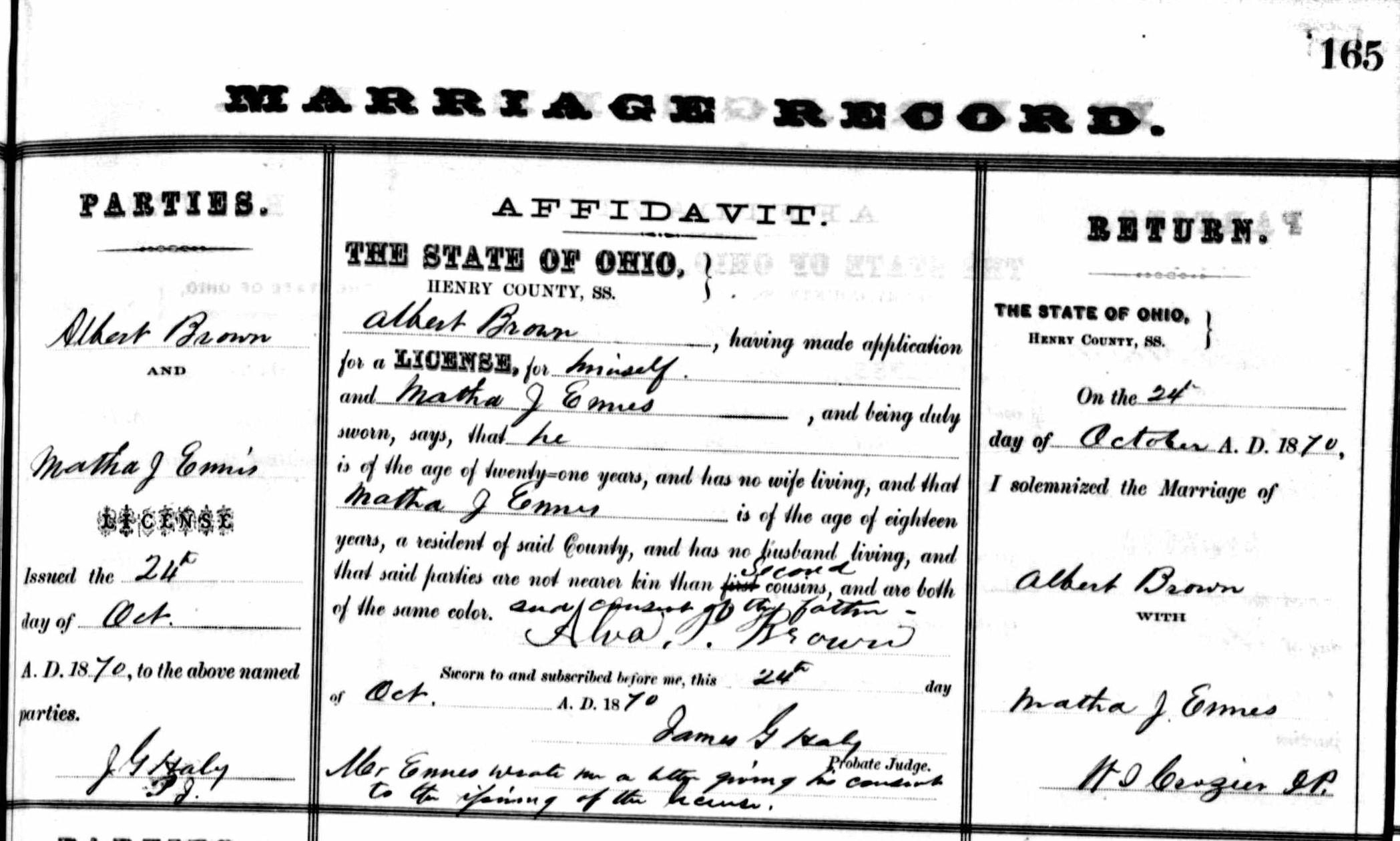
and return,
Albert Brown and
Matha J. Ennis,
24 October 1870
and return,
Alva P. Brown and
Martha J. Brown,
1 August 1881
Source: Ancestry.com. Ohio, County Marriage Records, 1774-1993 [database on-line]. Lehi, UT, USA: Ancestry.com Operations, Inc., 2016. Original data: Marriage Records. Ohio Marriages. Various Ohio County Courthouses.
Ohio Compiled Marriage Index
Name: Martha J. Brown
Gender: Female
Spouse: Alva P. Brown
Spouse Gender: Male
Marriage Date: 1 Aug 1881
County: Henry
State: Ohio
Source: Ancestry.com. Ohio, Compiled Marriage Index, 1803-1900
[database on-line]. Provo, UT, USA: Ancestry.com Operations Inc, 2001.
Original data: Jordan Dodd, Liahona Research. Ohio, Marriages,
1803-1900. Full list of sources in the description.
Ohio, County Marriages
Name: Orlie E. Brown
Event Type: Marriage
Event Date: 10 Dec 1900
Event Place: Lucas, Ohio, United States
Age: 24
Birth Year (Estimated): 1876
Birthplace: Pine Hill, N. Y.
Father's Name: F. C. Brown
Mother's Name: Avis A. Earl
Spouse's Name: Mamie T. Tholl
Spouse's Age: 19
Spouse's Birth Year (Estimated): 1881
Spouse's Birthplace: Toledo
Spouse's Father's Name: John P. Tholl
Spouse's Mother's Name: Mary Gerhardt
Reference ID: p 88 cn 2351
GS Film Number: 909008
Digital Folder Number: 004017195
Image Number: 00087
Source: "Ohio, County Marriages, 1789-1994," index and images,
FamilySearch (https://familysearch.org/pal:/MM9.1.1/XZLR-VGT :
accessed 24 Apr 2014), F. C. Brown in entry for Orlie E. Brown and
Mamie T. Tholl, 10 Dec 1900; citing Lucas, Ohio, United States,
reference p 88 cn 2351; FHL microfilm 909008.
Indiana Select Marriages Index
Name: Alva P. Brown
Gender: Male
Marriage Date: 14 Aug 1888
Marriage Place: Fulton, Indiana
Spouse: Louisa Thoman
FHL Film Number: 1871126
Reference ID: 223
Source: Ancestry.com. Indiana, Select Marriages Index, 1748-1993
[database on-line]. Provo, UT, USA: Ancestry.com Operations, Inc.,
2014. Original data: Indiana, Marriages. Salt Lake City, Utah:
FamilySearch, 2013.
Divorce Record of Alva and Martha (Ennis) Brown
Court of Common Pleas, began and held at the Court House in Napoleon in the County of Henry and State of Ohio, on the 25th day of January A.D. 1881. Before the Hon. J.J. Moore Judge of said Court. Be it remembered that on the 1st day of November A.D. 1880 was filed in the Clerk’s office of said Court the following Petition for Divorce to wit:
| Martha Brown, Plaintiff. | The Court of Common Pleas of Henry |
| Against | County and State of Ohio |
| Alva Brown, Defendant. | Petition for Divorce |
The said Martha Brown Plaintiff and Petitioner of said County of
Henry respectfully represents to this Court that she has been for the
year last past and more the resident of the State of Ohio and is now a
bona fide resident of the said County of Henry. This plaintiff further
says, and showeth that on or about the 17th day of October A.D. 1870,
at Texas in said Henry County and State of Ohio, she was married to
one Alva Brown of the same place and whom she prays may be made apart,
defendant in this petition, and that she had while living with the
said Alva Brown the following Children which are now living to wit
Alva Beecher Brown seven years old, Alonzo Orsmas Brown, four years
old, Bertha Amanda Brown, two years old, and Ardella Margaret Brown,
an infant six weeks old. And this plaintiff further shows that the
said Alva Brown defendant regardless of his marital duties toward said
plaintiff has been guilty of gross neglect and Extreme cruelty toward
said plaintiff, that on or about the 21st day of October 1880, the
said defendant violently took hold of this plaintiff and then and
there pinched and shook her in a violent manner and then threatened to
throw her said plaintiff into the street and plaintiff further says
that said defendant on the 24th day of October 1880 again took hold of
said plaintiff in a violent and forcible manner and then and there
shook her, pinched and twisted her arms around and so injured it that
she could not use it properly for the soreness and lameness thereof in
consequence of the injury produced thereby. And this plaintiff further
says that said defendant on the 18th day of October 1880 abandoned
said plaintiff and took with him all the household goods and
provisions belonging to the family and all the clothing of said
plaintiff & her children except what they had on, taking then and
there even the pillow from under their infant child lying in a rocking
chair.
And this plaintiff further says that she has in her own right the
title in fee simple of the following real estate to wit:— The South
West quarter of the South West quarter of Section 25 and 25 acres off
of the North and off of the North West quarter of Section 36 in Town
6, North of Range 8 East in Henry County, Ohio, also in same Town and
Range the NE ¼ of the NE ¼ of Section 35, on which last tract there is
a mortgage of $600.00. And this plaintiff says that said defendant is
the owner in fee simple of the East half of the South East quarter of
Section 26 in Town 6 North Range 8 East aforesaid less 20 acres off of
the North side, and 20 acres off of the South side thereof
constituting 40 acres of land.
Your petitioner this plaintiff therefore prays that the said Alva
Brown may be duly notified of this petition according to law, that he
be required to answer the same and that on the final hearing hereof
she may be divorced from said Alva Brown that the custody of said
children may be decreed to her, that a reasonable alimony may be
allowed her and for such other and further relief as the nature of her
case and equity may require.
Martha Brown= By J.H. Tyler, her atty.
Martha Brown
vs.
Precipe.
Alva Brown
Issue summons against said defendant together with a certified
copy of this petition returnable according to law.
Oct. 30, 1880
J.H. Tyler, Pltfs. atty.
(-- for) costs: A.M. Willard
Afterwards on the first day of November A.D. 1880 was issued from the
Clerk’s office of said Court the following Summons in Divorce to wit:
Summons In Divorce
| The State of Ohio | To the Sherrif of Henry County: |
| Henry County | You are commanded to notify Alva Brown that Martha Brown has |
filed in the office of the Clerk of the Court of Common Pleas of
Henry County and State of Ohio a petition (a copy of which is herewith
served in him) charging him with Gross neglect of duty and extreme
cruelty and asking that she be divorced from him and that alimony be
allowed her and for other proper relief said petition will (stand --
--) during the term of said Court next ensuing, and six weeks from and
after the
(--)
the 15th day of November A.D. 1880.— Witness my signature as Clerk of
our said Court of Common Pleas at the – of said Court at Napoleon this
1st day of November A.D. 1880.
O. E. Barnes
Summons endorsed as follows to wit
Henry Common Pleas = Martha Brown = against = Alva Brown. Summons on
petition for Divorce and alimony. J.H. Tyler, Pltfs. atty. Summons
returned endorsed as follows: to wit:
Received 10 o’clock A.M. on the 2nd day of November A.D. 1880 and on
the 11th day of November A.D. 1880, I served the same by delivering to
the within named (defendant –) thereof also in the same day and at the
same time served on the within named defendant a certified copy of the
petition.
Geo. Daum, Sheriff.
Fees $3.05
By E.B.
Barnes, Dpty
“
And afterwards on the 24th day of January A.D. 1881 was filed in the Clerk’s office of said Court the following Answer to wit:
| Martha J Brown.—Plaintiff. | The State of Ohio, Henry County Court of |
| Against | Common Pleas |
| Alva P Brown.—Defendant. | Answer and Cross Petition |
And so comes the said Alva Brown Defendant and for answer to the said
Martha J Brown plaintiff’s petition saith: That he admits that he was
married to said plaintiff as she in her said petition hath averred and
that they are now husband and wife. That as the fruits of said
marriage they have the children as set out in plaintiff’s petition and
that the time of the commencement of this action the owner of the
lands as stated and described in plaintiff’s petition: said defendant
denies each and every other allegation contained in plaintiff’s
petition and said defendant by way of cross-petition says: that said
plaintiff disregarding her duties of a wife toward said defendant she
has been guilty of gross neglect of duty toward this said defendant
that on or about the 18th day of October A.D. 1880 said plaintiff
deserted said defendant and has ever since been absent and away from
her said husband and family without any fault or provocation on the
part of said defendant. Defendant further shows that the said Martha
J. Brown regardless of her marital duties toward said defendant did on
the 17th day of May A.D. 1880 at the house of said defendant in the
Township of Washington, in the County of Henry, and the State of Ohio,
commit adultery with one Ely Bolinger and that also on the 14th or
15th of May, also on the 25th of April A.D. 1880 at said defendant’s
house did commit adultery with said Ely Bolinger and at other and
sundry times the dates of which cannot be given exact. And also when
said Bolinger was away kept up an improper correspondence by letters
with said Bolinger.
Said defendant therefore prays that he may on the final hearing of
this cause be divorced from the said Martha J Brown, and that the
custody of the said children may be decreed to said defendant and for
such other and further relief the nature of his case and equity may
require.
Alva P Brown
By John A King, Attorney for defendant
And afterward at the January Term A.D. 1881. (To wit Febry 11th/81) came the following Journal Entry to wit:
Martha Brown No
702 Petition for Divorce
vs And vows
the said parties by their attorneys and thereupon this
Alva Brown
cause came on for hearing upon the petition of said plaintiff the
answer and cross-petition of said defendant the plaintiff’s reply
thereto and testimony, and was argued by counsel on consideration
whereof the Court finds due notice of the filing and pendency of this
petition was given and personally served on said defendant together
with a certified copy of said petition by the Sheriff of this County
according to law, and the Court further finds that the said defendant
has been guilty of extreme cruelty toward said plaintiff as she in her
said petition has alleged, and the Court further finds that each of
said parties hereto is seized in fee simple of the real estate in
plaintiff’s petition described.
It is therefore adjudged and decreed the marriage relation heretofore
existing between said parties be and the same is hereby set aside and
wholly annulled and the said parties wholly released from the
obligations of the same; and it is further adjudged and decreed that
said defendant do pay to said plaintiff for her reasonable alimony the
sum of $250, payable as follows to wit: $50 in Thirty days from this
date, $50 in six months thereafter, $50 in Twelve months, $50 in
Eighteen months.— and $50 in Two Years:
And it is further ordered and adjudged that said judgment and decree
for the sum of $250 as aforesaid rendered be and the same is hereby
made a lien from this date upon the lands of said defendant which are
in plaintiff’s petition described to wit: The East half of the South
East quarter of Section 26 in Town 6 North Range Eight (8) East in
Henry County, Ohio less 20 acres off of the North side and 20 acres
off of the South side thereof: containing 40 acres of land.
And it is further ordered adjudged and decreed that said plaintiff be
and she is hereby given the custody, nurture, education, and care of
said Alva Beecher Brown, Alonzo Omas Brown, Bertha Amanda Brown, and
Ardella Margaret Brown, until the further order of this Court. And it
is further ordered that said plaintiff pay all the costs of this
action and proceedings and taxed to $
except the costs of said defendant’s witnesses.
J.J. Moore
Presiding Judge of said Court.
Source: Martha J. Brown v. Alva P. Brown, from Complete Record, Henry Common Pleas, January Term, A.D. 1881, transcription of a photocopy in possession of Darryl W. Boyd.
Images of the death certificates are shown below as thumbnails. Click on each of the thumbnails to view a larger version of the certificates in another tab.
Michigan
Source: Ancestry.com. Michigan, Death Records, 1867-1950 [database on-line]. Provo, UT, USA: Ancestry.com Operations, Inc., 2015. Original data: Death Records. Michigan Department of Community Health, Division for Vital Records and Health Statistics, Lansing, Michigan.
Florida

F. C. Brown,
16 Jan 1912
Click here for
column headings
Source: Tampa, Florida death and cemetery records, 1896-1921; index, 1896-1958, FHL Film 1673803 Item 2 (Death records, v. 1, 1899 - Sept. 1918), Image 142 of 491, accessed 27 June 2020.

F. C. Brown,
19 Jan 1912
Click here for
column headings

continued
Click here for
column headings
Source: Tampa, Florida death and cemetery records, 1896-1921; index, 1896-1958, FHL Film 1673803 Item 3 (Record of burial and transportation permits issued, Nov. 1907 - Sept. 1910), Image 285 of 491, accessed 27 June 2020.
Name: Emily J. Boyd
Event Type: Death
Event Date: 2 Jul 1929
Event Place: Tampa, Hillsborough, Florida, United States
Event Place (Original): Tampa, Hillsborough County, Florida
Address: 3205 Fielder
Gender: Female
Age: 78
Marital Status: Married
Ethnicity: American
Race: White
Occupation: Housewife
Birth Date: 2 Oct 1850
Birthplace: New York
Burial Date: 3 Jul 1929
Cemetery: Tampa Memorial Park
Father's Name: Orcimus Brown
Father's Birthplace: New York
Mother's Name: Dianthy Parks
Mother's Birthplace: New York
Spouse's Name: John Boyd
Reference ID: 394
GS Film Number: 2135293
Digital Folder Number: 4031640
Image Number: 394
Indexing Project (Batch) Number: B06323-8
Record Number: 91
Source: "Florida Deaths, 1877-1939", database, FamilySearch (https://familysearch.org/ark:/61903/1:1:FP8S-7FV : 8 August 2019), John Boyd in entry for Emily J. Boyd, 1929.
Images of newspaper articles are shown below as thumbnails. Click on each thumbnail to view a larger version of the article in another tab.
Orsemus Brown
Progressive Batavian:
Orsemus Brown, formerly a well-known citizen of Elba, died at the
residence of his son, T. D. Brown, of Canandaigua, Aug. 7th, aged 83
years. He was born in Oneida county, N. Y., in 1810; and at the age of
ten years was left an orphan, his father having been murdered and
robbed. Calvin Brown, a well-known pioneer settler in Elba, took
Orsemus to his home and reared him up to manhood. Jan 1st, 1838, he
united in marriage with Miss Diantha Park, of Elba, a woman of
remarkable energy and enterprise. This union was blessed with five
children, all of whom are living. T. D. Brown, of Canandaigua; Alva P.
Brown, of Southern Indiana; George W. Brown, of Michigan; Franklyn C.
Brown, of Little Sioux, Iowa; and Mrs. Emma J. Boyd, of North Dakota.
And it is not a little remarkable that no death occurred in the family
until in February last when Mrs. Brown, the devoted wife and mother,
died. For a number of years, Mr. Brown has been in poor health and for
a time he was entirely helpless, but was entirely cared for by his
son, T. D. Brown. His remains reached Elba Tuesday evening and were
laid in the old cemetery by the side of his companion and other
relatives. The brief service at the grave was by his former pastor,
Rev. E. A. Wheat.
Source: Progressive Batavian (Batavia, NY), August 11, 1893.
Diantha (Parks) Brown
Daily News (Genesee county, New York):
Mrs. O Brown, formerly a resident of Elba, died at 4 o’clock this
morning at her home in Canandaigua, her death being attributed to
heart failure. The remains will be taken to Elba for internment, the
funeral services to be held at the Methodist church at that village
tomorrow afternoon at 2 o’clock. Mrs. Brown is survived by her
husband.
Source: Daily News, Genesee County, NY, January 28 1893.
Progressive Batavian:
Mrs. Diantha Brown, wife of Orsemus Brown, of Canandaigua, formerly of
Elba, died at the residence of her son, T. D. Brown, at Canandaigua
Jan. 28th, 1893, aged 77 years, 7 months and 12 days. She was the
daughter of George and Mary Parks, early settlers in Elba, and was
born Jun 16th, 1815, in Elba. She was one of the oldest of 13
children, three of whom survive her, A. M. Parks, of Hudson, Mich.,
Geo. W. Parks, of Lansing, Mich., and Mrs. H. Hodges, of Eaton Rapids,
Mich. Some 56 years ago she united in marriage with Mr. Brown, who
survives her, with five children, four sons and one daughter. The
health of her companion has been quite poor for some time, and her
anxiety and labor for him doubtless hastened the end. She died of
general prostration and heartfailure. Mrs. Brown was a woman of a
genial and social spirit, always intent on helping where help was
needed. For many years she was an honored member of the Methodist
Protestant church in Elba and died in great peace. Conscious to the
last she stated her wishes respecting her funeral services. Her
remains reached Elba Sunday and her funeral was attended at the
Methodist church at 2 p.m., conducted by Rev. E. A. Wheat, assisted by
Rev. A. L. Stinard. The choir furnished very good music.
Source: Progressive Batavian, February 3, 1893.
Source: "Michigan Obituaries, 1820-2006," database with images, FamilySearch (https://familysearch.org/ark:/61903/1:1:QVP1-G2BF : 1 April 2020), A M Parks in entry for Diantha Brown, 1893; citing , Obituary, Grand Rapids Public Library, Michigan; FHL microfilm 7,615,428.
Tristram Delos Brown

The Buffalo
Commercial, Buffalo,
New York, Friday,
6 Oct 1893, p. 7.

The Buffalo
Commercial, Buffalo,
New York, Friday,
6 Jul 1900, p. 5.
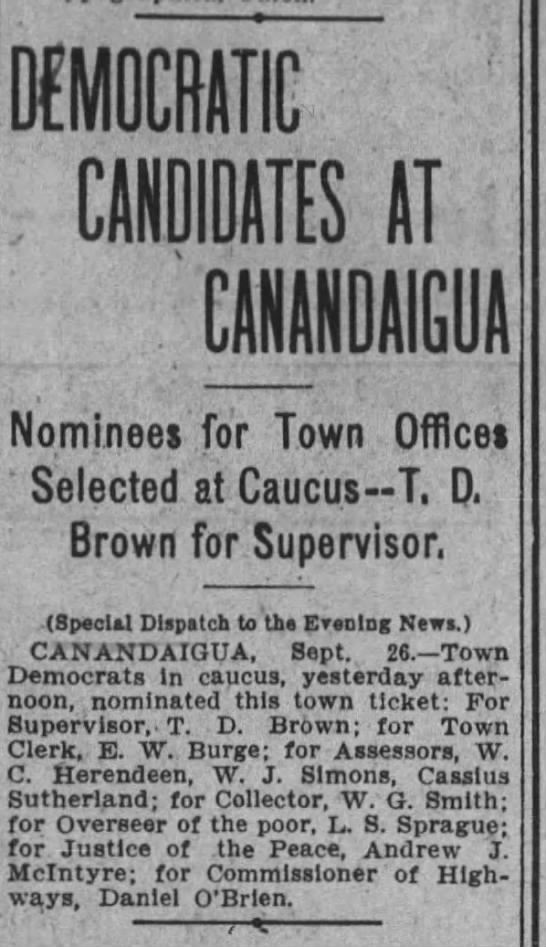
Candidates at
Canandaigua,"
Buffalo Evening
News, Buffalo, New
York, Thursday,
26 Sep 1907, p. 20.
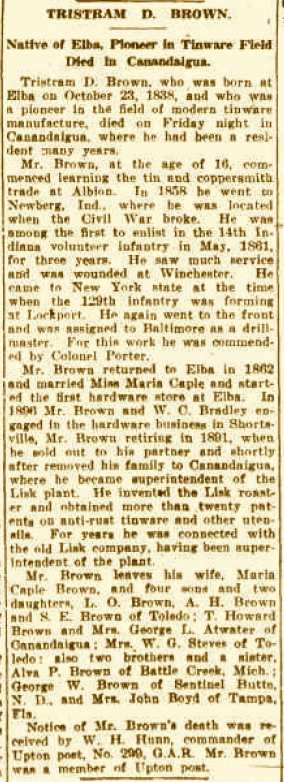
D. Brown, Batavia
Daily News (Batavia,
NY), 19 April 1920.
Alva Parks Brown
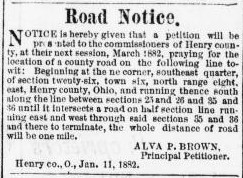
Democratic
Northwest and
Henry County
News, Napoleon,
OH, 9 February
1882.

Sale," Democratic
Northwest and Henry
County News,
Napoleon, OH, 3
January 1884.
Introduction: "The land,
lots, and parts of lots
returned delinquent by
the Treasurer of Henry
County, together with
the taxes and penalty
charge thereon
agreeably to law, are
contained and
described in the
following list, to-wit:
Washington Township"
Column headings
are: Owners, Section,
Description, Acres, Value,
Tax
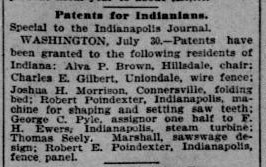
Indianians," The
Indianapolis Journal,
Indianapolis, IN, 31
July 1895. Available
at Chronicling
America (Library of
Congress).
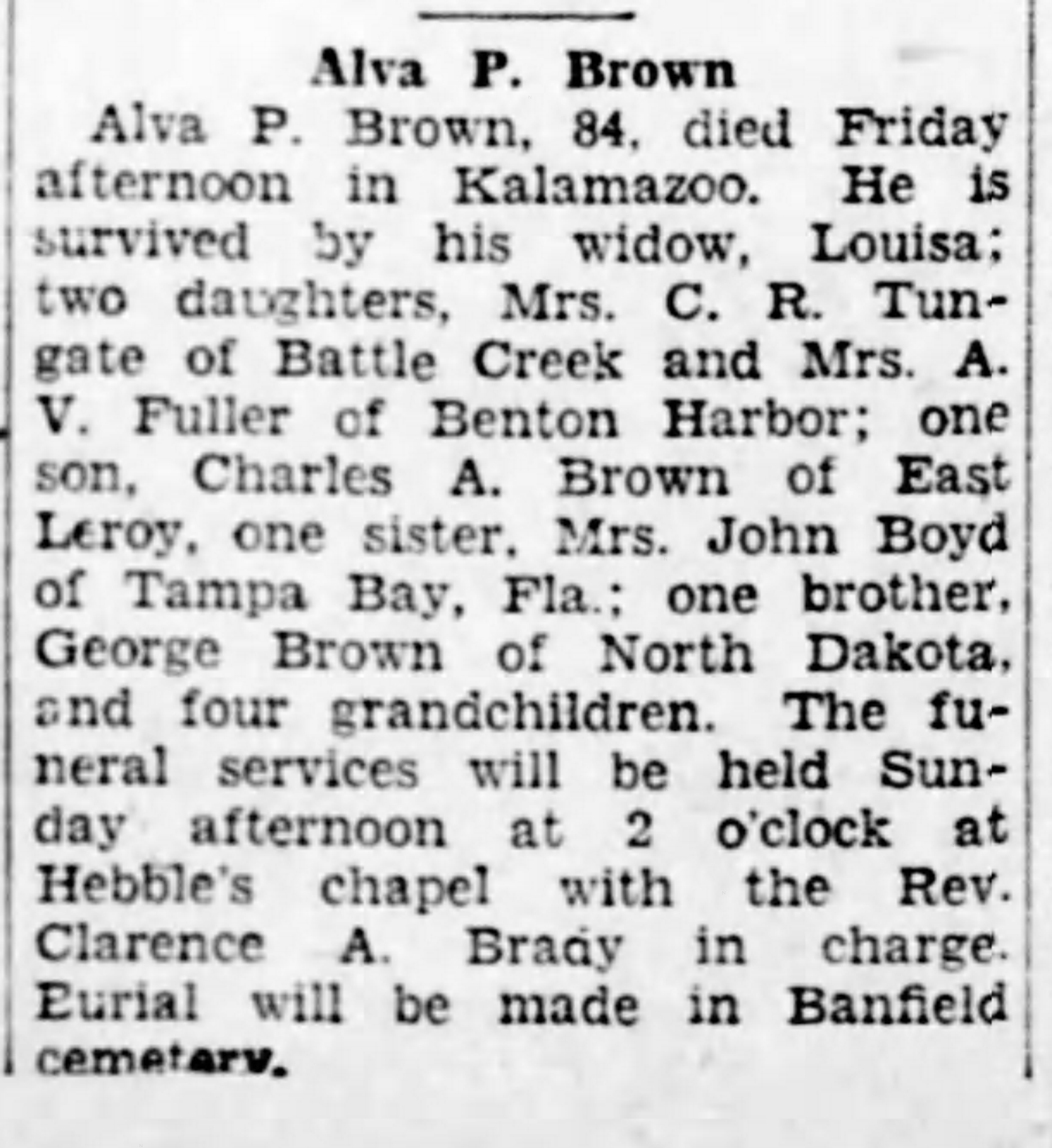
Brown, Battle Creek
Enquirer (Battle Creek,
MI), Saturday 15 June
1929.
Alva Parks and Martha Jane (Ennis) Brown

Mr. Alva Brown and
Mrs. Martha J. Brown,
Democratic Northwest
and Henry County
News, Napoleon, OH,
18 August 1881.
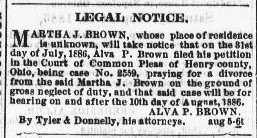
Democratic Northwest
and Henry County
News, Napoleon, OH,
5 August 1886.
Note: This notice was
also published in the
same newspaper in
different issues through
August and September
of 1886.

Alva P. Brown and
Martha J. Brown,
Democratic Northwest
and Henry County
News, Napoleon, OH,
7 October 1886.
Louisa (Thoman) Brown
Sarah Maria (Strong) Brown
Franklin C. Brown

Down by Dr. Efird's
Auto; Killed," The
Tampa Times
(Tampa, FL),
Wednesday, 17
Jan 1912, p. 9.

by Auto, Brown
Dies," The Tampa
Tribune (Tampa,
FL), Wednesday,
17 Jan 1912, p. 12.
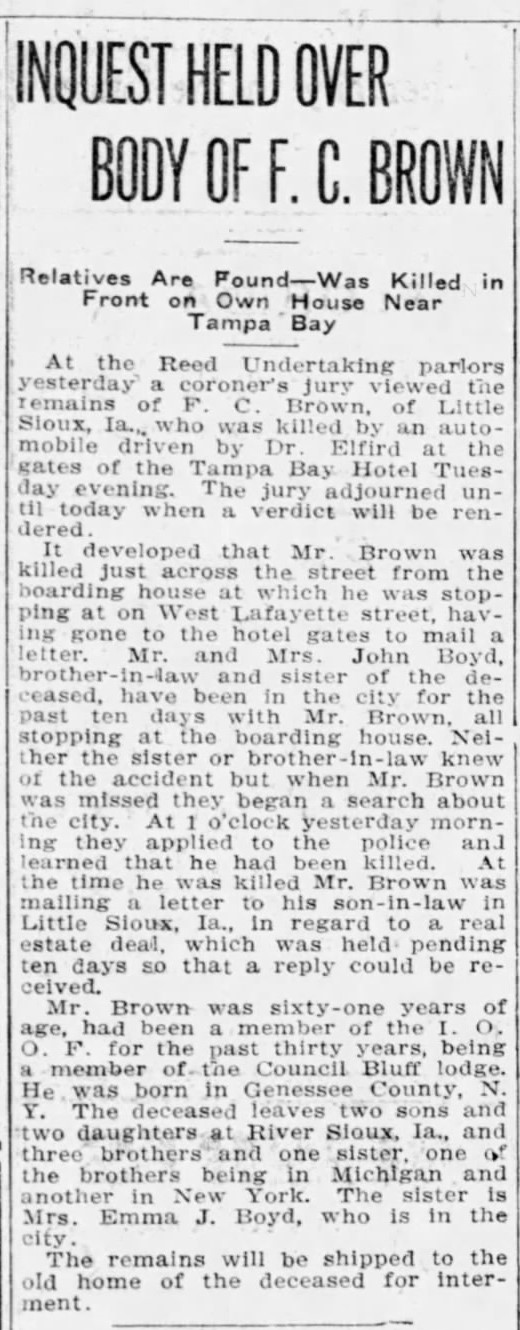
Body of F. C.
Brown," The Tampa
Tribune (Tampa, FL),
Thursday, 18 Jan
1912, p. 11.
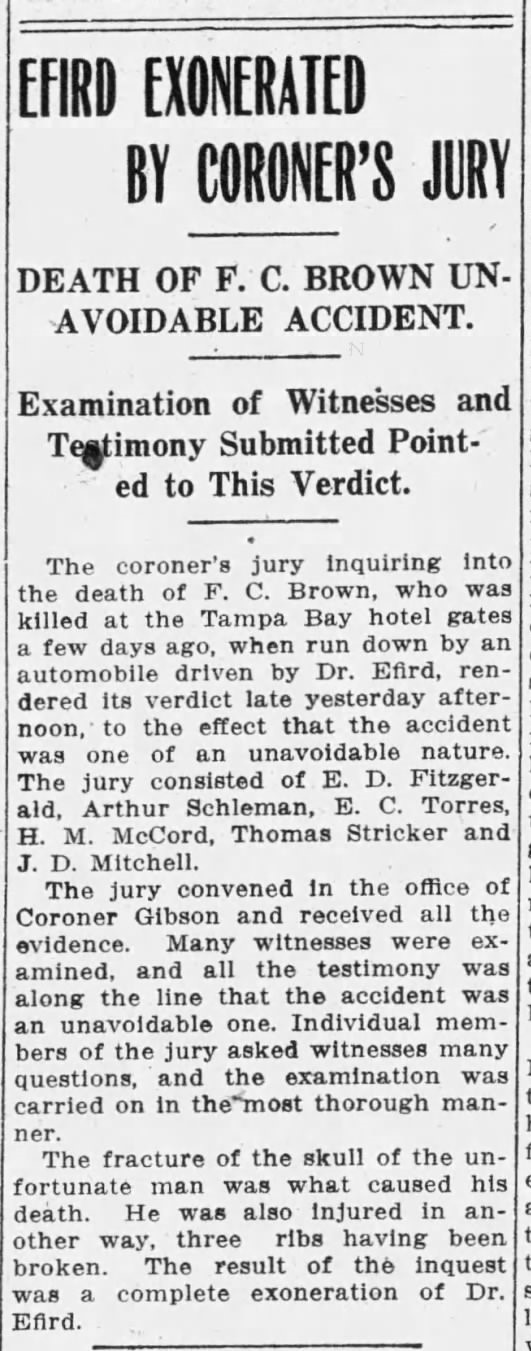
by Coroner's Jury,"
The Tampa Times
(Tampa, FL), Friday,
19 Jan 1912, p. 14.
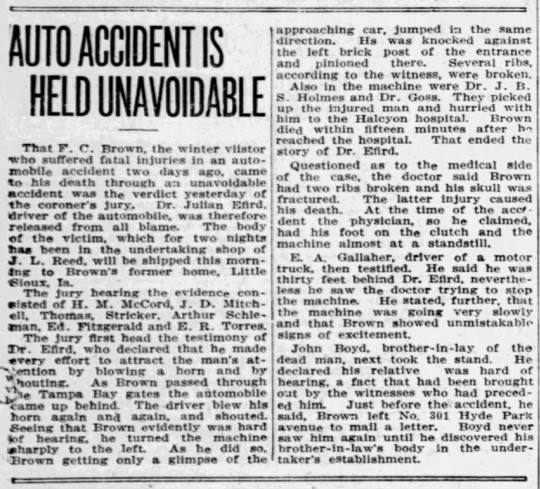
Held Unavoidable,"
The Tampa Tribune
(Tampa, FL), Friday,
19 Jan 1912, p. 3.
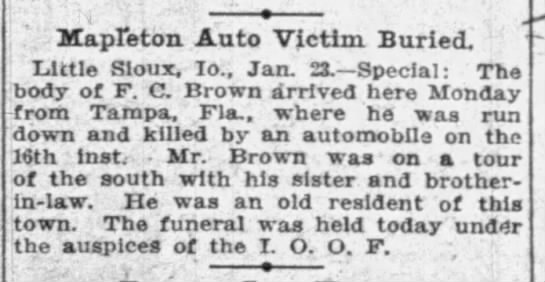
Victim Buried,"
Sioux City Journal
(Sioux City, IA),
Wednesday, 24
Jan 1912, p. 4.
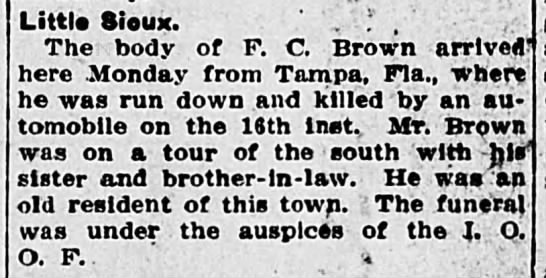
Items," Evening
Times-Republican
(Marshalltown, IA),
Thursday, 25 Jan
1912, p. 3.
Emma J. (Brown) Boyd
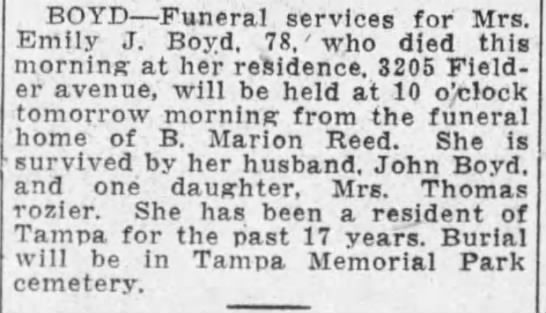
funeral services of
Mrs. Emily J Boyd,
The Tampa Times
(Tampa, FL),
Tuesday, 2 Jul
1929, p. 2.
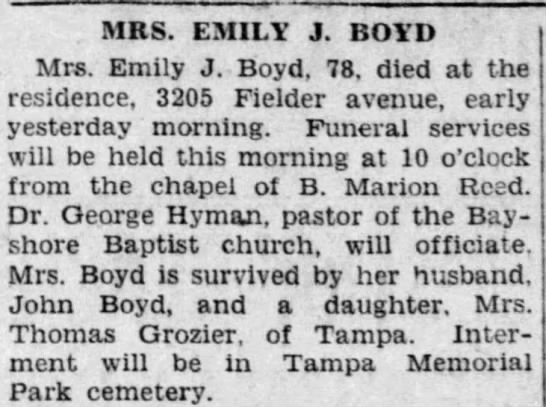
Emily J. Boyd,
The Tampa Tribune
(Tampa, FL),
Wednesday, 3 Jul
1929, p. 2.
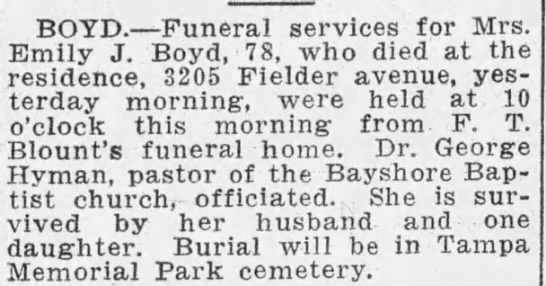
funeral of Mrs. Emily
J Boyd, The Tampa
Times (Tampa, FL),
Wednesday, 3 Jul
1929, p. 2.
Lowelia Jennie (Bowen) Grozier
Copies of census records are shown below as thumbnails. Click on each thumbnail to view a larger version of the record in another tab.
1840
Elba, Genesee, New York

Orsamus L Brown;
Year: 1840;
Census Place: Elba,
Genesee, New York;
Roll: 287;
Page: 635;
FHL Film: 0017188
Source: Sixth Census of the United States, 1840. (NARA microfilm publication M704, 580 rolls). Records of the Bureau of the Census, Record Group 29. National Archives, Washington, D.C.
1850
Byron, Genesee, New York
Oakfield, Genesee, New York

Robert Caple;
Year: 1850;
Census Place:
Oakfield, Genesee,
New York;
Roll: 508;
Page: 292A

Robert Caple,
continued
Alexander, Genesee, New York

David Bowen;
Year: 1850;
Census Place:
Alexander, Genesee,
New York;
Roll: 507;
Page: 152A
Source: Seventh Census of the United States, 1850; (National Archives Microfilm Publication M432, 1009 rolls); Records of the Bureau of the Census, Record Group 29; National Archives, Washington, D.C.
1860
Byron,
Genessee, New York
Elba,
Genessee, New York

Robert Caple;
Year: 1860;
Census Place: Elba,
Genesee, New York;
Page: 44;
FHL Film: 803757
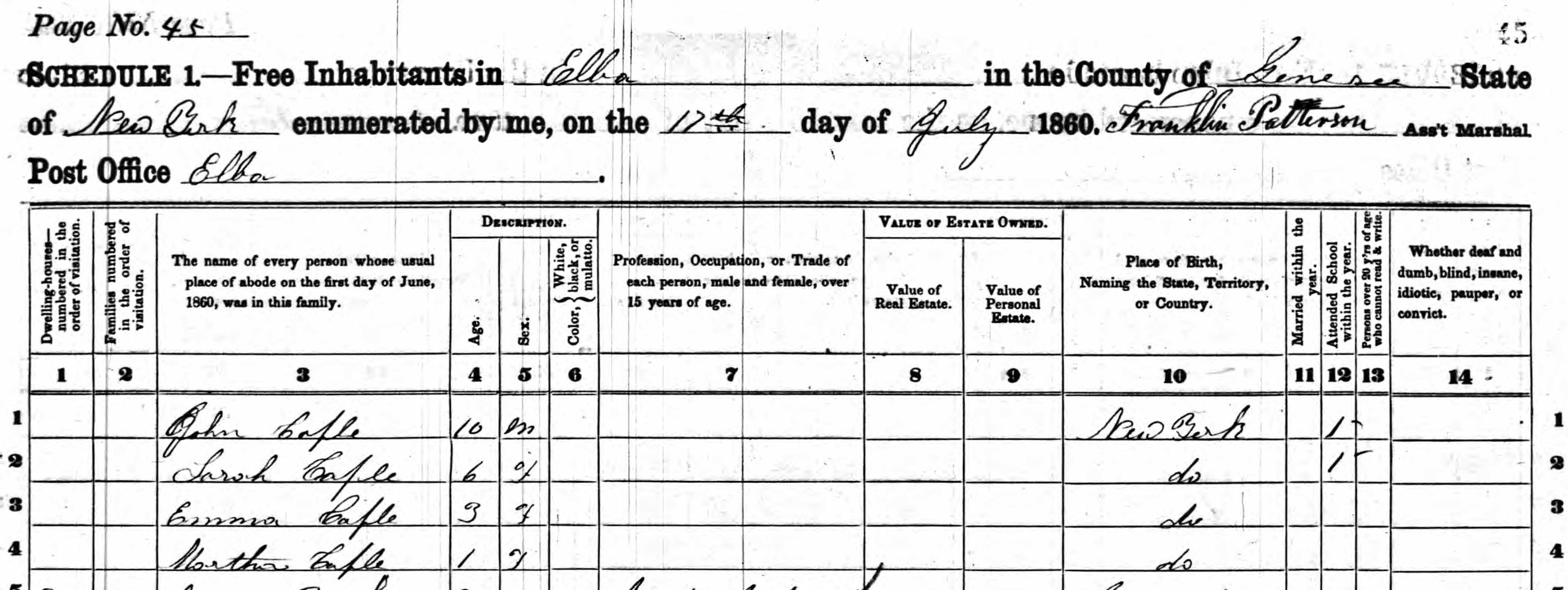
Robert Caple,
continued
Alexander,
Genessee, New York

David Bowen;
Year: 1860;
Census Place:
Alexander, Genesee,
New York;
Page: 1031;
FHL Film: 803756
Source: 1860 U.S. census, population schedule. NARA microfilm publication M653, 1,438 rolls. Washington, D.C.: National Archives and Records Administration, n.d.
1870
Alexander, Genesee, New York

(Orsems?) Brown;
Year: 1870;
Census Place:
Alexander, Genesee,
New York;
Roll: M593_939;
Page: 378B;
FHL Film: 552438

David Bowen;
Year: 1870;
Census Place:
Alexander, Genesee,
New York;
Roll: M593_939;
Page: 378B;
FHL Film: 552438
Source: 1870 U.S. census, population schedules. NARA microfilm publication M593, 1,761 rolls.
1870 Agricultural Schedule
Alexander, Genesee, New York
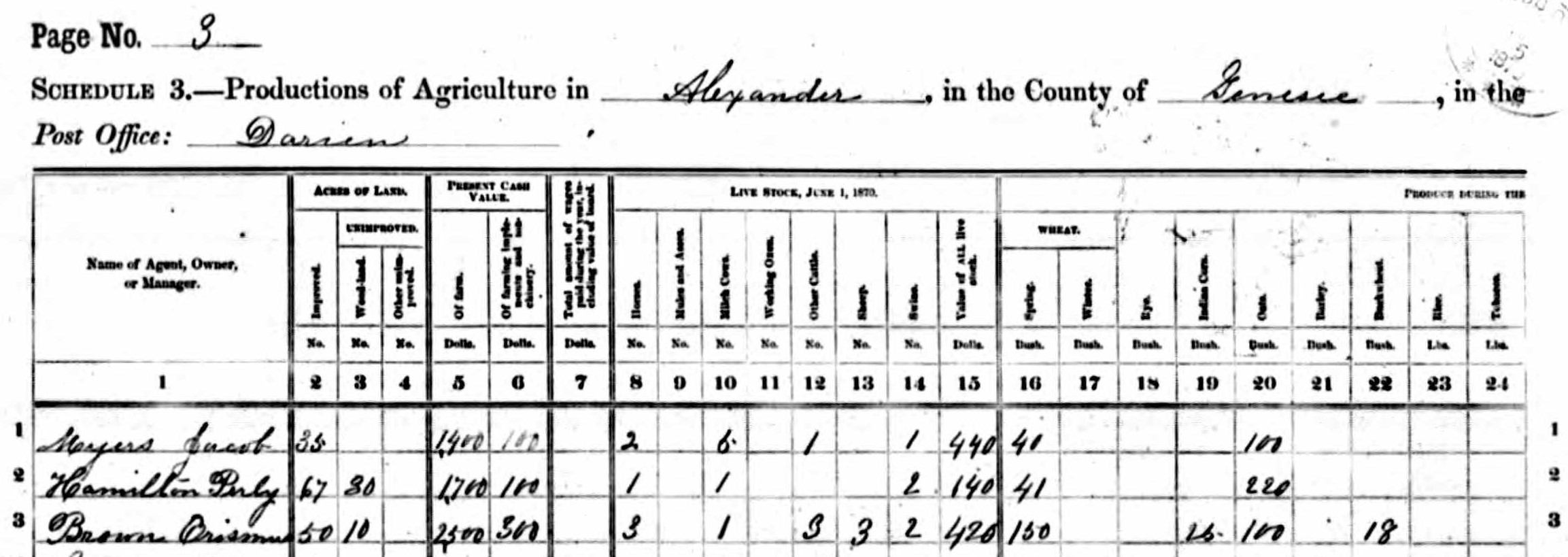
Orismus Brown;
Census Year: 1870;
Census Place:
Alexander, Genesee,
New York;
Archive Collection
Number: A23;
Roll: 23;
Page: 3;
Line: 1;
Schedule Type:
Agriculture
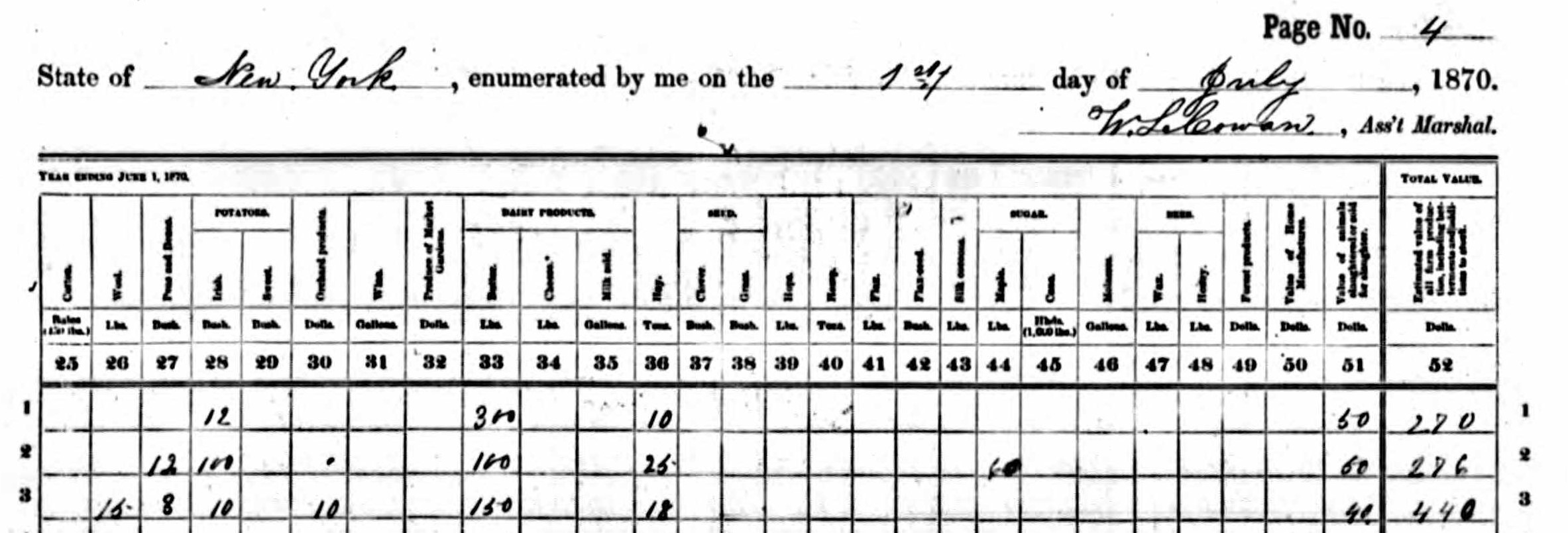
Orismus Brown,
continued
Source: 1870 U.S. census, population schedules. NARA microfilm publication M593, 1,761 rolls.
1880
Elba, Genesee, New York

Tristram D. Brown;
Year: 1880;
Census Place: Elba,
Genesee, New York;
Roll: 835;
Page: 543C;
Enumeration District:
010
Alexander, Genesee, New York

Cashius Bowen;
Year: 1880;
Census Place:
Alexander, Genesee,
New York;
Roll: 835;
Page: 363C;
Enumeration District:
002
Washington, Henry, Ohio

Alva P. Brown,
Orsmus
Brown;
Year: 1880;
Census Place:
Washington, Henry,
Ohio;
Roll: 1032;
Page: 59C;
Enumeration District:
110
Maple Grove, Barry, Michigan

George W. Brown;
Year: 1880;
Census Place:
Maple Grove,
Barry, Michigan;
Roll: 570;
Page: 166B;
Enumeration District:
043
Little Sioux, Harrison, Iowa

F C Brown;
Year: 1880;
Census Place: Little
Sioux, Harrison, Iowa;
Roll: 343;
Page: 10B;
Enumeration District:
080
Source: Tenth Census of the United States, 1880. (NARA microfilm publication T9, 1,454 rolls). Records of the Bureau of the Census, Record Group 29. National Archives, Washington, D.C.
1900
Canandaugua, Ontario, New York

Tristram D. Brown;
Street: Gorham
Street;
Year: 1900;
Census Place:
Canandaigua Ward
2, Ontario, New York;
Page: 8;
Enumeration District:
0054;
FHL microfilm: 1241138
Helt, Vermillion, Indiana
Spring, Lincoln, Arkansas
Little Sioux, Harrison, Iowa

Frank Brown;
Year: 1900;
Census Place: Little
Sioux, Harrison, Iowa;
Page: 1;
Enumeration District:
0083;
FHL microfilm: 1240436
Baltimore, Barry, Michigan

John Boyd;
Year: 1900;
Census Place:
Baltimore, Barry,
Michigan;
Page: 8;
Enumeration District:
0034;
FHL microfilm: 1240700
District 2, Billings, North Dakota

Thomas Grozier;
Year: 1900;
Census Place:
District 2, Billings,
North Dakota;
Page: 1;
Enumeration District:
0017;
FHL microfilm: 1241226
Source: United States of America, Bureau of the Census. Twelfth Census of the United States, 1900. Washington, D.C.: National Archives and Records Administration, 1900. T623, 1854 rolls.
1910
Canandaigua, Ontario, New York

Tristram D. Brown;
Street: West Lake
Shore Road;
Year: 1910;
Census Place:
Canandaigua,
Ontario, New York;
Roll: T624_1058;
Page: 8A;
Enumeration District:
0078;
FHL microfilm: 1375071
Baltimore, Barry, Michigan

Alva P. Brown;
Roll: T624_636;
Page: 9B;
Enumeration District:
0036;
FHL microfilm: 1374649

John Boyd;
Year: 1910;
Census Place:
Baltimore, Barry,
Michigan;
Roll: T624_636;
Page: 9B;
Enumeration District:
0036;
FHL microfilm: 1374649
Eaton Rapids, Eaton, Michigan

Paulina Strong;
Year: 1910;
Census Place: Eaton
Rapids Ward 3,
Eaton, Michigan;
Roll: T624_645;
Page: 15B;
Enumeration District:
0086;
FHL microfilm: 1374658
Little Sioux, Harrison, Iowa

William H. Eyer;
Year: 1910;
Census Place: Little
Sioux, Harrison, Iowa;
Roll: T624_405;
Page: 1A;
Enumeration District:
0078;
FHL microfilm: 1374418
Source: Thirteenth Census of the United States, 1910 (NARA microfilm publication T624, 1,178 rolls). Records of the Bureau of the Census, Record Group 29. National Archives, Washington, D.C.
1920
Battle Creek, Calhoun, Michigan
Kalamazoo, Kalamazoo, Michigan

Kalamazoo State
Hospital;
Building: Main
Building;
Inmate: Alva P. Brown;
Roll: T625_759;
Page: 9B;
Enumeration District:
49
Eaton Rapids, Eaton, Michigan

Sarah S. Brown;
Year: 1920;
Census Place:
Eaton Rapids, Eaton,
Michigan;
Roll: T625_763;
Page: 9A;
Enumeration District:
100
Sentinel Butte, Golden Valley, North Dakota

Jay W. Brown;
Street: Brook Street;
Year: 1920;
Census Place:
Sentinel Butte, Golden
Valley, North Dakota;
Roll: T625_1334;
Page: 7A;
Enumeration District:
68
Ballast Point, Hillsborough, Florida

John Boyd;
Street: Hills Ave.;
Year: 1920;
Census Place:
Ballast Point,
Hillsborough, Florida;
Roll: T625_222;
Page: 9B;
Enumeration District:
34
Source: Fourteenth Census of the United States, 1920. (NARA microfilm publication T625, 2076 rolls). Records of the Bureau of the Census, Record Group 29. National Archives, Washington, D.C.
1930
Battle Creek, Calhoun, Michigan

Louisa Brown;
Street Name:
W. Van Buren;
Page: 8B;
Enumeration District:
0018;
FHL microfilm: 2340713
Eaton Rapids, Eaton, Michigan

David H. Brown;
Street: Brook Street;
Year: 1930;
Census Place:
Eaton Rapids,
Eaton, Michigan;
Page: 22A;
Enumeration District:
0014;
FHL microfilm: 2340718
Ballast Point, Hillsborough, Florida

John Boyd;
Street: Fielder St.;
Year: 1930;
Census Place:
Precinct 53,
Hillsborough, Florida;
Page: 14B;
Enumeration District:
0137;
FHL microfilm: 2340056
Precinct 63, Hillsborough, Florida

Thomas Grozier;
Year: 1930;
Census Place:
Precinct 63,
Hillsborough, Florida;
Page: 25A;
Enumeration District:
0151;
FHL microfilm: 2340056
1940
Eaton Rapids, Eaton, Michigan

Sarah S. Brown;
Street: Brook St.;
Year: 1940;
Census Place:
Eaton Rapids, Eaton,
Michigan;
Roll: m-t0627-01747;
Page: 9B;
Enumeration District:
23-15

Sarah S. Brown,
continued
Source: United States of America, Bureau of the Census. Sixteenth Census of the United States, 1940. Washington, D.C.: National Archives and Records Administration, 1940. T627, 4,643 rolls.
1875
Alexander, Genesee, New York
Oakfield, Genesee, New York
Source: Ancestry.com. New York, State Census, 1875 [database on-line]. Provo, UT, USA: Ancestry.com Operations, Inc., 2013. Original data: Census of the state of New York, for 1875. Microfilm. New York State Archives, Albany, New York.
1915
Canandaigua, Ontario, New York

Tristram D. Brown;
New York State
Archives; Albany,
New York;
State Population
Census Schedules,
1915;
Election District: 02;
Assembly District: 01;
City: Canandaigua
Ward 03;
County: Ontario;
Page: 04
Source: Ancestry.com. New York, State Census, 1915 [database on-line]. Provo, UT, USA: Ancestry.com Operations, Inc., 2012. Original data: State population census schedules, 1915. New York State Archives, Albany, New York.
Images of portions of city directory pages are shown below as thumbnails. Click on each thumbnail to view a larger version of the record in another tab.
U.S. City Directories
Brown,
Battle Creek,
Calhoun, Michigan,
City Directory, 1918
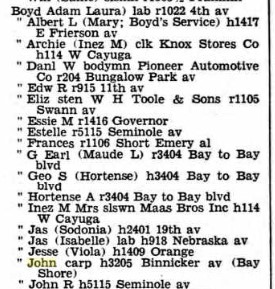
Tampa, Florida,
City Directory, 1935
Source: U.S. City Directories, 1822-1995 [database on-line]. Provo, UT, USA: Ancestry.com Operations, Inc., 2011.
Alva's patents:
View Alva's spring bed-bottom patent:
Source: Brown, Alva P. (Texas, Henry, Ohio), Improvements in Spring Bed-bottoms, US163356A, United States Patent and Trademark Office, 18 May 1875.
View Alva's bedstead patent:
Source: Brown, Alva P. (Texas, Henry, Ohio), Bedstead, US252354A, United States Patent and Trademark Office, 17 January 1882.
View Alva's chair patent:
Source: Brown, Alva P. (Hillsdale, Vermillion, Indiana), Chair, US543640A, United States Patent and Trademark Office, 30 July 1895.
Tristram's patents:
View Tristram's anti-rust vessel patent:
Source: Brown, T. D. (Canandaigua, Ontario, New York), Anti-rust Vessel, US469991A, United States Patent and Trademark Office, 1 Mar 1892.
Click on the thumbnail below to view a larger image of Tristram's bottom for metallic vessels patent (filed with David A. Lisk in 1891, published in 1892) in another tab.
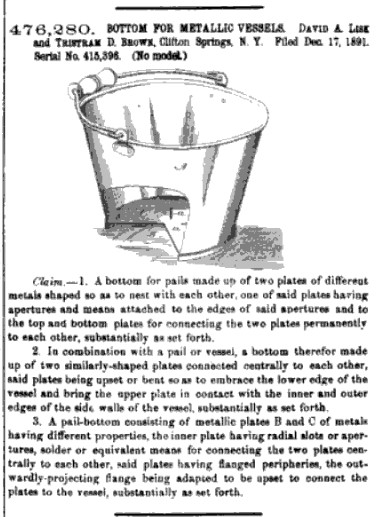
Gazette of the
United States Patent
Office, vol. 59, no.
10, 7 June 1892, p.
1452. Available at
Google Books.
View Tristram's pail, pan, washer-boiler, etc. patent:
Source: Brown, T. D. (Clifton Springs, Ontario, New York), Pail, Pan, Wash-boiler, &c., US480555A, United States Patent and Trademark Office, 9 Aug 1892.
View Tristram's oil-can patent:
Source: Lisk, David A. and Brown, Tristram D. (Clifton Springs, Ontario, New York), Oil-can, US504788A, United States Patent and Trademark Office, 12 Sep 1893.
View Tristram's pail, pan, etc. patent:
Source: Brown, T. D. (Clifton Springs, Ontario, New York), Pail, Pan, &c., US534546A, United States Patent and Trademark Office, 19 Feb 1895.
View Tristram's bottom for sheet metal vessels patent:
Source: Brown, Tristram D. (Canandaigua, Ontario, New York), Bottom for Sheet-metal Vessels, US636752A, United States Patent and Trademark Office, 14 Nov 1899.
View Tristram's oil-can patent:
Source: Brown, Tristram D. (Canandaigua, Ontario, New York), Oil-can, US933881A, United States Patent and Trademark Office, 14 Sep 1909.
Interview of Frank Richard Boyd, November 1988
Darryl “Bill” Boyd: Interview with Frank R. Boyd, Thanksgiving
Day 1988.
Alice Boyd: All right, when were you born?
Frank R. Boyd: (Laughs.) It says on my birth certificate.
AB: (Laughs.) Where you born?
FRB: Oh, in Phoenix.
AB: What was your family doing in Phoenix?
FRB: I’ll tell ya, my mom had, they thought she had
tuberculosis. She was sick and they told her to go to a warm climate
but that was up in Arkansas and from Arkansas, Mom and Dad, they went
down to Texas. And they lived in El Paso, Texas for a while. Mom had a
bakeshop there, a laundry or a bakeshop, I know, one of the two. And
my dad and my mom worked together. And when my dad got his fingers cut
off is down in there too somewhere but I’m thinking, you know…
DB: What was he doing when he got his fingers cut off?
FRB: He was in railroad. He was in railroad. That’s what they always
did. Well, then they went down there and then they went from there,
they come to live in Arizona and come to Prescott, yeah, they come to
Prescott. And there’s another town right now, I seen it on television,
it’s pretty big now, but at that time, it was just a little ol’ town
---. ‘Cause, I know ‘cause, when there in the war, I seen it. But that
was before I was born and I was born on East Van Buren Street. You
know, that’s the main drag of Phoenix, on East Van Buren, at that
time, it was a, I seen the house because Mom and Dad bought a, when
they sold their, after they sold their dairy, Mom and Dad bought a
smoke shop or, well, I can’t hardly explain what it was, but I know
they sold candy there. And it was made out of, uh…
DB: Some type of store or something?
FRB: It was a store but it was made out of old signboards. The
house, and we lived in the back of it and in the front, they, it was
next door to the house where I was born. And the house that I was born
was right next-door and I can remember it yet. They had stairs up to
the second floor and it had a big old palm tree in the front yard, I
can remember that.
AB: So that’s what they were doing when you were born? They had
a store?
FRB: No, no, that’s after. That’s just before we come to
California.
DB: Back up now, where did they get the dairy and where was that
at?
FRB: That was in Laveen, Arizona.
DB: That was after Texas.
FRB: Yeah, after I was born.
DB: OK.
FRB: And that’s that one where they had a house and I remember
the insides wasn’t finished yet, didn’t have no sheetrock. Their house
was brand new and we lived in it and we had a dairy, too, the dairy
there and they had bottling machine where they used to bottle all the
milk and we had a dairy truck that’d go deliver. They had a, it was a
little, small, regular dairy going. Not just a kind of little farm or
anything.
DB: They delivered this stuff, too, then?
FRB: They delivered, John delivered it. John went off and spent
all the money on girls and stuff and then took off and that’s, you
know that picture you seen on the train, where’s it’s on the track,
the railroad track? And you see that picture of him right here? That’s
where he didn’t tell nothing to Mom ‘cause all the money went and he
lost it all.
DB: Oh, yeah, yeah, yeah, yeah.
AB: And he took off with all the money, huh?
FRB: Yeah, well, he didn’t take off the money, he just
(laughing)…
AB: He just took off.
FRB: …He just took off. And then all the good-looking girls, he
let them have the milk for nothing, you know! You know, just kept
delivering milk, they didn’t pay the bills, and he never did collect
it.
DB: Oh, geez. So, what, they lost the dairy there?
FRB: Yeah, yeah, and that’s down there where I first started the
school, Levine, in Laveen, Arizona. That’s when I, Julia was going to
school, too, at the same school, my sister Julia.
DB: Yeah.
FRB: She’s ten years older than me, see. But she’s about ready
to ---.
DB: Who did all the milking the cows?
FRB: Mary and Julia. My mother and my dad and everybody.
DB: The whole family did, huh?
FRB: Yeah, yeah and I remember I’m the only one who could stay
in bed ‘til daylight come.
DB: Oh, is that right?
FRB: (Laughs.) Yeah. That’s the house my niece Ruthie was born in.
Ruthie was born there.
AB: How long’d you live there?
FRB: Oh, not long.
AB: Not long. Where’d you go after that?
FRB: No, no, we didn’t live there too long.
AB: Where’d you go?
FRB: Go back to Phoenix. And I remember one time we went to down
to, well, I remember when my sister was killed in Ajo, Arizona, when
she was killed.
AB: How was she killed?
FRB: With the dynamite.
AB: Oh.
FRB: Somebody put dynamite under her house and Mary, at that
time, was down with, living with her, was down there in Ajo, staying
with her. And Mary just happened not to go home that night, went over
to my aunt and uncle’s house, my aunt and uncle, see, both of my
uncles was down there homesteading most all the whole town of Ajo. And
that Kenicott mines or something come in and they started mining it
and my uncle had the only well in the whole town. And they was
trucking water in, they sell two of them for a barrel of water. That
was a lot of money at that time.
AB: Good deal.
FRB: And my uncle was the butcher in the town.
DB: And who was this now?
FRB: Uncle Homer.
DB: Homer.
FRB: Yeah, he was the butcher and he was married to an Indian,
named her Julia, the Indian.
DB: OK.
FRB: And they had a vegetable wagon and he took all the --- in
the ---, sold all the entrails and stuff after he killed a cow, go
down to Indian town, Indian reservation, and he’d sell them like
crazy. Had a great big wagon, like a trailer that he pulled behind
there. And it was like a vegetable wagon. And he even made homemade
ice cream and he had ice cream for the kids, he’d give the kids ice
cream, he’d give most everything away. He’d just, you know. But he did
slaughter cows and sell the meat up there.
DB: And you guys were living at, at where at, at that time?
FRB: We were living at Phoenix.
DB: At Phoenix at that time.
FRB: Yeah, and at that time, in Phoenix now, this was when I was
little and this is, we lived right, uh, in that, I got a picture of
the house where my mom and dad is setting on the lawn in front of this
white house.
DB: Uh-huh.
FRB: That’s where we was living at that time and that’s when I
got run over by a car, at the same time. My dad wasn’t at home. He
couldn’t get a job. He was pretty old. Dad was close to sixty and then
he had his right hand all crippled up. You know, he had only one
finger on it. And they got him a job as a watchman at the onyx mine.
Now, how far out of town of Phoenix, I don’t know but I know it was
quite a ways and he would come back about every two weeks and he’d
come back every two weeks in a Model T Ford truck, you know, with the
hard rubber tires on it.
DB: Yeah.
FRB: You know, and one time we went out to see him while he was
working there, you know. He come back and while he was gone, I was hit
by a car, and, uh…
DB: How’d you get hit by a car?
FRB: Oh, I’ll tell you, Mom pulled up and she says we’re gonna
go to town and I had a friend across the street, name was Genie, I
called him Genie Boy. And I asked Mom, I don’t want to go, I don’t
want to go. She says, Okay, she says. I want go back and play with
Genie Boy. We was playing on his swing in the backyard. And she says,
Okay, she says, Now, wait ‘til I go, now wait. I says, I’m going back.
And she says, OK, you go back and play. She says, Now wait here ‘til I
see it’s all clear, okay, it’s all clear. I started out and a guy in a
Model T Ford car hit me in the back and drug me, oh, to the corner of,
I don’t really know, but I know it’s about a half a block. And I wore
those short pants at that time and the buttons hung on the bumper. And
that’s the only thing that kept me alive. The car would’ve run over
me. And it drug my face all off in the front, you know. And I remember
because I couldn’t walk for a month. They took me to the hospital and
---. And I remember Dad come to see me and I could hardly walk to him.
---
AB: How old were you?
FRB: About five, five, six years old, maybe six. That was about
right after that picture was taken, you know that I showed you with
the short pants.
AB: Mm-hmm.
FRB: Yeah, I can remember going there and playing. And we used
to get on the swing and wind up, used to get so sick. (Laughs.) Wind
up there. Couldn’t walk. That is the same, that was the time that, you
know, kids’re always interested in stuff. Like my Dad used to smoke
and he had Bull Durham, you know Bull Durham. And they had Bull Durham
sacks and I know, Mom said, oh, he give me one and then they says I
always wanted the Bull Durham sack to play with, you know, ‘cause we
didn’t have as much toys. And Mom says, yeah, we used to send those,
we used to save those for your grandpa, Dad’s father, and he’d send
them to Dad, he says, he used to think he was saving gold in them.
DB: (Laughs.) Little sacks of gold, huh?
FRB: Little sacks of gold.
AB: Did you ever meet your grandpa?
FRB: No, no, I never did.
DB: What do you know about him?
FRB: Nothing.
DB: Nothing, huh?
FRB: Just what I just told you.
DB: When did he die? Do you know?
FRB: Nope. I don’t know.
DB: You weren’t around.
FRB: I don’t know. I have no idea.
DB: No idea, huh?
FRB: No. That’d be Squire.
DB: Squire.
FRB: While we were there, while we were there, my aunt Julia
came to see us. You know, that was when that picture was taken. You
know, I just --- how old I was because I was in that little old coat,
looked like about three, four years old, I don’t know. But that’s when
she come and I can remember her, ‘cause my sisters always talked about
her. Oh, she said she had rabbits, jackrabbits; they kicked the side
out of a barn. And I can imagine a rabbit big as a horse! (Laughs.) At
that time, see, she lived in El Paso and not very far from El Paso,
just over the border, was her ranch, is where they first started in
New Mexico and that’s the Pecos. You’ve heard of the Pecos. That’s
where Billy the Kid and all that rough stuff all gone on down in
there. And my aunt, too. But everybody, if you read the book at that
time, read all the history books, everybody, what they do, go out and
brand cows that didn’t have no brands. And that wasn’t really stealing
cows but that’s the way they did things. And they just go out. You
want something? You want some money? You go out in the desert and
round you up some calves and cows and brand them and sell them. And,
you know, that’s what they used to kid about my aunt, rustling cows
all the time. And, by the way, my sister Katie told us, now this is
Katie’s word, and my mother never did say a whole lot, never did want
to tell me anything about my aunt. But Katie says that that ---, that
Senator, that Senator, uh, what’s his name? The Teastone…
DB: Teapot…
AB: Oh, Teapot Dome Scandal?
FRB: Yeah, scandal, lived right next door, his ranch was next
door and they were good friends. And he was a real good friend of the
senator. And my Dad was down there at one time. Now, this is Katie’s
story, that when Dad was down there, they start, I do know that they
had problems about rustling and one thing or another and my uncle was
in problems and my dad run away. And Katie said that’s why he changed
his name to Boyd because there were problems down there. But my uncle
cleared it up and they turned around and sued the government and won
the case against the government for, oh, thousands of dollars. Of
course, thousands of dollar at that time was kind of like a fortune,
you know. And that was the little bit that I heard about it.
DB: You had fever down there, too, or something. Scarlet fever
or diphtheria?
FRB: Diphtheria in Ajo.
DB: In Ajo, huh?
FRB: Yeah, this was before my sister was killed.
DB: This is before, huh?
FRB: Yeah, it was ten…
DB: What were you doing in Ajo then? Is this after Phoenix?
FRB: We were visiting.
DB: Oh, you were living in Phoenix?
FRB: Yeah, and my mother was visiting, we just visiting down
there to my uncle. Uncle Homer lived there and Jim, Uncle Jim lived
there for a while ‘til he got where he thought they were catching up
with him. He was always feeling like he was chased by the law.
DB: Well, why, why is that?
FRB: Because he went and killed that guy when he was sixteen
years old. See, what happened was my grandmother in Ohio, she had the
money, she sold property there in Ohio, she got mad at her husband and
everybody looked down on a divorced woman. She was pregnant at this
time, she had a whole bunch of kids, and all by herself, she took off
with a wagon, with the kids, and my mother was probably one of the
oldest ones ‘cause she told about it all the time. And they left Ohio
and went to Arkansas. Well, in Ohio, this guy sold her the land, sold
my grandmother the land, or somehow got her money for it. Then she
thought she was buying the land out right. It was hers ‘cause the down
payment, she gave the guy the money that she had. And then she went
down there and found out that after she’d paid the balance off, they
worked and cleared it, my mother cleared it with the kids and the
orphans and all that. And after they cleared it, he says no. My
grandma was gonna sell it and get another place and just rent it out.
But he says, Nope, you can’t rent it because, in the contract, it was
a lifelong lease.
AB: Oh.
FRB: And he says, You can’t move off and you have to stay there.
If you let anybody else move on, you lose the property. Well, this
irritated my uncle and he went there, and he went up there and the guy
was in this little house and my uncle was sixteen. He had a .22 rifle
and he says, and he told the guy, What’re you doing cheating widow
women and orphans? You know, and the guy started to reach in his
pocket for a derringer. And my uncle let him have it. And he took off
and they had, what my mother said they had whitecaps. It’s like
vigilantes. And he was scared to get caught, so he took off on the
run, he went to Kansas. And that’s when my uncle said he seen the
Dalton boys. He thinks they were Dalton boys ‘cause he was working in
the field for somebody in Kansas and these four guys come up and asked
him where Coffeeville was, at least, you know, that’s the story, you
know. It could have been, could not have been.
AB: Maybe.
FRB: But my uncle Jim, from that day on, he always carried a gun,
always, ---. And he homesteaded that place down here, on the border of
California, he’d swear up and down that they used to smuggle dope
across there. And he said they’d like to get him out of the road. He
says he sleeps with his gun. One time, he bought him a Model T Ford,
drove a Model T Ford ---, and he had a 12-gauge shotgun by him all the
time, it fell over and put great big holes in the back of the car and
the back of the car looked really funny! We went there when I showed
you that 1937, 1938, that one where I, the picture, you know, that one
of me, this one.
AB: Uh-huh.
FRB: This one here.
AB: Yeah.
FRB: That was on that trip we all took. My mother, myself and
Katie and Wally went on that trip. And the reason we had the money to
go on that trip, Frank got his World War I pension. They give pension
--- at that time. And Katie bought a ’36, a 19-, uh, a Chevrolet at
about one years old at that time, and she had that car at one year
old, so we went on a trip and we went down to Mexico, we went to Ajo,
and then we went to the beaches and all that kind of stuff.
AB: All right.
FRB: So that’s what happened then.
AB: Okay, what about your dad? What do you remember most about
your dad? What was he like?
FRB: Eh, I don’t know. Remember now, he, I’ll say one thing for
him, I never had a beating from him. Never ever, ever, ever, ever beat
me. Never hit me ever. But he’s beat all my other brothers and
sisters. They told me that I was lucky because he mellowed out. He got
old and mellowed out! ‘Cause they said he used to take a big stick or
strap, a razor strap and used to strap the h— out of them, that’s what
my brothers and sisters said! I don’t know. ‘Cause you know, kids
imagine that kind of stuff.
AB: Yeah.
FRB: And Mom told me that her mama picked him for her. She says,
My mama was sweet on him. And she said my grandma was kind of sweet on
him and she picked him, thought he was real, I guess, my dad, when he
come to town, courting girls and stuff, he dressed up pretty good. And
I suppose he had a pretty, he had a job with the railroad, he had some
money and bought himself a, you know, and then too, he had an
education, he was eighth grade. That’s equivalent of a couple of years
of college now. In the eighth grade, at that time. And all his folks
were all educated. Him too. And Squire, you know. I don’t know, he
never did tell me too much about his own folks. Just Aunt Julia is all
we know of anything at all.
AB: He never talked much about his parents.
FRB: No, no. Just he used tell me about apples and having, down
in the basement, having apples, always had their apples down there and
they had apples they could see through, you know. Yeah, like glass.
AB: Yeah?
FRB: Then, he said in Wisconsin, they had all kinds of apples
---, that’s what he said.
DB: He’s the one that seen Edison?
FRB: Yeah.
DB: Thomas Edison?
FRB: That was when he was nineteen years old. Yeah, he told me
he went there to Niagara Falls and seen Edison’s, when Edison put the
light on display, the electric lights on display. Him and his mama. I
just think it was about the time that that picture was taken, I just
think. If you could check when Edison put the lights on display, you
could more or less tell. I think that was taken, like I told you, I
estimate that was taken in 1882, see, because he’s nineteen and he was
born in ’64. Oh, he told, he told you too, course you were too little
at the time.
DB: Oh, I never knew him really.
FRB: Huh?
DB: I never really knew him.
FRB: No.
DB: Now he used to fish too. Where?
FRB: Oh, in Lake Erie? Yeah, he told me about fishing off the
Lake Erie. He fished Lake Erie and catch eels off the bridge. He never
used no hooks. No, he said that they would swallow the hook and he’d
just pull them up and could get the whole d— eel off that way.
DB: So, somewhere in his teenage years he must have been around
Lake Erie somewhere, huh?
FRB: Yeah. Well, you know, that ain’t far from, Lake Erie, that
ain’t far from Niagara Falls.
DB: Right.
AB: That’s true.
FRB: Yeah.
AB: Now, you said he never let you win a game?
FRB: Huh?
AB: He never let you win any games.
FRB: Oh, no, no, he was a h— of a checker player. He played for
blood! When he played checkers, there was no nothing. He played for
blood. He wanted to beat anybody that come play with him. Yeah,
I used to play chess with him, too. And that, the reason why I played
chess, because I couldn’t beat him at checkers. And he never knew
chess and he went to chess and he learned to play chess. But him and
me, it was about even-even ‘cause I had learned it at school and
different places. And I could more or less hold myself at chess but
checkers I could never win. Never and cards neither. Cards, he could
whip me all the time. He knew all kinds of tricks. He could deal
himself a blackjack anytime he wanted. I guess he learned that while
he was working on the railroad, you know.
DB: So, then you lived in Phoenix, right?
FRB: Mm-hmm.
DB: When you lived in Phoenix, then where’d you go from Phoenix?
FRB: Well, from Phoenix, that’s when we left there when I was
seven and me and Mama, Mama drove, we had a touring car, a Dodge
touring car, maybe a 1924, ’26 touring car Dodge and, you know soft
top. And Mom drove. Mom, Julia, and myself. We left there, that little
store I was telling you about in Phoenix, that little store where they
sold candy bars. That’s near that other house because Ruth Myers lived
around the corner and then that house, the one of Mom and Dad setting
on the lawn is right across the street, or a block away. Actually, you
walk to an empty block to get to their house, then you come over here
and then down here you come and this is the Van Buren Street, East Van
Buren. And this is where the little store was. Now, that’s all
business, you got big old skyscrapers here now. And then the other
thing, my folks owned, when they come here to California, they bought
some land in New Mexico and they bought maybe 25 acres or something of
oil land. And it’s right in the town of, oh, right in the center town.
I’d go there now; it’s all town, if I’d owned that. It’s all went back
for back taxes, though. Dad didn’t pay no taxes on his property.
DB: You come in a Dodge touring car? Is that how you come to
California?
FRB: Yeah, yeah, and Mom drove.
DB: Sounds like the Grapes of Wrath!
FRB: Well, it kind of, it would be, you would guess it would be
like the Grapes of Wrath truck the one I could remember to, you know.
Now, you think about it, yeah.
DB: Why did they leave?
FRB: Why did we leave? Because they gonna get a job, see, in
Arizona there, that was in that little old store and we wasn’t really
making a living there. And Dad couldn’t get no work. There was no work
and he’d already thought they’d worked in the mines all out and we
lost the dairy. And Katie was out here. Mary had already come out here
to California. So, they wrote and they said that they were doing, I
don’t know, they come out here, Marysville, and Mary lived that place.
That’s taken of me; did I show you the one of me carrying Ruthie?
That’s where that was taken and we lived there for a while.
DB: So, they came to Marysville, California first?
FRB: Yeah, yeah.
DB: When was this? Do you know what year that was?
FRB: I was…
DB: How old were you?
FRB: Seven years old.
DB: You were seven?
FRB: Yeah, so, 1929, ’29, about 1929. I was seven… ’22… ’29,
1929, yeah. Just before Depression hit. And we got to Marysville and
then Katie was living in San Francisco. I’d never seen Katie before in
my life.
DB: Your own sister?
FRB: Yeah, I’d never seen her before in my life and she come to
there and I was always expecting something good because Julia had been
with her for ---. And she kind of, Julia always really thought that
she was real neat and all that. So I was expecting the Queen to come
out. I was disappointed! (Laughs.) You know how kids are! Well,
anyway, I come back with her to Frisco and she had a place for her and
Frank and had that Peggy living with them. That was over there in ---.
I didn’t like Katie much at all. No, I stayed a couple of days in
Frisco and I was sure glad when my mama come. And we moved down here,
boy, on 80 Street. That was the first house they had, down on 80
Street and then, we moved from 80 Street and let me think now, we
moved from 80 Street, we moved up to 28, where whatchanoodle had the
house, he had the shootout, what’s his…
DB: Cleaver.
FRB: Cleaver. Edward Cleaver. We lived in that house.
DB: How long where you at the one at 80 Street? Do you remember?
FRB: Oh, not long, Bill. I don’t think we was there much over
two, three months.
DB: Oh, is that right?
FRB: To get established is all, when we first come to
California. And then we was in Marysville, Mom worked in Gridley in
the cannery, went to work in the cannery at Gridley and she put me,
Dad wasn’t there, but she put me in like a daycare center. And they,
Del Monte, would have a place with toys and all that and you go stay
there all day. To me, it was like going to prison.
AB: You didn’t like that.
FRB: Oh, I didn’t like that!
AB: Where was your dad?
FRB: Well, he was in, right here in Oakland. He had the address
here and John, John come, too.
DB: Why did he leave and come out here?
FRB: Trying to get work.
DB: Trying to get a job?
FRB: Yeah, trying to get work, Bill.
AB: Now he’s the one who got in trouble for making silver coins,
right?
FRB: My dad? Yeah.
AB: Yeah, when was that?
FRB: Well, now, we lived in, I’m just going to tell you, we
lived in Oakland quite a while. And I sold newspapers with him and one
thing and another. He sold newspapers down, he had a newsstand down in
Oakland. Course he couldn’t get a job because of his hand, you know
what I mean. And then course you could see how old he was, over sixty
years old. And then Katie was in San Francisco when we got the big
---, so she wanted us to come over there to live. So we went over to
Frisco to live and this was around, I guess I was about eight or nine
years old when we went over there to live. That’s when the Depression
was really struck pretty hard at that time. And my Dad, I come home
from school from Frisco, and they had all kinds of boxes of money,
cigar boxes, you know. (Laughs.) There was fifty cents and, oh, that
really, he hid them all. Don’t let him see them going! Don’t let him
see them, don’t let him see them! I can remember that. They were
trying to hide me from seeing them, you know. And, --- finally says,
What the heck. He says ---. I seen them rolling it on the edge of a
file, you know. They’re rolling, putting the --- on it.
DB: Putting the serrated edges on the edges.
FRB: Yeah, and Dad plated them. And then I even seen them
melting, they melt, what they do is go down to the secondhand store
and at that time, you could buy silver brushes, pure silver brushes
with backings of silver, you could them buy for two bits. And they
made the money almost out of the silver. They had almost solid silver
in them!
AB: You were telling me how they made them.
FRB: Yeah, made them out of plaster of Paris. What they’d do is
take two boxes and they’d tie them up square and, oh, I’d say about
that height, and then they’d pour about that high and they pour it
with plaster of Paris. And then they’d take and shove the fifty-cent
on top down like this and on top and in the middle. And then when that
dry, they take another square that matched that other square, you know
what I’m talking about. But first, what they did was take and dig like
little funnels in the corners, the four corners.
DB: Match holes.
FRB: Match holes, see. And then they’d put this other square of
wood on top and then they would pour the plaster on top of that, see.
And then they, after it dried…
(End of Side 1)
FRB: --- up there on that end and then you’d tie it together
with rags, you see, and a little tiny dent hole and then you would
pour the, well, they had stuff cooking all the time on the stove, on a
gas stove and they’d throw pennies in it…I think it was pewter, I
don’t know what the…
DB: Alum?
FRB: Yeah, I guess there was some of that. But they threw a lot
of stuff into that pot to melt for the metal, see. And then they would
throw the silver brushes and what, then they melted and coated it with
alimony or something. My brother John told me one time and it was a
chemical process. And this, Squire taught my dad that, you know, years
ago, and Squire…
DB: It’s handed down!
AB: A family tradition!
FRB: Yeah, well, no, it was a thing that when they first come
here, a lot of people made counterfeit dimes and quarters and nickels.
They never did no --- money ---.
DB: How’d he get caught?
FRB: Well, he didn’t get caught spending it. He decided to quit,
no more. He just used, was during Depression, to get something to eat
with for the family, I’ll just tell you the truth. And he quit and he
broke up the molds already and towed them away. And he had some of the
money up into the stove and they had a wooden stove. Mom moved away,
Mom got mad. She says, I’m not gonna let Frank see that no more, and
she says, We have no business living there. She says, We’d rather
starve. So that was the --- and me and my mom come back and that’s
when she started working for Mrs. Rothenberg, you know, the Jewish
lady. And she give us a house to live in. My dad never moved in. And
then, he went from there, he went to Mary’s house. Katie had went on a
trip and he went over to Mary’s house and her husband was a king, he
was a burglar. This is during Depression and what he did was to get
her, she worked before she married him, she worked as a cook in the
big houses up in Piedmont and Berkeley at that time for rich people.
And he got her to show her how to get in those houses where she worked
and he went and he robbed them and he got caught. And my dad was doing
also a little bootlegging. What I mean is he didn’t make the whiskey,
he’d buy the five gallons of alcohol in a five gallon can, bring it
home, put it in the bath tub, and burn some sugar and some different
stuff, I seen him do that, and then give me a penny for every bottle I
could find, little whiskey bottle, and we’d pour it in and they would
go sell the whiskey to make some money to go live on. This is during
Depression. And, well anyway, my dad wasn’t doing anything. And he got
caught robbing, my brother-in-law, he got caught robbing and he told,
Well, why are you getting me for. He says, Get my father-in-law. He
says, He’s been counterfeiting, bootlegging, and everything. So, they
come up there and got my dad. But, you know, they only give him one
year. That’s all. My dad went up there and that’s when we learned. My
mama come home crying and she says, You know, your name’s not even,
well, my name’s not even Boyd, she says, My name isn’t even Boyd, she
says, But they told me down there. She says, Legally, we are Boyds.
She says, Mrs. Boyd, don’t you worry. You are Boyd and your boy’s name
is Boyd. And don’t you worry, his name is Boyd, he was born a Boyd,
it’s on his birth certificate, and legally now you are Boyds, she
says. That what the detective told my mother ‘cause that worried my
mother. That’s when they found out, but Mom should’ve known before
since she had Richardson. --- His name was Richardson, see.
DB: Where’d go to jail? What prison?
FRB: He went to…Well, you know, I wrote to them and asked what
my dad, what his father and mother’s name was. And that’s up in, oh,
Florence’ll tell you.
DB: Yeah, we have the thing. It says Squire Boyd on it.
FRB: Yeah, yeah, all right, and they says Squire Boyd, didn’t
it.
DB: No, Esquire Boyd.
FRB: Esquire Boyd and, Richardson, uh.
DB: Caroline Richardson.
FRB: Caroline Richardson. That’s right.
DB: Right, so, they didn’t even really know, I don’t think.
FRB: No, I don’t think so. That’s all they give us.
DB: But where he go to jail? Which jail did he spend a year in?
FRB: That’s what I’m telling you, right? The one we sent to for his…
DB: I know, but where is that?
AB: In California?
FRB: No, in Oregon, in the Puget Sound.
DB: Oh, in the Puget Sound? OK.
FRB: Yeah. And Dad was a gardener there.
DB: He’s was a what?
FRB: Gardener.
DB: Gardener at the…
FRB: Yeah, that’s what he did. They even didn’t lock him up.
They keep him on gardening.
DB: Oh, minimum security, then?
FRB: Yeah, it was minimum security.
DB: How old was he? He was pretty old.
FRB: Yeah, well, I guess so. Uh, hmm, let me try to think now. I
was twelve at the time, I think, and Dad was about seventy-two.
DB: Oh, geez.
AB: What was your mom like?
FRB: My mama?
AB: Yeah, sounds like a good lady.
FRB: Yeah, she tried to be. She always wanted me to go to church
and wanted me to be a preacher, wanted me to always…(Laughs.) Push me
for religion all the time. You seen that book that Mom, uh, Grandma
had there, I told you I started. You look in it. Them were given to
me. Every Sunday, I would get a card for going to Sunday School and
she had me having a scrapbook and one thing or another of the
Christian cards and all.
DB: What church did she belong to?
FRB: Well, originally she raised all my brothers and sisters as
Seventh-Day Adventists. And they all went to the Seventh-day Adventist
school, how long, some of them that’s all they ever went to, was
Seventh-day Adventist school, I don’t think…
DB: Arkansas, right?
FRB: Yeah, in Arkansas and in Texas and even in Arizona. I
remember going to Seventh-day Adventist church when I was a little
baby ‘cause they said every time that lady would sing, I would cry out
and they would have to go out. And I remember Mom would cook
everything Friday night. No cooking on Saturday at all. No nothing but
going to church. That’s all we ever went to, early church or late
church. Well, Mormons do the same thing or used to. And that was a lot
of teachings were a lot like Mormonism.
DB: You were raised Seventh-day Adventist?
FRB: Yeah, until we come to California. Now, when we come to
California, I don’t think Mom found a Seventh-day Adventist church, so
she sent me to a Baptist church and then she would send money to the
Jewish synagogues. She tithed herself, ten percent of everything she
got. If we didn’t have nothing, she sent ten percent of nothing. But
she always, always, if we got a dollar, ten cents of it went to just
some church. And they used to ask her, How come you do that. And she
says, Well, it’s God’s money. And said, Well, how do you know who to
send it to. Mom says, That’s God’s money, she’s not cheating Him out
of it, if the people that she gives it to is cheating God. She’s not
doing it. That’s the way my mother always felt.
DB: She give it to all the churches?
FRB: Any church, any church she thought was doing some good,
that was doing good for, you know, for Christianity, work.
DB: So you were raised as a Baptist?
FRB: Eh, kinda like, I went to Baptist most of the time and then
even one time, we went to Holy Roller church, you know, for a while.
DB: Pentecostal?
FRB: Yeah, Pentecostal, yeah.
AB: Did you like that?
FRB: Comme ci, comme ca. The only thing I really liked about it was
the good singing. (Laughs.) Did a lot of singing.
AB: Did she ever talk about her parents?
FRB: Oh, yeah, she talk about her mama all the time, her mama.
And that’s the one that I told you that was redheaded and that’s the
one that I told you that come from, that bragged about the blue blood
in her veins and that the one I told you that jumped the boat in
Florida. That’s my mother’s mother. And that’s one I told you had the
relations, they supposed to be some high mucky-muck in England. And
after he’d, already after he died or something, some like lawyers or
something come here from England, hunting him down. And they says,
Well, if he didn’t want no part of it, we don’t either. So they says,
Let’s deny that he would anything to do with them. So when they come
question, asking if any of their relations, if they know, they’re from
their father, I don’t know, I don’t really know what it was. This is
the story I got from my mother when I was a little boy. And she says
that they denied it and I always says, Gee whiz, they could’ve had a
castle over there, Mom, we got nothing but a d— dump around here!
(Laughs.) So used to I couldn’t see that. And couldn’t see her giving
ten percent away when meals, we didn’t where the next meal was coming
from.
DB: She didn’t like her red hair, huh? She used to comb her hair
with what, with a lead comb?
FRB: That’s the same bunch on there. And that might be some of
those pictures you got of the ladies, of them old pictures you got
there and you know those, that one you got. And that something Boyd,
her name was Boyd. It’s in the album there.
DB: Right.
FRB: That’s some of those and that’s through her, uh, that’s
that one there, Martha Ennis.
DB: Tell me the story about Homer. Tell me about Homer with the
guy that…
FRB: …he killed?
DB: Yeah, yeah, tell me about that.
FRB: He killed a guy, too.
DB: Yeah, tell me about that.
FRB: Yeah, both of my uncles did! Yeah, well, he married an
Indian, --- Luz, she’s the one that…
DB: She lives down in Southern California.
FRB: Yeah, she lives in Arizona now. This one’s on the
reservation. And she’s the one that, Junior is the one that graduated
from Brigham Young University and he’s also the one, the first Indian
they say, the first Indian, I read it in there, the first Indian to
get a federal grant for, educational grant or for something, I forgot,
but he was the first Indian. But it didn’t say that he was just half
Indian because my uncle was his father, see. So that makes him a
half-breed.
DB: That’s Homer’s son.
FRB: Yeah, that’s Homer’s son. But Homer had, I’ll tell you
what, he lost about six kids all in one day, that wagon I told he
carried vegetables on?
DB: Yeah.
FRB: That thing got a fire, gasoline, and they were all on that
wagon and burnt them kids up and what he did, he went and made a great
big room like this one, and they tried to, the town…
DB: Underground?
FRB: Yeah, he dug it and my, uh, I think John helped, no, John
helped him with his other boy, the one that died with diphtheria. He
lost a lot of kids, he did. Well, anyway, they built a whole room and
made cement walls into there and all. And he went into there and laid
all the bodies in there and then he cemented the whole room in, in
Arizona, early in the day, in Ajo, right in the town. And they were
trying to make him stop and they couldn’t stop him. The law wasn’t
strong enough there to stop him! And it’s another thing is, they come
there and they was going to make him go to the, he was the same guy
that had a kidney infection and this was before they had anesthesia.
And they held him down and jabbed a knife and drained his kidney out
the side. Well, this last one he died in the hospital. You seen that
paper said he had the strength of three or four men?
DB: Yeah.
FRB: Well, he’s the guy and he would break right out of, they’d put
him in a straightjacket, when he’d passed out, he woke up, he was in a
straightjacket, they’d take him to the hospital because he didn’t want
nothing to do with the hospital since they done that, and he’d just
straightens out and just straighten that jacket right out.
DB: Ripped the sleeves out of it?
FRB: Ripped it right out of there! Well, him and my brother Jim,
I’ll tell you something funny. Him and Jim, Jim went down there and
they’d get a few drinks in them and they go out to butcher cows. And
they’d go wrassle the d— cows!
DB: Pick them up?
FRB: Oh, yeah, they’d pick them up and then haul them up and
then cut their throats. And then my uncle would grab a cup and drink
the hot blood as it was coming out of the cow when they were
butchering them. Jim would tell you that. He had a good time with
Uncle Homer.
DB: How did he kill the guy?
FRB: Well, anyway, he married Julia, her name was Julia and he
had this place were he butchered and sold, actually where he did all
the butchering, like a store, actually. And then in the back he had a
place. I went back there and helped him freeze ice cream and one thing
and another. And one time when I come from the Army, when I was in the
Army, I stopped there for a couple of days and he had me, he said,
Here, Frank, work these out. You know, I didn’t know what they were, I
washing them all, hanging them all on the line. It was the guts. And I
said, What are you going to do with these? He says, Well, he says,
Never mind. He says, I’ll take care of them. So the next morning, I
get up in there, I smelled a tripe. This is tripe, he says. And the
next morning, he was cooking. And he says, Ready for breakfast?
Smelled a real good smell, smelled like sausage and I went in there
and it was the tripe had cut up! And it smelled real good but I
couldn’t eat nothing, I couldn’t eat nothing, nothing! But my uncle
could eat like an Indian. He didn’t think nothing of it.
DB: Now how did he kill that guy? You still haven’t told us the
story yet.
FRB: Oh, okay, now in that same house, he took, now I’ll tell
you another story about him, too. But well, anyway, the guy come
knocking at the door, the Indian from the reservation, he’d been
staying with Julia before, now Indians don’t get married, you know,
they don’t have no marriage ceremony or anything. They’re there
together for a while and they have kids. He might take off, the buck
might take off and he might come back in a week or two and he might
not never come back. That’s Indian life, you know. Navajos included.
Well, anyway, somehow my uncle had met Julia and he married her. And
he brought her to his house, they had family, and he had all those
kids. Well, anyway, before they had all the kids, he had just a
couple, this Indian come drinking and he was looking for Julia ‘cause
he had lived with her before. And he come knocking at the door. My
uncle says, Go away, go away. He says, You have no business here. He
says, She’s my wife; I’m married to her. And he tell that to a drunken
Indian, see. And so he come around. He kept circling the house and,
all of a sudden, he broke in the back door. And he come in the house
and there was a club in my uncle’s closet, right in the house. And
they was going to do is, Hey Mr., his name was Mr. Brown. Mr. Brown,
he says, you’re going to have to come down to police headquarters.
And, No, he says, I ain’t going to do that. So, they brought the court
right to my uncle’s house cause they said he was too strong, they was
afraid of him, they was afraid of him! He wouldn’t take no nothing not
from nobody. But there wasn’t anything he wouldn’t help people and
I’ll tell you, one guy, one bum come through there and he was hungry
and everything. So my uncle took him in and he give him a job, let him
make some money and all that. And one time my uncle had a cash box and
the money was gone! And so he figured this guy had all the stuff
packed. He used to sleep right in the same house with my uncle, see.
And the guy had all the stuff packed and my uncle seen it. And so he
says, I’m going to get my money back.
DB: What did he think he was going to sneak away or something?
FRB: Yeah, he was going to sneak away when everybody went to bed
that night. So my uncle didn’t say nothing to him and he figured
that’s where my money is, my uncle said, you know. So that night,
before the old guy ---, he barred all the doors, put great big bars on
all the doors and all the windows. And the guy was laying there in a
little cot there and there was a great big stove inside. My uncle
started a big fire in the stove, getting red as heck. And then he
pulled out his --- and he had a meat cleaver and a chopper and
different stuff and he sharpened the knives. And the guy was lying
there, see, wondering what the matter with my uncle, what the matter
with, you know…
DB: Yeah, what’s he doing?
FRB: …Homer, what’s the matter with Homer? Whatcha doing? He
says, Well, I got a cheat; I’m going to chop him up and burn him up in
this fire. And he kept sharpening. And the guy got to thinking about
and he got so scared, he jumped up. I’ll give you the money back! I’ll
give you the money back! And he started giving the money back. And my
uncle set him on the road and told him to never come back again. But
that guy was so scared! (Laughs.) I’ll tell you another little thing;
my uncle had a little sense of humor, though. You know, his wife, I
told you was an Indian, Julia was an Indian.
DB: Yeah.
FRB: And he says, Man, he used to say, My mama used to cook ---
than you and you’re a good cook, the fact is, what she says to cook
best was baked watermelon. She says, You’d like a baked watermelon? He
says, yeah, oh, that’s the best thing, my mother used to know how to
bake watermelon better than anybody. She went and baked him a
watermelon. And he come home, and he says he come home and he says it
dried up but he says he ate it! (Laughs.) He says, ‘cause he ate it,
he says, after he told her that and she went and did it, he went and
ate the darn big watermelon.
DB: So, when you came here to Oakland, after you stayed on what
street over there, by Romak?
FRB: 80 Street, yeah.
DB: Then you moved to where?
FRB: Well, we lived up there on 28th Street for a while, you
know and then we moved up on 26th Street, it was right across the
street. I could show you better. You remember that forging place that
was over there, near the park?
DB: Near Romak. Yeah.
FRB: Yeah, yeah, you know the park is over there, on that side?
Hmm…
DB: Near Hollis Street, anyway.
FRB: Yeah, near Hollis, up there by Peralta and one thing or another.
26, 28, 29…
DB: ---
FRB: Yeah, and then we moved from there down to Fifth Street and
from Fifth Street, that’s when I think they went to San Francisco,
just about the time Dad was over in Frisco, we moved to Frisco with
Katie. And from there we come back and everything. And they got, me
and my mom to Seventh Street, in this house where, worked for Mrs.
Rothenberg and my dad was, I don’t know, with Katie and with Mary. And
then he got caught and put in jail. And then we went and got, we moved
several places, we moved one place on 12th Street and then finally on
22nd Street, by 22nd and Filbert. And then at that house, uh, John had
already gotten married while we lived down on Seventh Street and Julia
got married down there and Jim was already married before he come
here. What happened to Jim and John when they were young, well, you
can figure they were about nineteen, about nineteen, I guess, nineteen
or twenty, they used go out there in Phoenix, this was before they
come to there, and they would hook onto the guys that would buy the
cotton and they had big wagonloads of cotton. And they’d hook on the
cotton and sneak off at night and take it to the gin the next morning
and sell it. And Jim got caught. And they put him in jail. And that’s
when we left. Jim was still in jail when we left and we come to
California. And when Jim got out of jail, he married Ruth there in
Phoenix and he come here.
DB: That’s his first wife?
FRB: Yeah, and then they come here. Well, anyway, that was down
on Fifth Street and if you look on that picture you got of us sitting
on the stairs.
DB: Yeah.
FRB: That was about that time. At the same time, my dad had a
shotgun at that time and I remember playing with Ruthie when I was
about seven years old, pulled the trigger and d— near killed her!
DB: ---
FRB: 12-gauge shotgun. Thing shot a big hole, I remember shot a
big hole in the floor. Oh gosh, it was a big old hole in the floor!
Kicked me, I pulled the trigger and they didn’t even have it, just
like this and I was about seven years old. Boom! I didn’t remember
nothing else.
DB: (Laughs.) Is that right? Did it knock you out or just kick
you back?
FRB: Kicked me back. I was aiming it at Ruthie, pointing it at
Ruthie! But it didn’t get her because it kicked away, see. Then, from
there, I moved --- the icehouse. And then my dad come back and my
brothers were working at Herrick’s Ironworks.
DB: How old were you there? When they were working at Herrick’s.
FRB: I just went into the sixth grade.
DB: You were about eleven years old then.
FRB: Yeah, I was just in the sixth grade and going into junior
high school, I just started into junior high school at Lowell Junior
High School, which was down on Market and 14th. And that was a junior
high, and they, from Lafayette and there. But the first school I went
to in California is right across the street from Romak, you know that
old school?
DB: The old school right over there on Peralta.
FRB: Yeah, I did know the name of that. But that’s the first
school, that’s where I learned to read in that school.
DB: Oh, I’ll be darned. That’s across the street from where I
work.
FRB: Yeah, that’s where I learned to read. And also that’s where
I used to help the janitor there and he used to give me brushes and
all that. I’d stay after work and work and help clean up the
blackboards and stuff, just as a volunteer, you know.
AB: Is that when you took the canoe under the bridge? I remember
you telling me a story about that.
FRB: No, this was a lot later. Now then we moved to, when we was
down by the icehouse on 22nd Street, then we moved to 16th Street
because Jim was working at Herrick’s. Herrick’s owned the house and
they rented the house to us for ten dollars a month. And we moved in
that house and Dad come back, living with us, see. Mom was on WPA at
that time, working on WPA.
DB: What was she doing?
FRB: Sewing quilts for WPA, sewing quilts. Mary was, too. And we
lived right across the street from Herrick’s and that’s where I built
the boats when I was living there. Maybe twelve or fourteen years old
and I used to go swimming every day, either down at the bay or up to
Temescal, Lake Temescal. But every day, I’d go swimming, every day on
summer, this is summertime. And I rode two kayaks down there, I
remember taking them both down there. And I’d float them around
Treasure Island and halfway to, one time, we got too close to Alcatraz
and the Coast Guard picked us up and brought us home. And oh, my dad
never beat me but you know.
DB: Well, you’d float the kayaks underneath that bridge when
they were building the bridge.
FRB: Oh, yeah, yeah, yeah.
DB: Which bridge? The Bay Bridge?
FRB: The Bay Bridge. On this side where they, not the San
Francisco side.
DB: The Oakland side.
FRB: On this side. And they were building, by the way, they were
building Treasure Island at that time. That used to not be just a,
that used to be a --- and all that flat back there was nothing. They
filled that up.
DB: That was made, manmade.
FRB: That’s all manmade and they put the World’s Fair there. The
1938 World’s Fair was there, see.
DB: I remember you were telling me about them guys when they
were riveting up there when you were going underneath that bridge.
FRB: Yeah, and they dropped those on there. And I think the d—
guys up were fooling around, throwing them at us, they hit the water
and --- they’d go, you know.
DB: They were hot rivets, huh?
FRB: Yeah, yeah. They were putting tracks in, at that time they
put a train down on the bottom deck. The train went there and the
trucks went on the side of the train on the bottom, both ways, this
way and this way. And that’s where my brother John went out of
control, steering broke.
DB: Yeah.
FRB: And glanced off. And he come home as white as a sheet. He
was on the San Francisco side.
DB: The upper deck, what’d they do? They have the upper deck.
They have the cars on it?
FRB: That’s for cars. Both…
DB: Both directions?
FRB: Both directions. And down below was for trucks and trains
both directions. That’s when they first made it. I remember when they
first opened the bridge, you know, and the first guy on it over the
bridge was President Hoover, I don’t know what the president at the
time, he was the first guy over the bridge, in a car, on the Oakland.
DB: You used to go swimming there; you used to jump off those
pile drivers.
FRB: Yeah, they had big pile drivers. You, they higher than
telephone poles, higher than telephone poles and you climb up those
things and you swing your arms around like this, so keep straight down
so you --- and hit it sideways ‘cause if it you hit it sideways,
sometimes knock the wind right out of you and you could kill yourself.
Then too, it had to be high tide because down below at the low tide
the piles would come out of the water. So we was diving down between
the piles when we jumped, we jumped between the piles! But we never
did go that deep on high tide, you know.
DB: You’re lucky you’re alive.
FRB: Aw, I don’t know, we had a little fun as kids. And we’d go
and we’d take a big lifeboat, oh, my friend had a, oh, I suppose it
was twenty-eight foot long. And about four, five, six of us kids would
get on the oars and row it out on the flats over there in the low
tide. In the low tide, we wouldn’t dive no more, we’d take that boat
over there and swim off like an island out there, like an island out
there in the middle. And every once while, you’d step on a ray or
something. But then they never did bother us. Catch crabs and
different stuff. Yeah. And that’s before the bridge; I used go out
there a lot before the bridge was built. And that was the end for the
key system, the end where the ferries would come and they’d take the
train out at the end. Right where the bridge takes off, they used to
have a pier there and ferries would come in there and the key system
would come. And people would get off the trains and get onto the ferry
and go to San Francisco. And then they had another ferry at the end of
Broadway. They called it the Nickel. It cost you five cents to go to
San Francisco. They called it the Nickel Ferry. And one time, they had
the San Francisco medical college is still there, you know, and this
guy was bringing a human head home and he had it wrapped in the paper
and the alcohol stuck to the face. This was in the newspaper, too. And
he was riding the ferry and he had the head setting next to him on the
bench, he was reading. And a lady come up there and seen that and she
screamed! And they thought they had a ghoulish murder, you know. But
they didn’t, this guy was a medical student studying eyes, ears, and
nose.
(End of Side 2)
(Transcribed by Michelle A. Boyd, August 2000. Interview took place at the home of Frank and Florence Boyd in Martinez, CA.)
Images of the notes are shown below as a thumbnail. Click on the thumbnail to view a larger version of the notes in another tab.
Notes taken by Alice C. Boyd of Alva and Martha's grandson Frank Boyd's memories and knowledge of his family:
A Bit about the Ennes
MARTHA JANE ENNES married Albert Brown. They had five children, three
boys and two girls. Albert Brown was a salesman. He ran a huckster
wagon to County Fairs and door to door selling things like spring
seats, water pumps and hundreds of items in demand then.
Young Sylvester Beecher Ennes traveled with Albert on his many trips.
It was a hard life for them and a harder life for Martha, his wife,
who lived with her father at the Old Ennes Farm taking care of her
children. After Ordella died in 1871, Martha was the oldest. Alonzo
Ennes gave her the Old Family Bible.
Shortly after her father Alonzo died in 1879, Martha left Brown, took
her family, the Bible, which had the Ennes family records back to 1666
in Ireland, few belongings and went to Arkansas. On the way the boat
was wrecked while on the Mississippi. The Bible and her belongings
were lost, but the family survived. Several years later she came back
to Texas with her youngest son Edward and visited. She was never heard
from again after she returned to Arkansas.
Source: Ennes, Calvin, A Bit about the Ennes, privately
printed manuscript, Au Gres, MI, 1969. Transcription available at http://www.boydhouse.com/darryl/ennis/book/cover.htm,
last accessed 8 Jan 2019.
Note: Calvin was Martha's nephew. MB
JOHN JACOB THOMMEN AND EDITH LEONA BROWN
Medora North Dakota
John Jacob Thommen was born on Sept. 17, 1872 in New York harbor on
the day that the Civil War ended. His father had been hired as a
sharpshooter for the Union Army. They came from Bern,
Switzerland. The family settled in Terra Haute, Indiana where John J.
became a cooper (barrel maker). Edith Leona Brown was born on
Feb. 11, 1880 in Eaton Rapids, Mich. Mom said that David L.
Strong married an Indian squaw in Michigan. One of their
children, Sarah Maria (S.) Strong who was born Feb. 4, 1852 in
Eaton Rapids, Mich., married George Washington Brown who was
born Oct. 3, 1843 in Elba, Genesee, N.Y. They were married July 24,
1871 in Eaton Rapids, Mich. They had 6 children D. Hayden, born June
26, 1874, Jay W. born June 22, 1876, Emma J., born Dec. 1, 1877, Edith
Leona, born Feb. 11, 1880, Frank, born Oct. 1, 1883, and Ida
Mae, born July 1, 1888. John and Edith were married Aug. 22, 1899 . I
have two locations, Banfield, Mich. which was on a family tree that
was sent to me. They other was Battle Creek, Mich. which is the date
in the family bible.
Grandpa Thommen and Grandma Thommen moved to Medora, N. D.
to start their lives together. Their property was 1 mile west of
Medora. Grandpa Thommen built their house out of 8 inch
thick bridge-timber. He built the roof and then filled that with dirt
and another roof on top of that for insulation. It was really a warm
house. Once Dad said it was 44 below zero and the wind was blowing.
Dad didn’t know what the chill factor was, but it was really cold. The
house had a kitchen, dining-room, living-room, and 2 bedrooms. There
was a cot in the living room, like a fold up bed, Uncle Hayden slept
there. It was nice and warm. The heater was in this room. Dad says it
was an enormous one. Grandpa Thommen would cut ice in the winter from
a pond near by. He had an ice cutter and what they couldn’t cut with
it they would cut with hand saws. He had the only place around the
area where people could buy ice. He had a pretty good sized ice house
and he would fill it and then sell it. They had an artesian well. The
well couldn’t be bigger than 2 inches. It eventually pulled the water
down. Dad said that was what happened in the San Luis Valley in
Colorado. They had 4 inch wells and just used up the
artesian water. The well was on the south side of the house and he ran
a pipe so that it came up on the inside of the house and ran it
overhead. There was a sink in the kitchen that had running water.
There wasn’t much pressure to it. They also kept their cream, milk,
and butter in a box on the outside of the house where the water
running through would keep it cold.
They had their own coal mine. Everyone had a coal mine, there were
veins of it everywhere. Grandpa Thommen one that was across the river
from the house. They mined it and finally came out the other side of
the hill. They would take all the coal that was safe to take out, and
left pillars to hold up the mine. They had used up that vein.
Things started falling apart after Grandma Thommen died. She died of a
stroke, that was caused by high blood pressure, on
December 1, 1943. Mom and Dad had gone up to Medora with Gordon and
Alwina. They were having a party at the church in honor of Grandma
Thommen. They had built a new post office and had named it after her.
They were having a hard time with the cooking. Mom was a good cook and
so Mom and Dad were cooking for the people who were at the party.
Nobody knew how to fry hamburgers and so Mom took over and told Dad
what to do in the kitchen. Dad was the “Go-For” for Mom he would bring
out the stacks of hamburgers when they were ready so that everybody
could eat. There were about 25 or 30 people there for the party. The
town of Medora only had a population of 75. The party was put on by
the Ladies Aide of the church. It was a Community Church and the
minister came down from Beach to hold services every Sunday. Dad
remembers cooking lots of hamburgers, but didn’t remember much about
the meeting. Grandma Thommen sat down on a bench and just lay
over and that was it. She lived until morning, but never regained
consciousness.
Mom and Dad brought Grandpa Thommen back to live with them in Estes
Park. He had cancer and only lived for 6 months he died on June 25,
1944. He died in a nursing home in Longmont. He worked for the
railroad when he first got to Medora. He had a little scooter car and
would go along the tracks and fill the water tanks.
On the bluff across the road from them were names and dates
scratched in the rock by soldiers who had camped there. General Miles
was leading troops on their way to join General Custer. They had hand
dug a breast work to watch for Indians. In the sandstone they had
scratched their names. The soldiers dug a well and when they left they
pushed their canon down in the well.
Source: "John Jacob Thommen and Edith Leona Brown," posted by Arthur + Lynn Nagorski (descendant of the
Thommens), Ancestry, last accessed 26 June 2020.
1876 land ownership map of Genesee county, New York
Images of land ownership maps are shown below as thumbnails. Click on each thumbnail to view a larger version of the map in another tab.
| Entire map: |
Detail of map: |
Source information: |
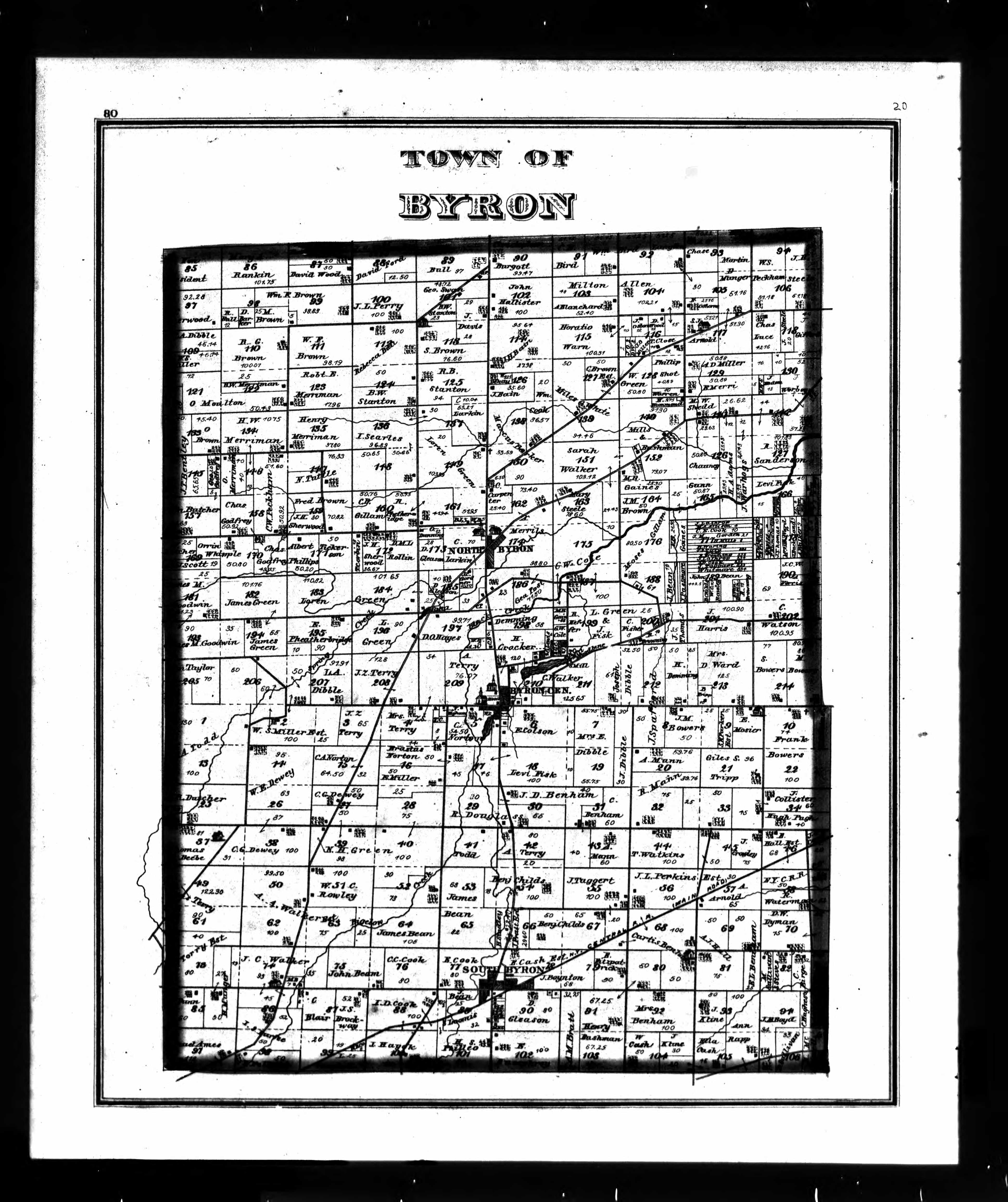 |
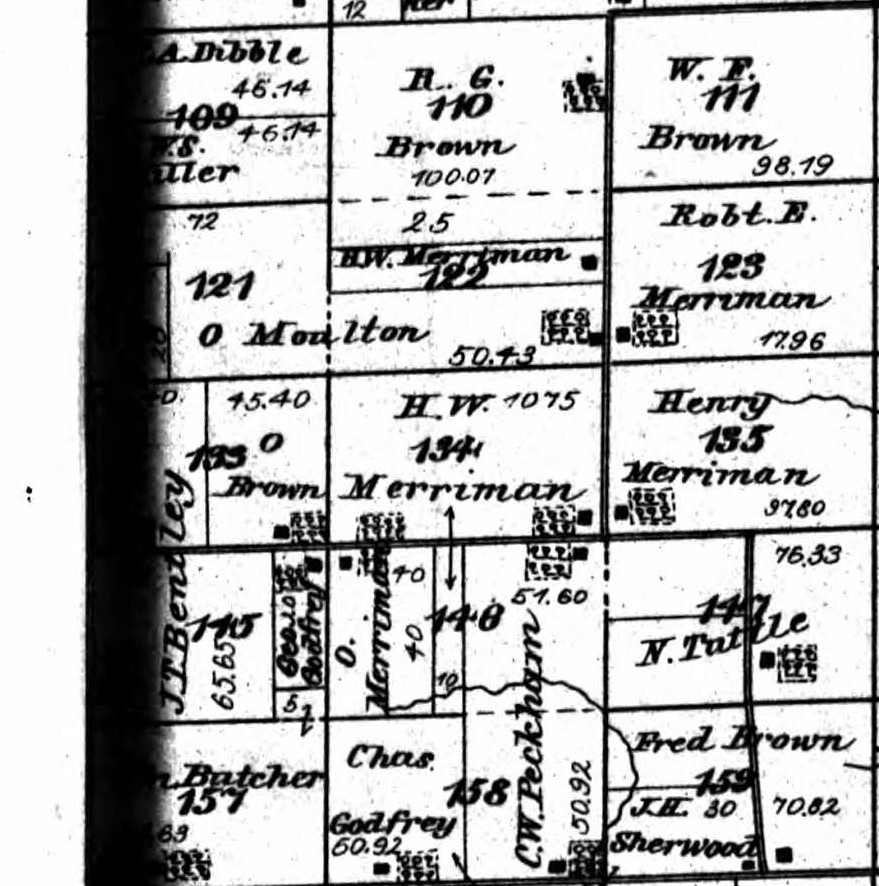 |
O. Brown's land Collection Number: G&M_8; Roll Number: 8; County and Year: Genesee, 1876 |
Source: Ancestry.com. U.S., Indexed County Land Ownership Maps, 1860-1918 [database on-line]. Provo, UT, USA: Ancestry.com Operations, Inc., 2010. Original data: Various publishers of County Land Ownership Atlases. Microfilmed by the Library of Congress, Washington, D.C.
Images of the military records are shown below as thumbnails. Click on each of the thumbnails to view a larger version of the record in another tab.
Grand Army of the Republic Records
Source: New York State Archives; Albany, NY, USA; Grand Army of the Republic Records, 1871-1928; Post Description: Post 007 Descriptive Book. Ancestry.com. New York, Grand Army of the Republic Records, 1866-1931 [database on-line]. Provo, UT, USA: Ancestry.com Operations, Inc., 2013. Original data: Grand Army of the Republic Records, Post Descriptive Books. Series B1706, Sub-Series 11. New York State Archives, Albany, New York.
Civil War Pension Index
Source: The National Archives at Washington, D.C.; Washington, D.C.; Record Group Title: Records of the Department of Veterans Affairs, 1773 - 2007; Record Group Number: 15; Series Title: U.S., Civil War Pension Index: General Index to Pension Files, 1861-1934; Series Number: T288. National Archives and Records Administration. U.S., Civil War Pension Index: General Index to Pension Files, 1861-1934 [database on-line]. Provo, UT, USA: Ancestry.com Operations Inc, 2000. Original data: General Index to Pension Files, 1861-1934. Washington, D.C.: National Archives and Records Administration. T288, 546 rolls.
Indiana Civil War Soldier Database Index
Name: Tristram D. Brown
Birth Year: abt 1836
Age: 25
Enrollment Date: 7 Jun 1861
Discharge Date: 11 Aug 1862
Place: Terre Haute, Indiana
Company: B
Regiment: 14
Notes: Discharged due to wounds.
URL:
https://secure.in.gov/apps/iara/search/Home/Search?RecordSeriesId=3&SeriesCollectionId=39&searchNow=True&defaultCollectionId=&RecordSeriesId=-1&Keywords=&County=All&SeriesCollectionId=0&PhotographTitle=&PhotographSubject=&FirstName=tristram&LastName=brown&CourtType=&CourtDisposition=&StartDate=0&EndDate=0&UseSoundex=false
Source: Ancestry.com. Web: Indiana, Civil War Soldier Database Index,
1861-1865 [database on-line]. Provo, UT, USA: Ancestry.com Operations,
Inc., 2015. Original data: Civil War. Indiana State Digital Archives.
https://secure.in.gov/apps/iara/search/: accessed 2 February 2015.
Images of tax records are shown below as thumbnails. Click on each thumbnail to view a larger version of the record in another tab.
U.S. IRS Tax Assessment Lists
Source: Ancestry.com. U.S. IRS Tax Assessment Lists, 1862-1918 [database on-line]. Provo, UT, USA: Ancestry.com Operations Inc, 2008. Original data: Records of the Internal Revenue Service. Record Group 58. The National Archives at Washington, DC. See Full Source Citations.
Images of immigration records are shown below as thumbnails. Click on each thumbnail to view a larger version of the record in another tab.
New York Passenger and Crew Lists

Passenger list for
the Elizabeth
Arrival: 28 Apr 1849,
New York, New York
Microfilm Serial: M237,
1820-1897; Line: 1;
List Number: 327
Source: Ancestry.com. New York, Passenger and Crew Lists (including Castle Garden and Ellis Island), 1820-1957 [database on-line]. Provo, UT, USA: Ancestry.com Operations, Inc., 2010.
Social Security Applications and Claims Index
Name: Frank Orsmus Brown
Gender: Male
Race: White
Birth Date: 2 Sep 1886
Birth Place: Little Sioux, Iowa
Father: Frank C Brown
Mother: Avis Earll
SSN: 567203088
Notes: Feb 1942: Name listed as FRANK ORSMUS BROWN
Source: Ancestry.com. U.S., Social Security Applications and Claims Index, 1936-2007 [database on-line]. Provo, UT, USA: Ancestry.com Operations, Inc., 2015. Original data: Social Security Applications and Claims, 1936-2007.
Photos are shown below as thumbnails. Click on each thumbnail to view a larger version of the photo in another tab.
Pine Hill Cemetery, Elba, Genesee, New York
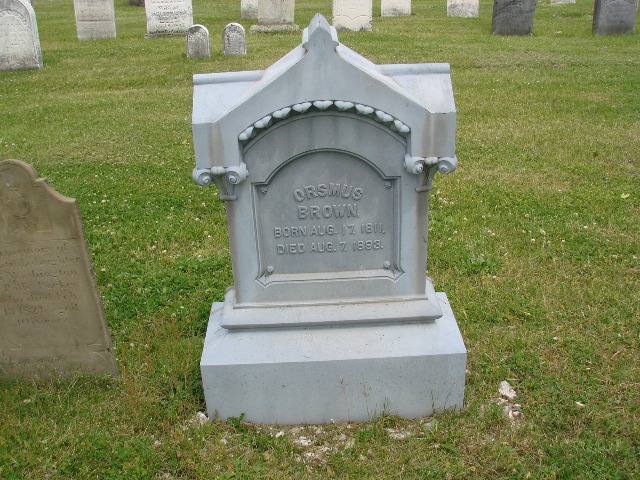
Photo credit:
connie (#47113023),
findagrave.com
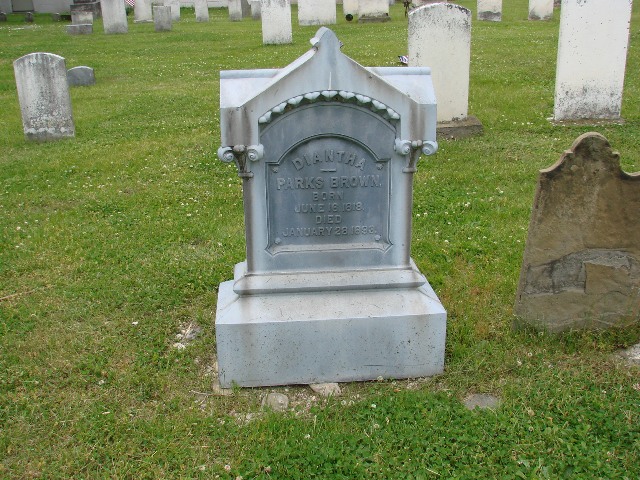
Photo credit:
connie (#47113023),
findagrave.com
PINE HILL CEMETERY
Elba, Genesee County, New York
Old Elba or Old Graveyard or Pioneer Cemetery
SE corner at Main and Chapel, Elba, near Methodist Church, behind fire
hall.
...
Brown
Richard C., s/o Calvin & Nancy, b. 1814, Rome, N. Y., d.
3-16-1875, 61y
Dolly, w/o Richard C., d. 9-17-1846, 60y
Letetia, d/o Richard & Dolly, b. N. Y. State: d. 9-18-1850, 28y
Orsemus, adopted s/o Calvin & Nancy, b. 8-17-1810, Oneida Co., N.
Y.; d. 8-7-1893, 83y
Diantha (Parks), w/o Orsemus, d/o George Washington & Mary Parks;
b. 6-16-1815, Elba; d. 1-28-1893, 77y 7m 12d
Calvin, s/o Richard & Nancy (b. 6-14-1788, Coventry, Tolland CO.,
Conn; d. 4-4-1871, 82y
Nancy, w/o Calvin, b. RI; d. 10-8-1871, 78y
Caroline A., lst w/o J. A. Jr.; b. 12-27-1834, N. Y. State; d.
5-31-1854, 19y 5m 4d
Fidelia L., 2nd w/o J. A. Jr., b. 1814, Rome, N. Y.; d. 5-3-1863, 25y
Source: "Pine Hill Cemetery,"
http://genesee.bettysgenealogy.org/phill.htm, retrieved 24 Apr 2014.
Woodlawn Cemetery, Canandaigua, Ontario, New York
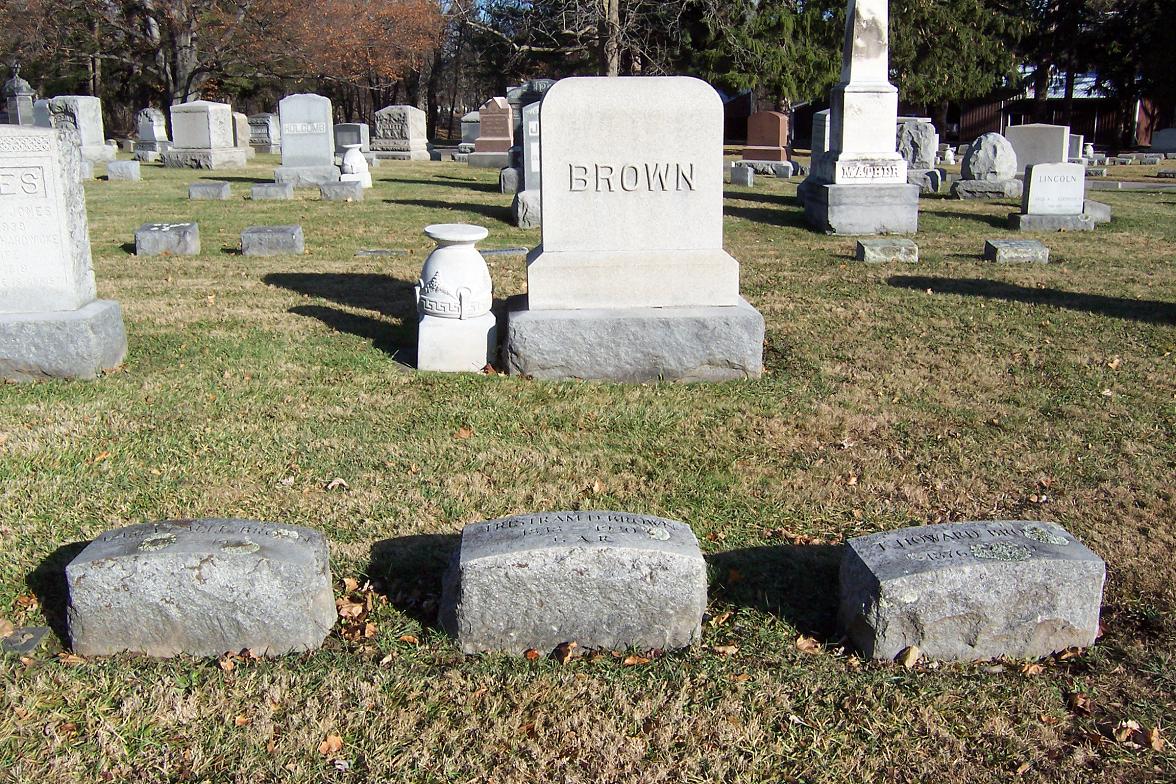
Photo credit:
Charles Natt
Otterson (ID: gone_
fishing - unless_you_
email),
findagrave.com
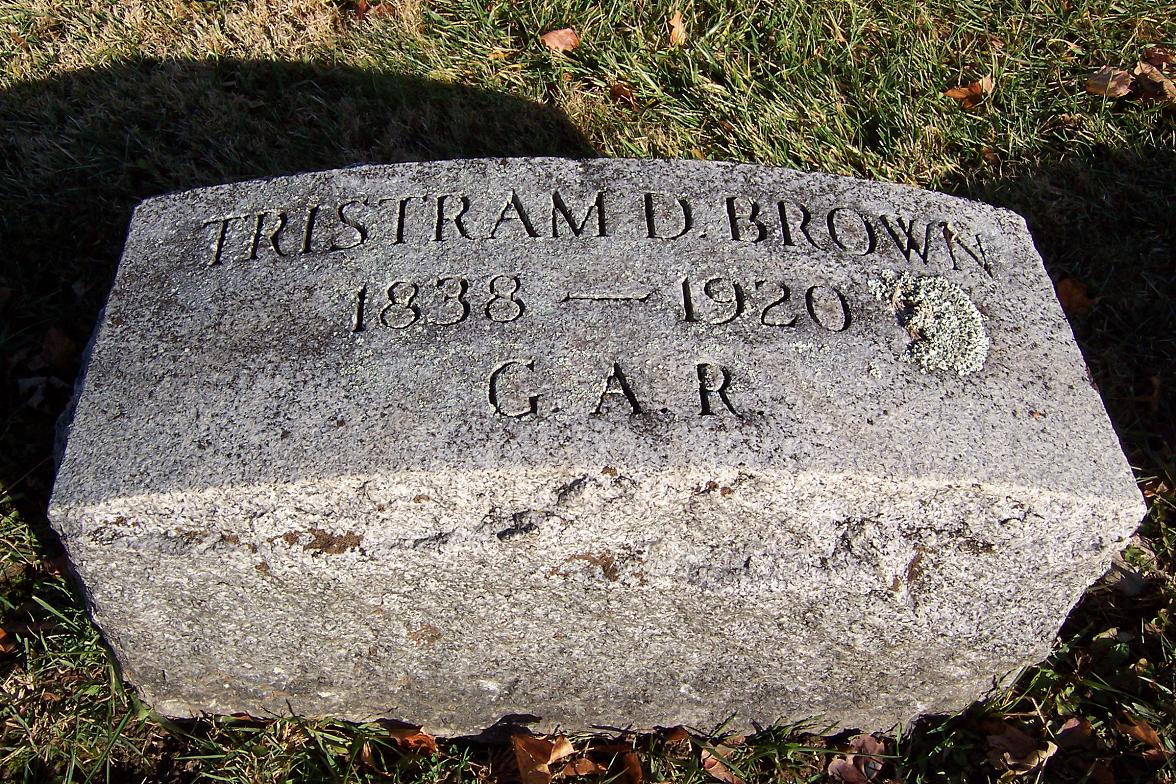
Photo credit:
Otterson (ID: gone_
fishing - unless_you_
email),
findagrave.com
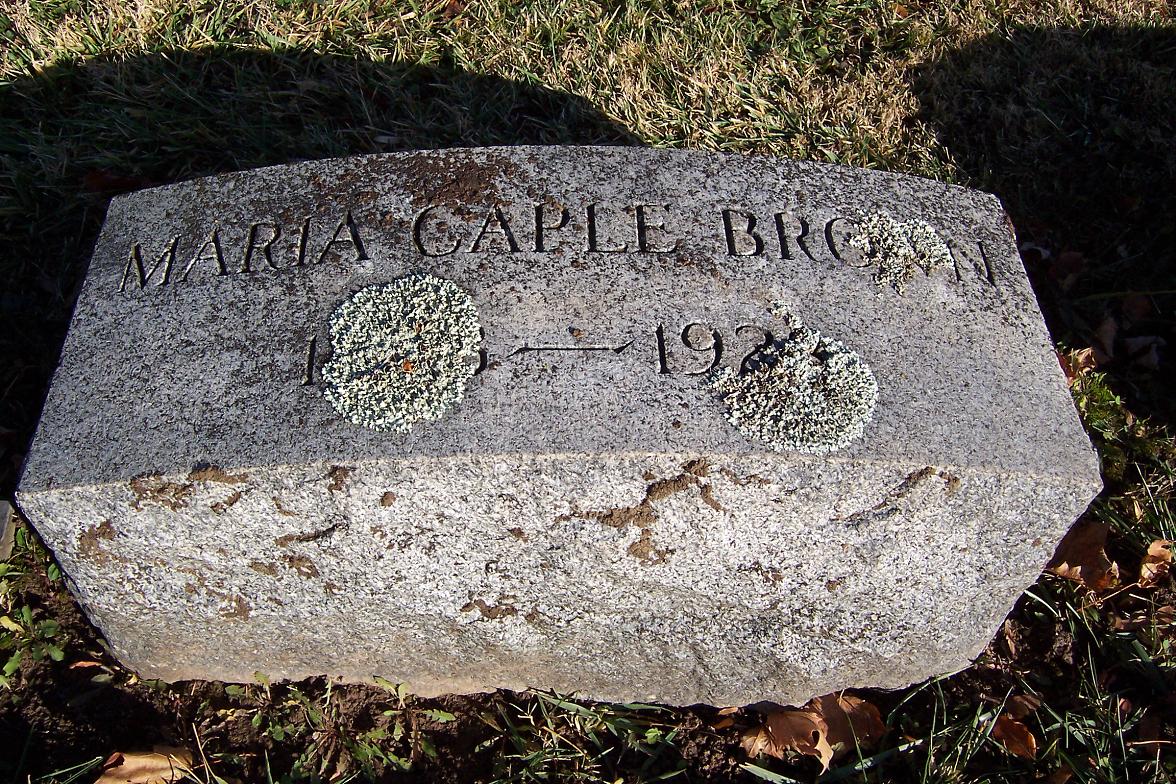
Photo credit:
Otterson (ID: gone_
fishing - unless_you_
email),
findagrave.com
Note: Maria's birth and death dates are obscured in the picture above but is reported in her Findagrave profile as 1843-1928. MB
Forest Hill Cemetery, Attica, Wyoming, New York
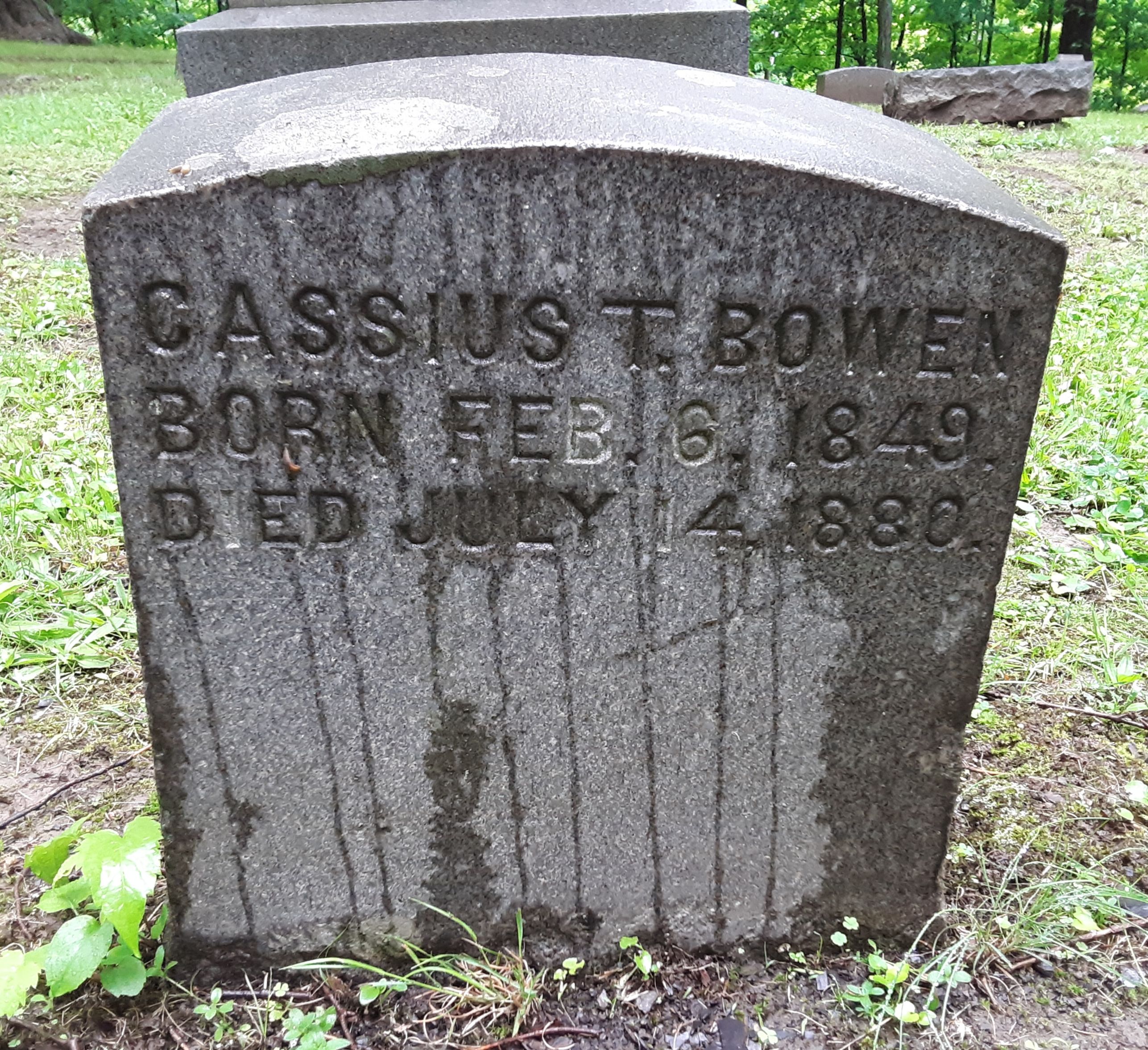
Photo credit:
L. Weber,
findagrave.com
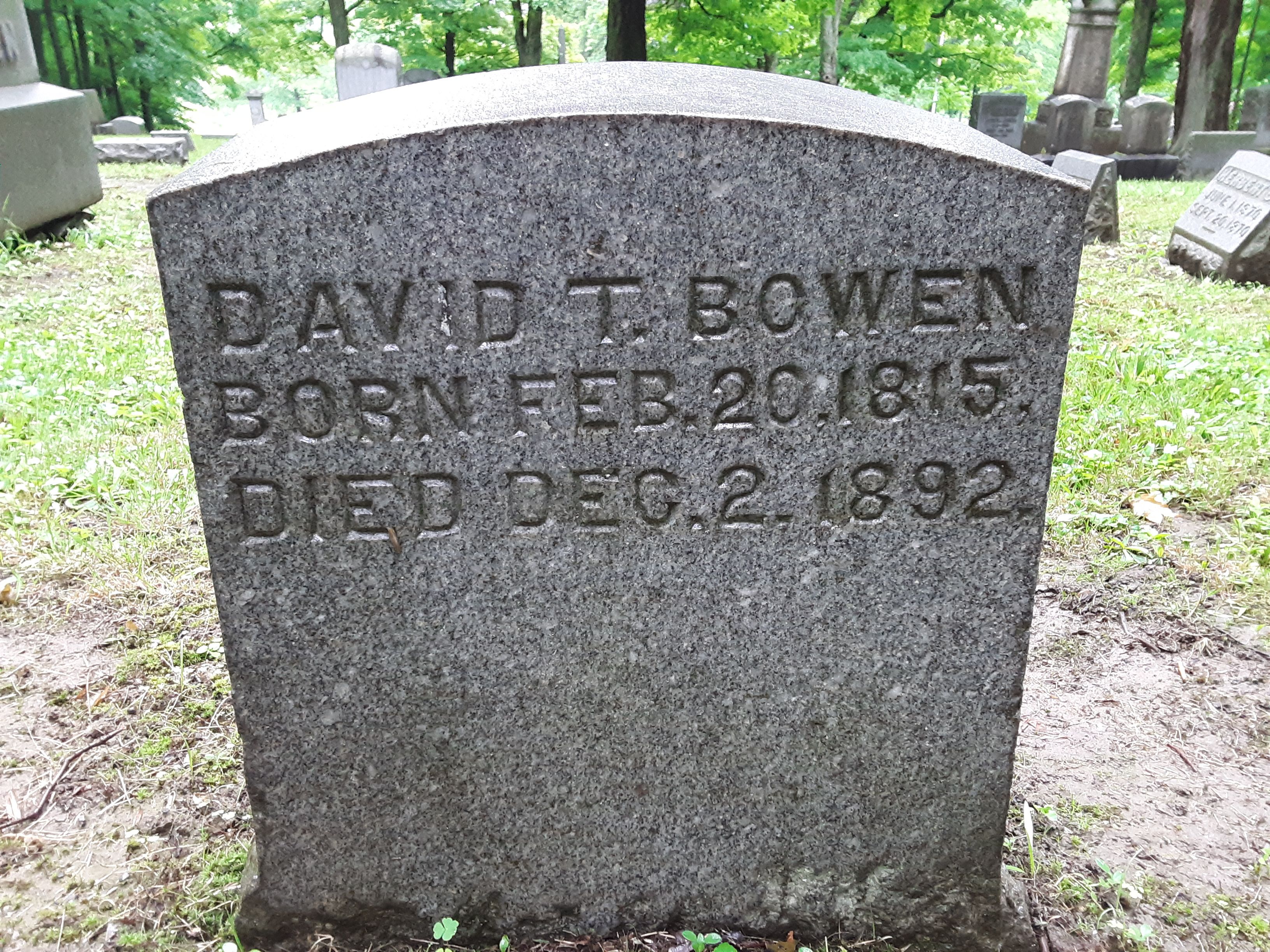
Photo credit:
findagrave.com
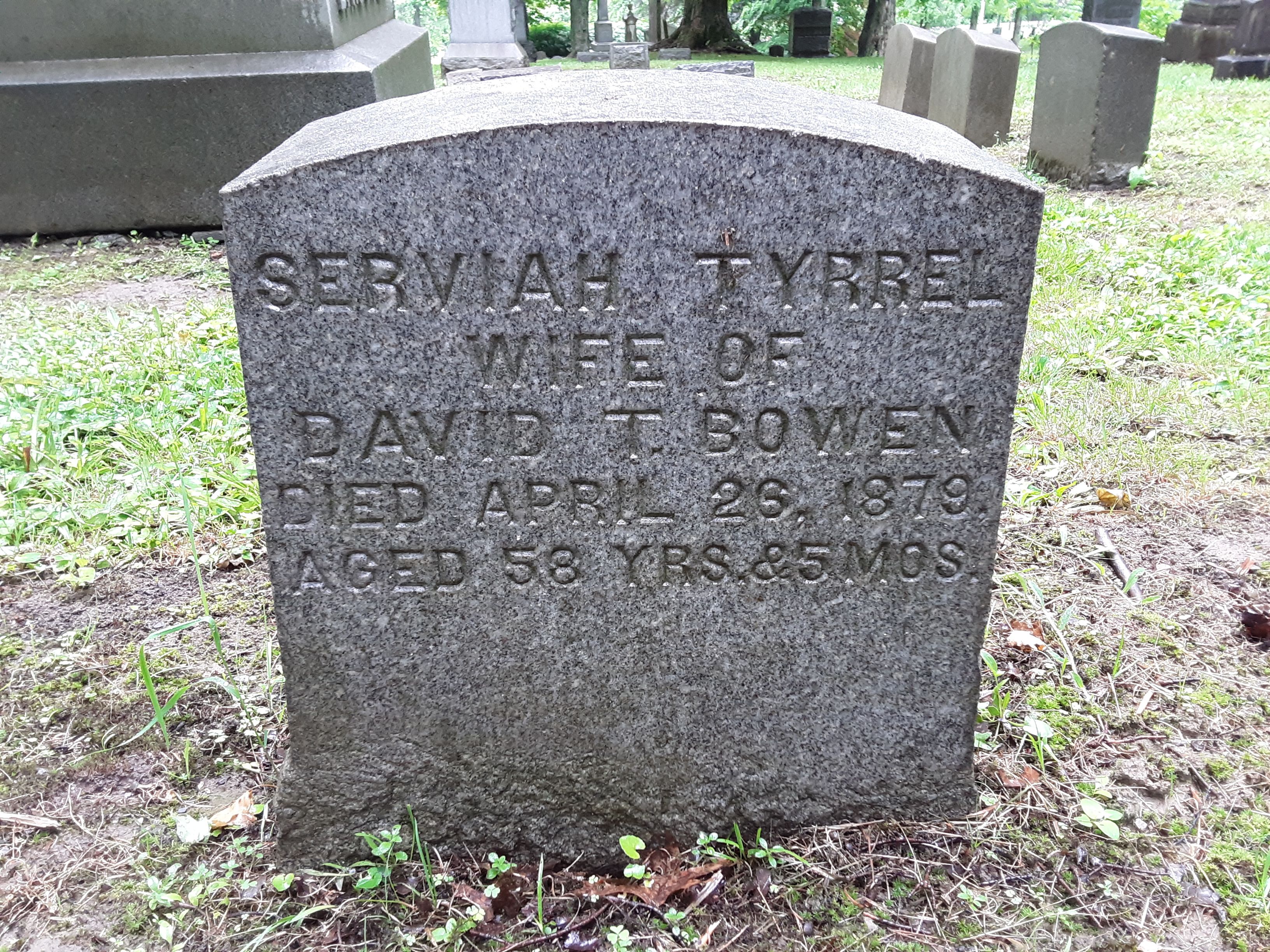
Photo credit:
findagrave.com
Note: Cassius' grave is in the same plot (Plot H) as David T. and Serviah Bowen, along with other Bowens. Cassius appears on censuses with his parents but his mother's name is given variously as Sarah, Sophiah, and Servia. This is indicates that Cassius' mother's name was Serviah.
Banfield Cemetery, Banfield, Barry, Michigan
Sentinel Butte Cemetery, Sentinel Butte, Golden Valley, North Dakota
Orange Hill Cemetery, Tampa, Hillsbourough, Florida
Note: The only other Grozier recorded in this cemetery on Findagrave is a Thomas U. Grozier, submitted by John Keeth, who states, "According to cemetery records Thomas Grozier was 83 at time of death and buried on 8/26/1949. There is no headstone on this grave site."
Return: Home > Ancestry of Bertha Amanda (Brown) Boyd > Brown Family Tree
Author: Michelle A. Boyd
Email
Last updated 27 February 2023
